Z-Altman’s Model Effectiveness in Bank Failure Prediction
VerifiedAdded on 2023/04/21
|46
|11558
|286
AI Summary
This work examines the effectiveness and accuracy of Altman's Z-score model for measuring the financial health of banking sector organizations and its suitability for predicting imminent threats of financial distress in the banking sector.
Contribute Materials
Your contribution can guide someone’s learning journey. Share your
documents today.
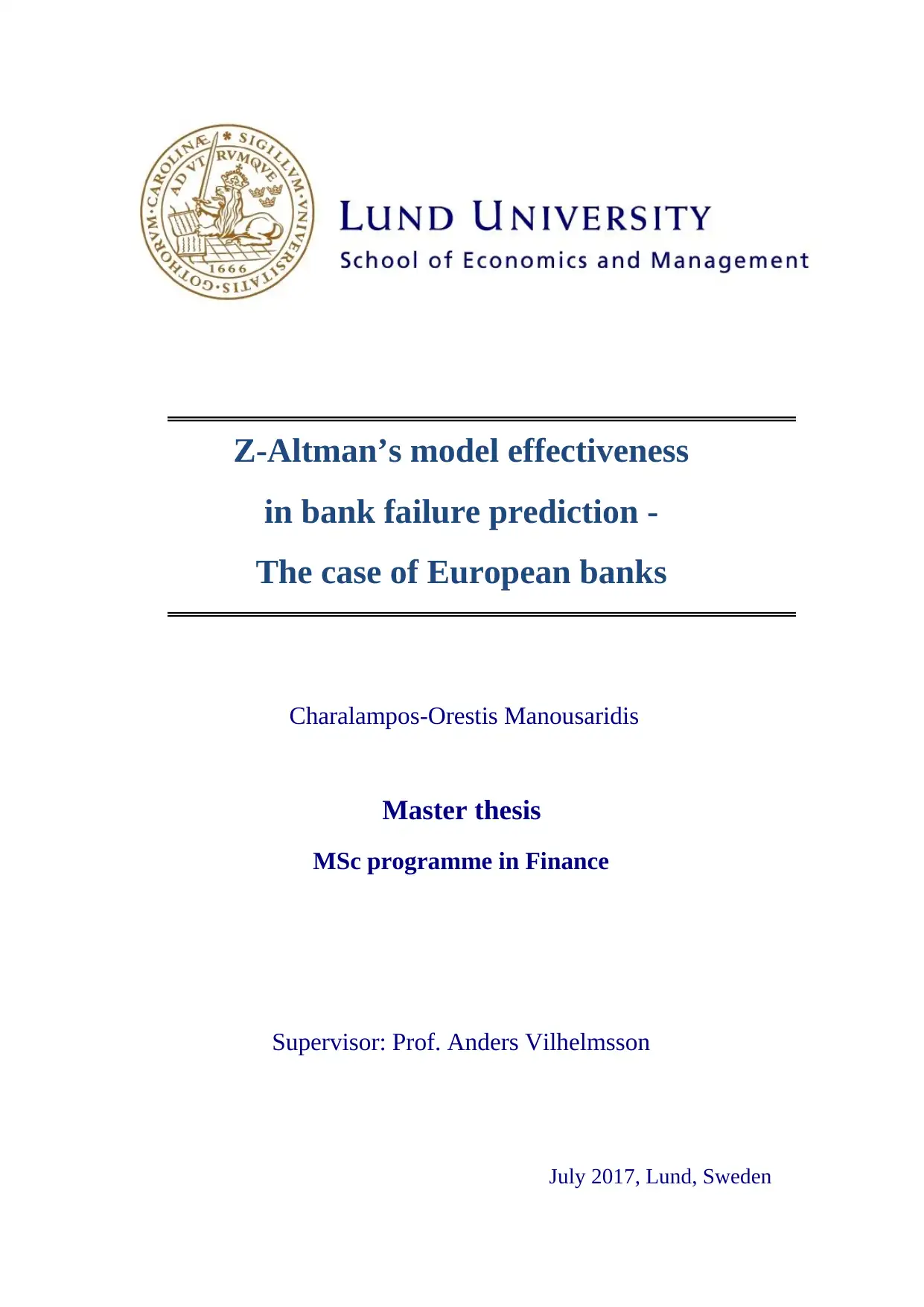
Z-Altman’s model effectiveness
in bank failure prediction -
The case of European banks
Charalampos-Orestis Manousaridis
Master thesis
MSc programme in Finance
Supervisor: Prof. Anders Vilhelmsson
July 2017, Lund, Sweden
in bank failure prediction -
The case of European banks
Charalampos-Orestis Manousaridis
Master thesis
MSc programme in Finance
Supervisor: Prof. Anders Vilhelmsson
July 2017, Lund, Sweden
Secure Best Marks with AI Grader
Need help grading? Try our AI Grader for instant feedback on your assignments.

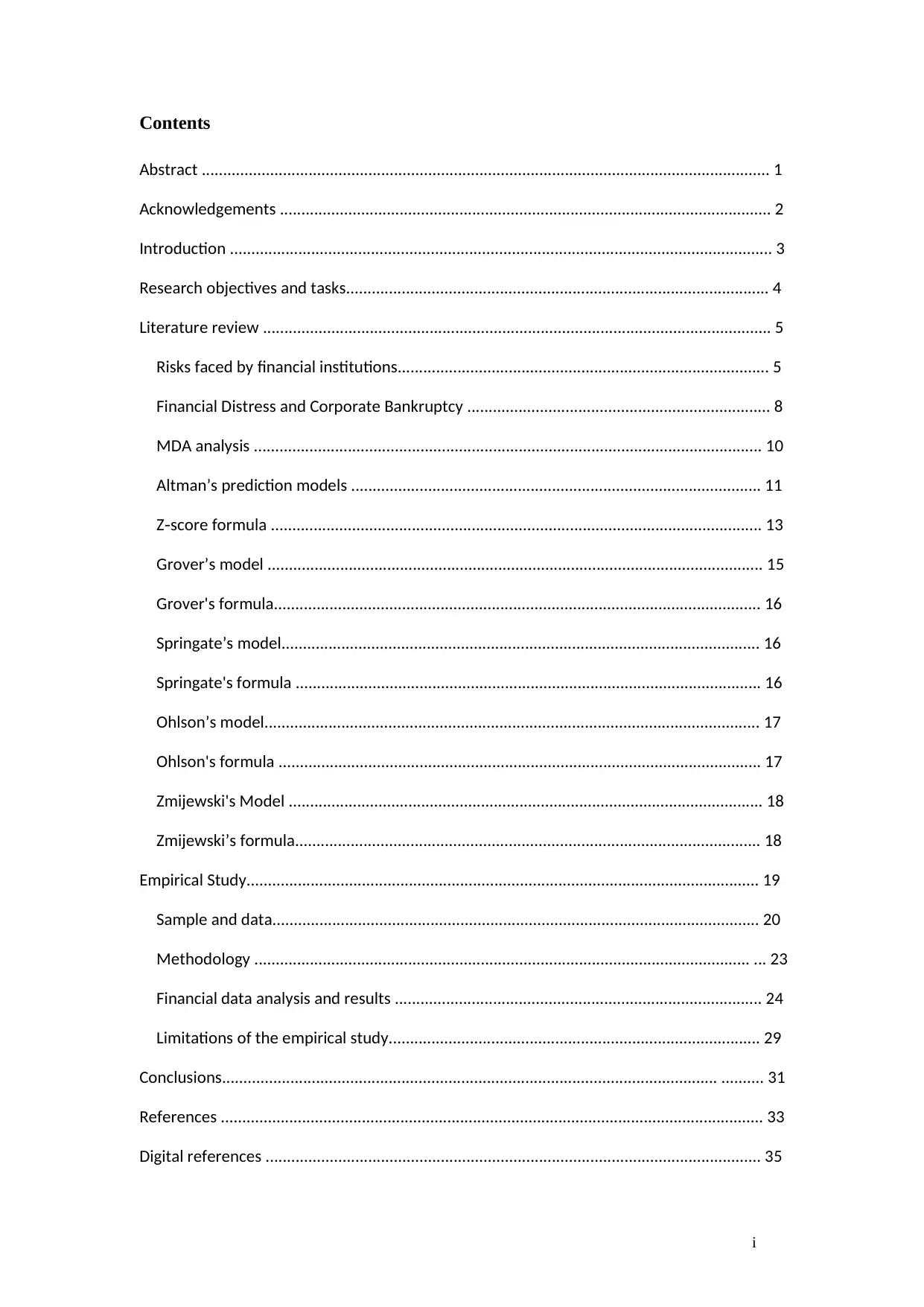
i
Contents
Abstract ..................................................................................................................................... 1
Acknowledgements ................................................................................................................... 2
Introduction ............................................................................................................................... 3
Research objectives and tasks................................................................................................... 4
Literature review ....................................................................................................................... 5
Risks faced by financial institutions....................................................................................... 5
Financial Distress and Corporate Bankruptcy ....................................................................... 8
MDA analysis ....................................................................................................................... 10
Altman’s prediction models ................................................................................................ 11
Z score formula ................................................................................................................... 13‐
Grover’s model .................................................................................................................... 15
Grover's formula.................................................................................................................. 16
Springate’s model................................................................................................................ 16
Springate's formula ............................................................................................................. 16
Ohlson’s model.................................................................................................................... 17
Ohlson's formula ................................................................................................................. 17
Zmijewski's Model ............................................................................................................... 18
Zmijewski’s formula............................................................................................................. 18
Empirical Study........................................................................................................................ 19
Sample and data.................................................................................................................. 20
Methodology .................................................................................................................... ... 23
Financial data analysis and results ...................................................................................... 24
Limitations of the empirical study....................................................................................... 29
Conclusions.................................................................................................................... .......... 31
References ............................................................................................................................... 33
Digital references .................................................................................................................... 35
Contents
Abstract ..................................................................................................................................... 1
Acknowledgements ................................................................................................................... 2
Introduction ............................................................................................................................... 3
Research objectives and tasks................................................................................................... 4
Literature review ....................................................................................................................... 5
Risks faced by financial institutions....................................................................................... 5
Financial Distress and Corporate Bankruptcy ....................................................................... 8
MDA analysis ....................................................................................................................... 10
Altman’s prediction models ................................................................................................ 11
Z score formula ................................................................................................................... 13‐
Grover’s model .................................................................................................................... 15
Grover's formula.................................................................................................................. 16
Springate’s model................................................................................................................ 16
Springate's formula ............................................................................................................. 16
Ohlson’s model.................................................................................................................... 17
Ohlson's formula ................................................................................................................. 17
Zmijewski's Model ............................................................................................................... 18
Zmijewski’s formula............................................................................................................. 18
Empirical Study........................................................................................................................ 19
Sample and data.................................................................................................................. 20
Methodology .................................................................................................................... ... 23
Financial data analysis and results ...................................................................................... 24
Limitations of the empirical study....................................................................................... 29
Conclusions.................................................................................................................... .......... 31
References ............................................................................................................................... 33
Digital references .................................................................................................................... 35

ii
Appendix I Processed data and ratios of failed banks............................................................. 37
Appendix II Processed data and ratios of non failed banks .................................................... 40‐
Appendix I Processed data and ratios of failed banks............................................................. 37
Appendix II Processed data and ratios of non failed banks .................................................... 40‐
Secure Best Marks with AI Grader
Need help grading? Try our AI Grader for instant feedback on your assignments.
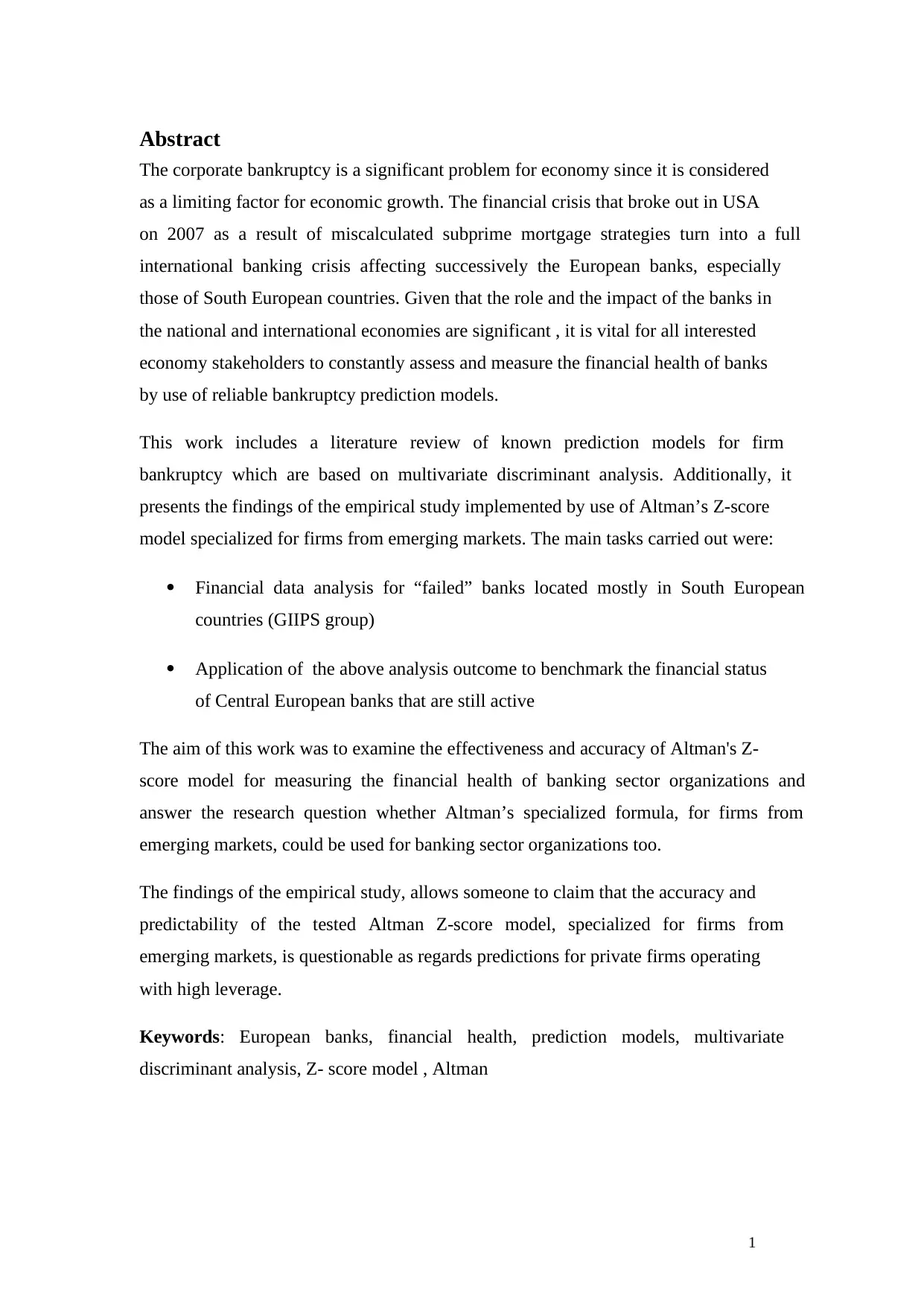
1
Abstract
The corporate bankruptcy is a significant problem for economy since it is considered
as a limiting factor for economic growth. The financial crisis that broke out in USA
on 2007 as a result of miscalculated subprime mortgage strategies turn into a full
international banking crisis affecting successively the European banks, especially
those of South European countries. Given that the role and the impact of the banks in
the national and international economies are significant , it is vital for all interested
economy stakeholders to constantly assess and measure the financial health of banks
by use of reliable bankruptcy prediction models.
This work includes a literature review of known prediction models for firm
bankruptcy which are based on multivariate discriminant analysis. Additionally, it
presents the findings of the empirical study implemented by use of Altman’s Z-score
model specialized for firms from emerging markets. The main tasks carried out were:
Financial data analysis for “failed” banks located mostly in South European
countries (GIIPS group)
Application of the above analysis outcome to benchmark the financial status
of Central European banks that are still active
The aim of this work was to examine the effectiveness and accuracy of Altman's Z-
score model for measuring the financial health of banking sector organizations and
answer the research question whether Altman’s specialized formula, for firms from
emerging markets, could be used for banking sector organizations too.
The findings of the empirical study, allows someone to claim that the accuracy and
predictability of the tested Altman Z-score model, specialized for firms from
emerging markets, is questionable as regards predictions for private firms operating
with high leverage.
Keywords: European banks, financial health, prediction models, multivariate
discriminant analysis, Z- score model , Altman
Abstract
The corporate bankruptcy is a significant problem for economy since it is considered
as a limiting factor for economic growth. The financial crisis that broke out in USA
on 2007 as a result of miscalculated subprime mortgage strategies turn into a full
international banking crisis affecting successively the European banks, especially
those of South European countries. Given that the role and the impact of the banks in
the national and international economies are significant , it is vital for all interested
economy stakeholders to constantly assess and measure the financial health of banks
by use of reliable bankruptcy prediction models.
This work includes a literature review of known prediction models for firm
bankruptcy which are based on multivariate discriminant analysis. Additionally, it
presents the findings of the empirical study implemented by use of Altman’s Z-score
model specialized for firms from emerging markets. The main tasks carried out were:
Financial data analysis for “failed” banks located mostly in South European
countries (GIIPS group)
Application of the above analysis outcome to benchmark the financial status
of Central European banks that are still active
The aim of this work was to examine the effectiveness and accuracy of Altman's Z-
score model for measuring the financial health of banking sector organizations and
answer the research question whether Altman’s specialized formula, for firms from
emerging markets, could be used for banking sector organizations too.
The findings of the empirical study, allows someone to claim that the accuracy and
predictability of the tested Altman Z-score model, specialized for firms from
emerging markets, is questionable as regards predictions for private firms operating
with high leverage.
Keywords: European banks, financial health, prediction models, multivariate
discriminant analysis, Z- score model , Altman
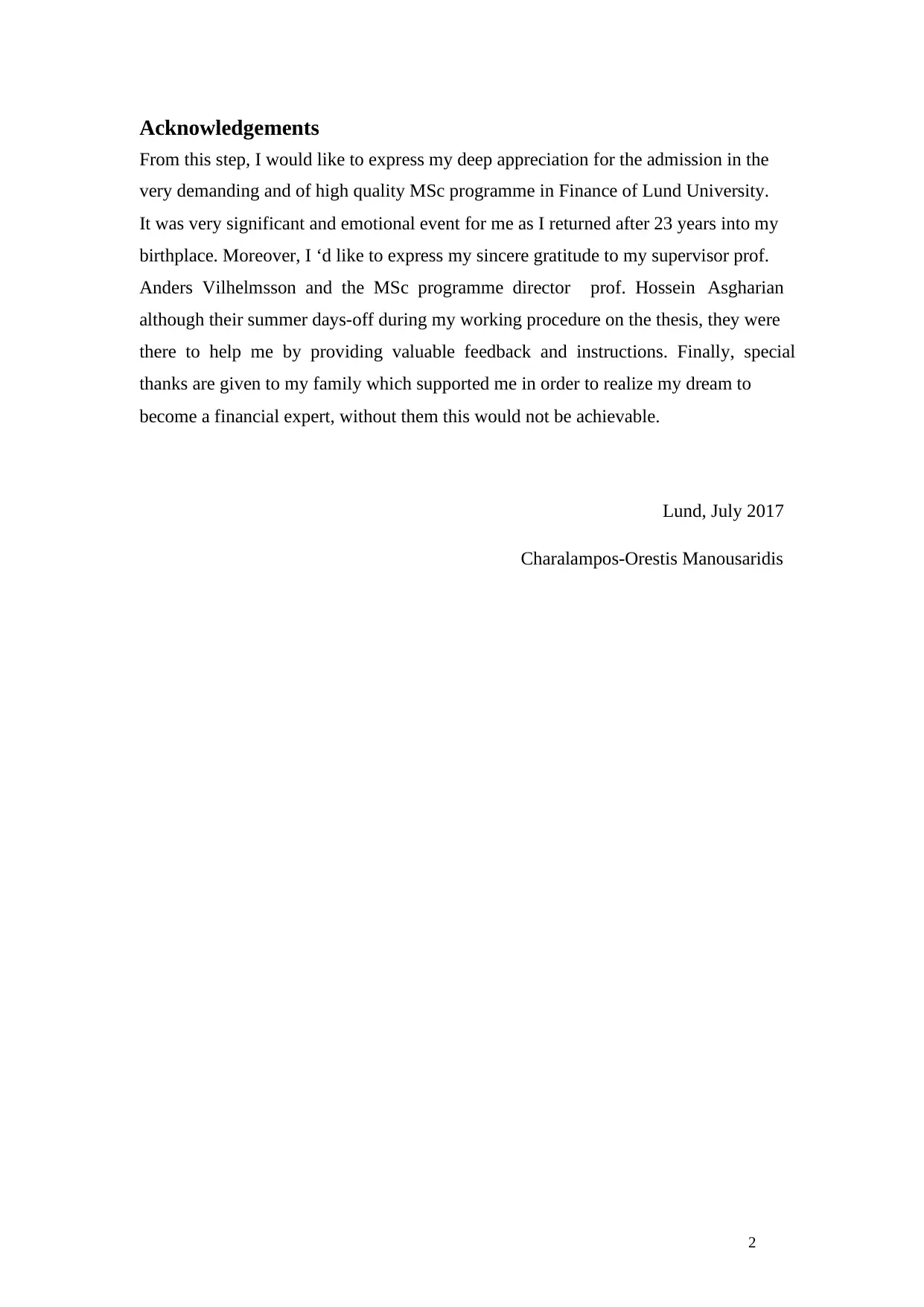
2
Acknowledgements
From this step, I would like to express my deep appreciation for the admission in the
very demanding and of high quality MSc programme in Finance of Lund University.
It was very significant and emotional event for me as I returned after 23 years into my
birthplace. Moreover, I ‘d like to express my sincere gratitude to my supervisor prof.
Anders Vilhelmsson and the MSc programme director prof. Hossein Asgharian
although their summer days-off during my working procedure on the thesis, they were
there to help me by providing valuable feedback and instructions. Finally, special
thanks are given to my family which supported me in order to realize my dream to
become a financial expert, without them this would not be achievable.
Lund, July 2017
Charalampos-Orestis Manousaridis
Acknowledgements
From this step, I would like to express my deep appreciation for the admission in the
very demanding and of high quality MSc programme in Finance of Lund University.
It was very significant and emotional event for me as I returned after 23 years into my
birthplace. Moreover, I ‘d like to express my sincere gratitude to my supervisor prof.
Anders Vilhelmsson and the MSc programme director prof. Hossein Asgharian
although their summer days-off during my working procedure on the thesis, they were
there to help me by providing valuable feedback and instructions. Finally, special
thanks are given to my family which supported me in order to realize my dream to
become a financial expert, without them this would not be achievable.
Lund, July 2017
Charalampos-Orestis Manousaridis
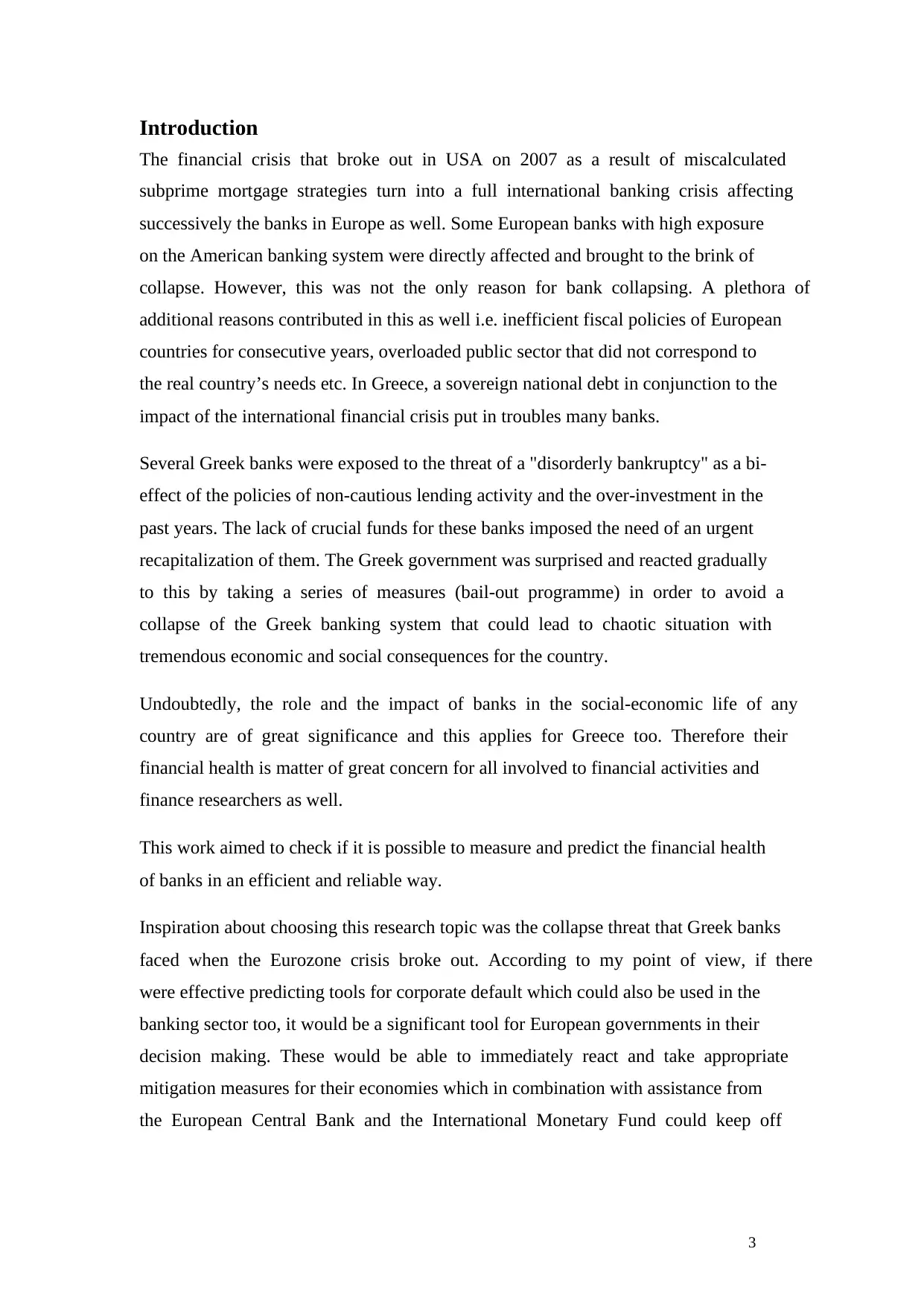
3
Introduction
The financial crisis that broke out in USA on 2007 as a result of miscalculated
subprime mortgage strategies turn into a full international banking crisis affecting
successively the banks in Europe as well. Some European banks with high exposure
on the American banking system were directly affected and brought to the brink of
collapse. However, this was not the only reason for bank collapsing. A plethora of
additional reasons contributed in this as well i.e. inefficient fiscal policies of European
countries for consecutive years, overloaded public sector that did not correspond to
the real country’s needs etc. In Greece, a sovereign national debt in conjunction to the
impact of the international financial crisis put in troubles many banks.
Several Greek banks were exposed to the threat of a "disorderly bankruptcy" as a bi-
effect of the policies of non-cautious lending activity and the over-investment in the
past years. The lack of crucial funds for these banks imposed the need of an urgent
recapitalization of them. The Greek government was surprised and reacted gradually
to this by taking a series of measures (bail-out programme) in order to avoid a
collapse of the Greek banking system that could lead to chaotic situation with
tremendous economic and social consequences for the country.
Undoubtedly, the role and the impact of banks in the social-economic life of any
country are of great significance and this applies for Greece too. Therefore their
financial health is matter of great concern for all involved to financial activities and
finance researchers as well.
This work aimed to check if it is possible to measure and predict the financial health
of banks in an efficient and reliable way.
Inspiration about choosing this research topic was the collapse threat that Greek banks
faced when the Eurozone crisis broke out. According to my point of view, if there
were effective predicting tools for corporate default which could also be used in the
banking sector too, it would be a significant tool for European governments in their
decision making. These would be able to immediately react and take appropriate
mitigation measures for their economies which in combination with assistance from
the European Central Bank and the International Monetary Fund could keep off
Introduction
The financial crisis that broke out in USA on 2007 as a result of miscalculated
subprime mortgage strategies turn into a full international banking crisis affecting
successively the banks in Europe as well. Some European banks with high exposure
on the American banking system were directly affected and brought to the brink of
collapse. However, this was not the only reason for bank collapsing. A plethora of
additional reasons contributed in this as well i.e. inefficient fiscal policies of European
countries for consecutive years, overloaded public sector that did not correspond to
the real country’s needs etc. In Greece, a sovereign national debt in conjunction to the
impact of the international financial crisis put in troubles many banks.
Several Greek banks were exposed to the threat of a "disorderly bankruptcy" as a bi-
effect of the policies of non-cautious lending activity and the over-investment in the
past years. The lack of crucial funds for these banks imposed the need of an urgent
recapitalization of them. The Greek government was surprised and reacted gradually
to this by taking a series of measures (bail-out programme) in order to avoid a
collapse of the Greek banking system that could lead to chaotic situation with
tremendous economic and social consequences for the country.
Undoubtedly, the role and the impact of banks in the social-economic life of any
country are of great significance and this applies for Greece too. Therefore their
financial health is matter of great concern for all involved to financial activities and
finance researchers as well.
This work aimed to check if it is possible to measure and predict the financial health
of banks in an efficient and reliable way.
Inspiration about choosing this research topic was the collapse threat that Greek banks
faced when the Eurozone crisis broke out. According to my point of view, if there
were effective predicting tools for corporate default which could also be used in the
banking sector too, it would be a significant tool for European governments in their
decision making. These would be able to immediately react and take appropriate
mitigation measures for their economies which in combination with assistance from
the European Central Bank and the International Monetary Fund could keep off
Paraphrase This Document
Need a fresh take? Get an instant paraphrase of this document with our AI Paraphraser
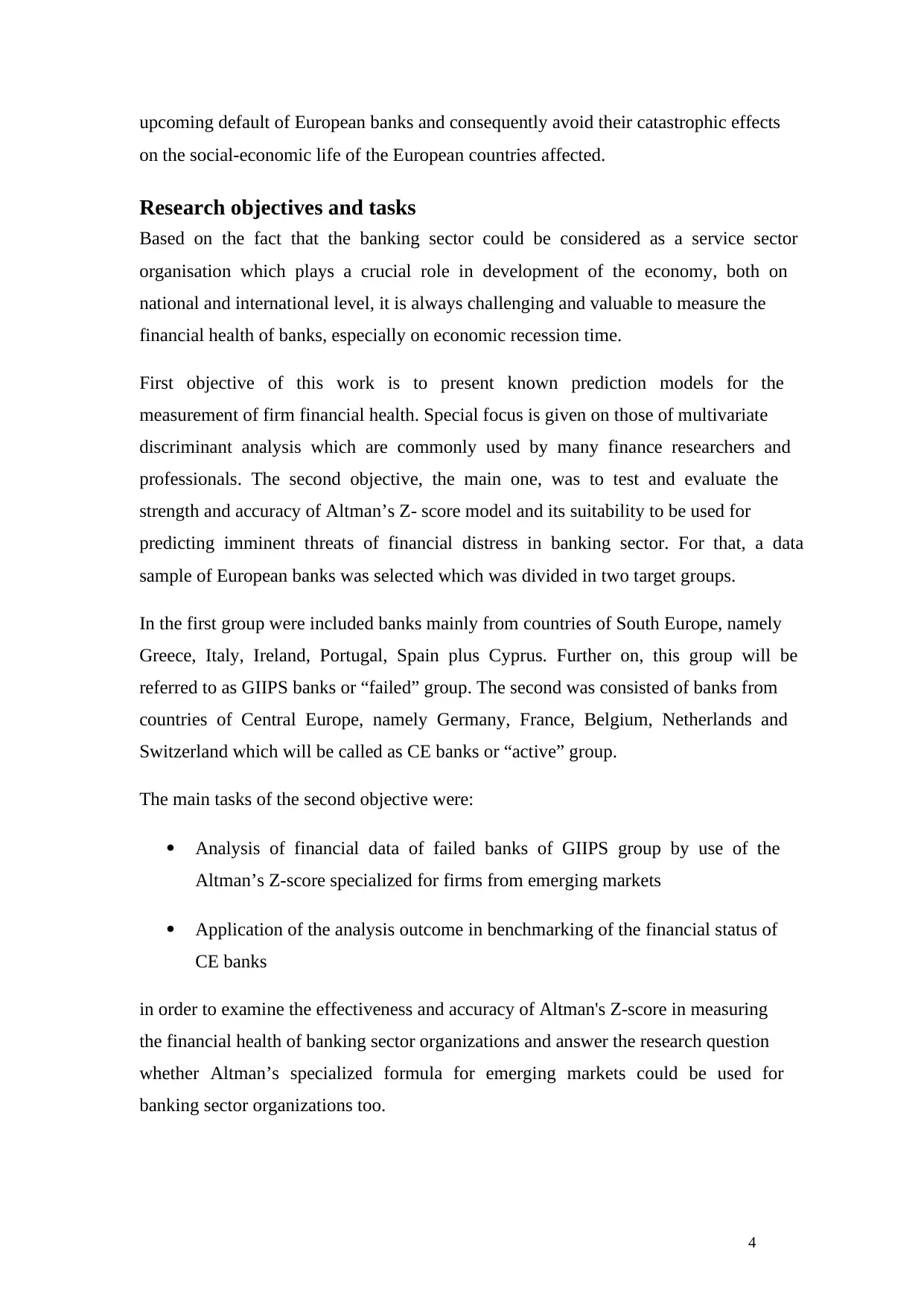
4
upcoming default of European banks and consequently avoid their catastrophic effects
on the social-economic life of the European countries affected.
Research objectives and tasks
Based on the fact that the banking sector could be considered as a service sector
organisation which plays a crucial role in development of the economy, both on
national and international level, it is always challenging and valuable to measure the
financial health of banks, especially on economic recession time.
First objective of this work is to present known prediction models for the
measurement of firm financial health. Special focus is given on those of multivariate
discriminant analysis which are commonly used by many finance researchers and
professionals. The second objective, the main one, was to test and evaluate the
strength and accuracy of Altman’s Z- score model and its suitability to be used for
predicting imminent threats of financial distress in banking sector. For that, a data
sample of European banks was selected which was divided in two target groups.
In the first group were included banks mainly from countries of South Europe, namely
Greece, Italy, Ireland, Portugal, Spain plus Cyprus. Further on, this group will be
referred to as GIIPS banks or “failed” group. The second was consisted of banks from
countries of Central Europe, namely Germany, France, Belgium, Netherlands and
Switzerland which will be called as CE banks or “active” group.
The main tasks of the second objective were:
Analysis of financial data of failed banks of GIIPS group by use of the
Altman’s Z-score specialized for firms from emerging markets
Application of the analysis outcome in benchmarking of the financial status of
CE banks
in order to examine the effectiveness and accuracy of Altman's Z-score in measuring
the financial health of banking sector organizations and answer the research question
whether Altman’s specialized formula for emerging markets could be used for
banking sector organizations too.
upcoming default of European banks and consequently avoid their catastrophic effects
on the social-economic life of the European countries affected.
Research objectives and tasks
Based on the fact that the banking sector could be considered as a service sector
organisation which plays a crucial role in development of the economy, both on
national and international level, it is always challenging and valuable to measure the
financial health of banks, especially on economic recession time.
First objective of this work is to present known prediction models for the
measurement of firm financial health. Special focus is given on those of multivariate
discriminant analysis which are commonly used by many finance researchers and
professionals. The second objective, the main one, was to test and evaluate the
strength and accuracy of Altman’s Z- score model and its suitability to be used for
predicting imminent threats of financial distress in banking sector. For that, a data
sample of European banks was selected which was divided in two target groups.
In the first group were included banks mainly from countries of South Europe, namely
Greece, Italy, Ireland, Portugal, Spain plus Cyprus. Further on, this group will be
referred to as GIIPS banks or “failed” group. The second was consisted of banks from
countries of Central Europe, namely Germany, France, Belgium, Netherlands and
Switzerland which will be called as CE banks or “active” group.
The main tasks of the second objective were:
Analysis of financial data of failed banks of GIIPS group by use of the
Altman’s Z-score specialized for firms from emerging markets
Application of the analysis outcome in benchmarking of the financial status of
CE banks
in order to examine the effectiveness and accuracy of Altman's Z-score in measuring
the financial health of banking sector organizations and answer the research question
whether Altman’s specialized formula for emerging markets could be used for
banking sector organizations too.
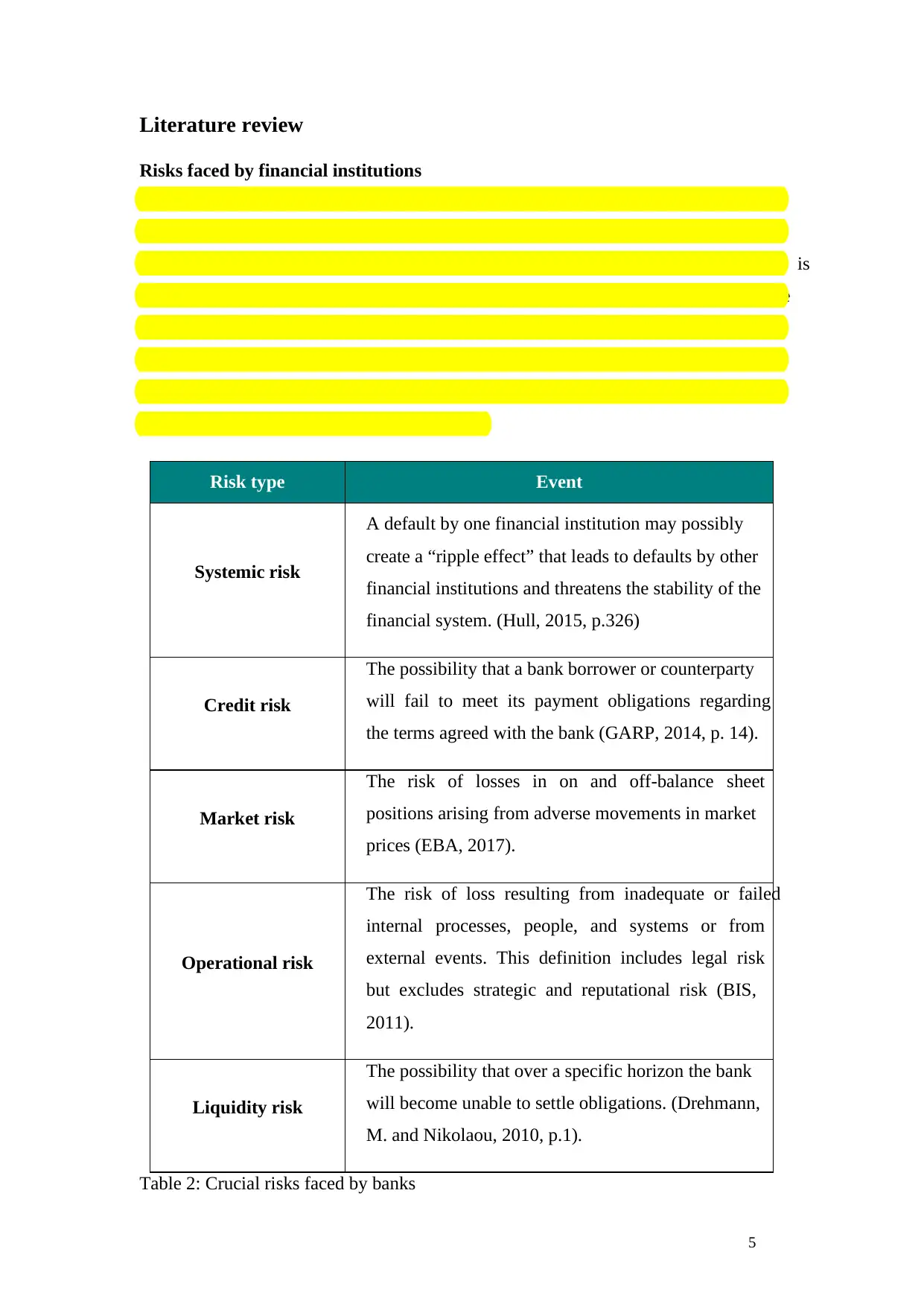
5
Literature review
Risks faced by financial institutions
According to organisation theory, any organisation is confronted with many different
risks during its whole life. Financial institutions are characterized as organizations of
the service sector. Their role and impact in the social-economic life of countries is
significant and multifarious. They are evolved in different financial activities like
lending, asset management, deposit keeping etc. which means that these are exposed
to different kind of risks explained below. The financial health of banks reflects to the
economy of a country and in some cases of the whole world. The most crucial risks
faced by banks are outlined in the below table:
Risk type Event
Systemic risk
A default by one financial institution may possibly
create a “ripple effect” that leads to defaults by other
financial institutions and threatens the stability of the
financial system. (Hull, 2015, p.326)
Credit risk
The possibility that a bank borrower or counterparty
will fail to meet its payment obligations regarding
the terms agreed with the bank (GARP, 2014, p. 14).
Market risk
The risk of losses in on and off-balance sheet
positions arising from adverse movements in market
prices (EBA, 2017).
Operational risk
The risk of loss resulting from inadequate or failed
internal processes, people, and systems or from
external events. This definition includes legal risk
but excludes strategic and reputational risk (BIS,
2011).
Liquidity risk
The possibility that over a specific horizon the bank
will become unable to settle obligations. (Drehmann,
M. and Nikolaou, 2010, p.1).
Table 2: Crucial risks faced by banks
Literature review
Risks faced by financial institutions
According to organisation theory, any organisation is confronted with many different
risks during its whole life. Financial institutions are characterized as organizations of
the service sector. Their role and impact in the social-economic life of countries is
significant and multifarious. They are evolved in different financial activities like
lending, asset management, deposit keeping etc. which means that these are exposed
to different kind of risks explained below. The financial health of banks reflects to the
economy of a country and in some cases of the whole world. The most crucial risks
faced by banks are outlined in the below table:
Risk type Event
Systemic risk
A default by one financial institution may possibly
create a “ripple effect” that leads to defaults by other
financial institutions and threatens the stability of the
financial system. (Hull, 2015, p.326)
Credit risk
The possibility that a bank borrower or counterparty
will fail to meet its payment obligations regarding
the terms agreed with the bank (GARP, 2014, p. 14).
Market risk
The risk of losses in on and off-balance sheet
positions arising from adverse movements in market
prices (EBA, 2017).
Operational risk
The risk of loss resulting from inadequate or failed
internal processes, people, and systems or from
external events. This definition includes legal risk
but excludes strategic and reputational risk (BIS,
2011).
Liquidity risk
The possibility that over a specific horizon the bank
will become unable to settle obligations. (Drehmann,
M. and Nikolaou, 2010, p.1).
Table 2: Crucial risks faced by banks
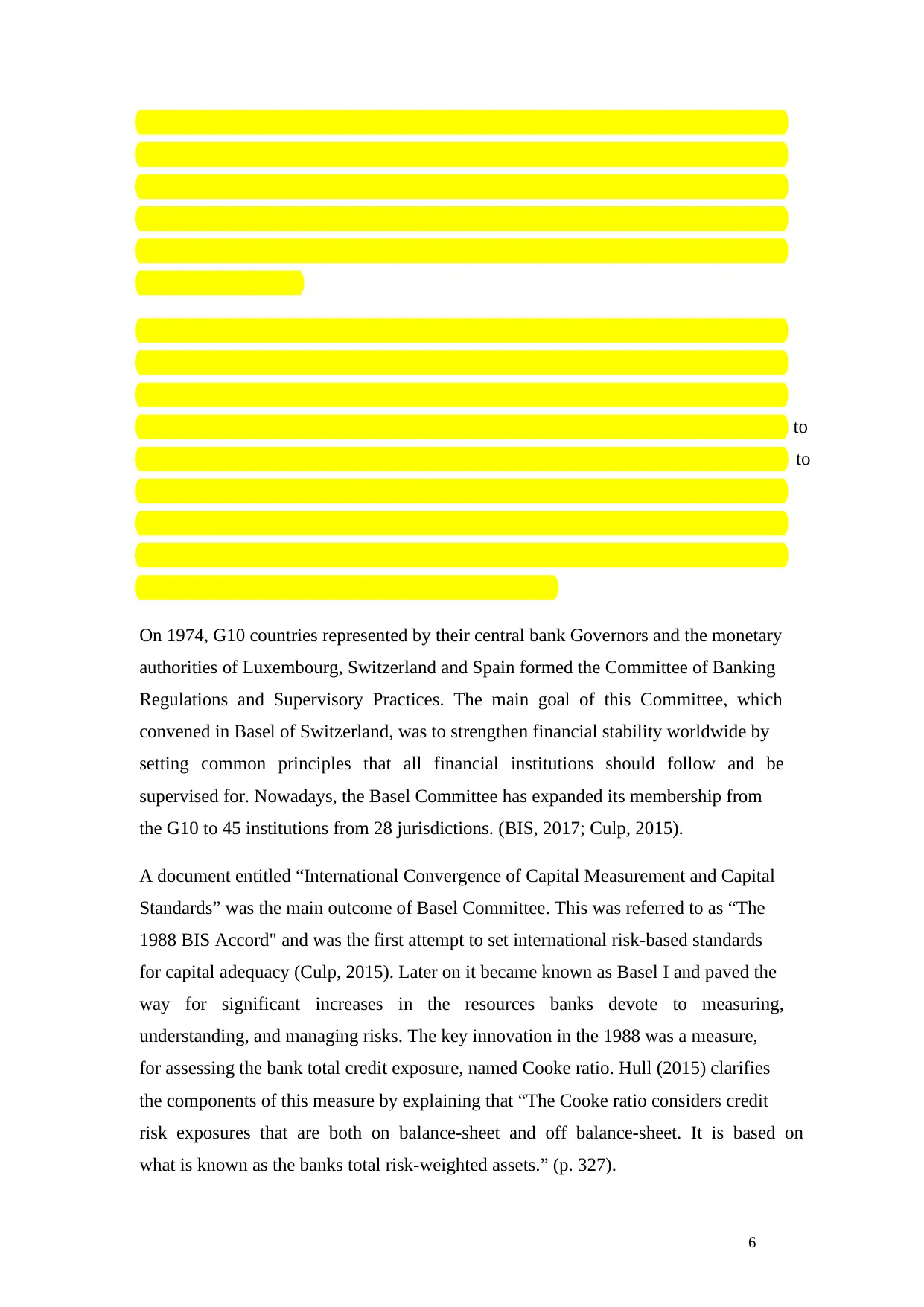
6
When a bank cannot repay and meet its economic obligations to its investors, lenders
and generally to its stakeholders then reaches a default situation or in other words it
becomes in a ‘failed condition”. If corrective measures are not taken or are incorrect
then the bank's problematic situation can result to a disorderly bankruptcy with
chaotic consequences in every aspect of the social-economic life of the country that
the bank is operating.
In order to predict and avoid bank failure situations and their subsequent economic
disaster a regulatory framework for banking sector was necessary to be established.
Hull (2015) pointed out the importance of regulations in order to avoid bank failing.
He justified this need and explained that “…main purpose of bank regulation is to
ensure that a bank keeps enough capital for the risks it takes. It is not possible to
eliminate altogether the possibility of a bank failing, but governments want to make
the probability of default for any given bank very small. By doing this, they want to
create a stable economic environment where private individuals and businesses have
confidence in the banking system” (Hull, 2015, p. 325).
On 1974, G10 countries represented by their central bank Governors and the monetary
authorities of Luxembourg, Switzerland and Spain formed the Committee of Banking
Regulations and Supervisory Practices. The main goal of this Committee, which
convened in Basel of Switzerland, was to strengthen financial stability worldwide by
setting common principles that all financial institutions should follow and be
supervised for. Nowadays, the Basel Committee has expanded its membership from
the G10 to 45 institutions from 28 jurisdictions. (BIS, 2017; Culp, 2015).
A document entitled “International Convergence of Capital Measurement and Capital
Standards” was the main outcome of Basel Committee. This was referred to as “The
1988 BIS Accord" and was the first attempt to set international risk-based standards
for capital adequacy (Culp, 2015). Later on it became known as Basel I and paved the
way for significant increases in the resources banks devote to measuring,
understanding, and managing risks. The key innovation in the 1988 was a measure,
for assessing the bank total credit exposure, named Cooke ratio. Hull (2015) clarifies
the components of this measure by explaining that “The Cooke ratio considers credit
risk exposures that are both on balance-sheet and off balance-sheet. It is based on
what is known as the banks total risk-weighted assets.” (p. 327).
When a bank cannot repay and meet its economic obligations to its investors, lenders
and generally to its stakeholders then reaches a default situation or in other words it
becomes in a ‘failed condition”. If corrective measures are not taken or are incorrect
then the bank's problematic situation can result to a disorderly bankruptcy with
chaotic consequences in every aspect of the social-economic life of the country that
the bank is operating.
In order to predict and avoid bank failure situations and their subsequent economic
disaster a regulatory framework for banking sector was necessary to be established.
Hull (2015) pointed out the importance of regulations in order to avoid bank failing.
He justified this need and explained that “…main purpose of bank regulation is to
ensure that a bank keeps enough capital for the risks it takes. It is not possible to
eliminate altogether the possibility of a bank failing, but governments want to make
the probability of default for any given bank very small. By doing this, they want to
create a stable economic environment where private individuals and businesses have
confidence in the banking system” (Hull, 2015, p. 325).
On 1974, G10 countries represented by their central bank Governors and the monetary
authorities of Luxembourg, Switzerland and Spain formed the Committee of Banking
Regulations and Supervisory Practices. The main goal of this Committee, which
convened in Basel of Switzerland, was to strengthen financial stability worldwide by
setting common principles that all financial institutions should follow and be
supervised for. Nowadays, the Basel Committee has expanded its membership from
the G10 to 45 institutions from 28 jurisdictions. (BIS, 2017; Culp, 2015).
A document entitled “International Convergence of Capital Measurement and Capital
Standards” was the main outcome of Basel Committee. This was referred to as “The
1988 BIS Accord" and was the first attempt to set international risk-based standards
for capital adequacy (Culp, 2015). Later on it became known as Basel I and paved the
way for significant increases in the resources banks devote to measuring,
understanding, and managing risks. The key innovation in the 1988 was a measure,
for assessing the bank total credit exposure, named Cooke ratio. Hull (2015) clarifies
the components of this measure by explaining that “The Cooke ratio considers credit
risk exposures that are both on balance-sheet and off balance-sheet. It is based on
what is known as the banks total risk-weighted assets.” (p. 327).
Secure Best Marks with AI Grader
Need help grading? Try our AI Grader for instant feedback on your assignments.
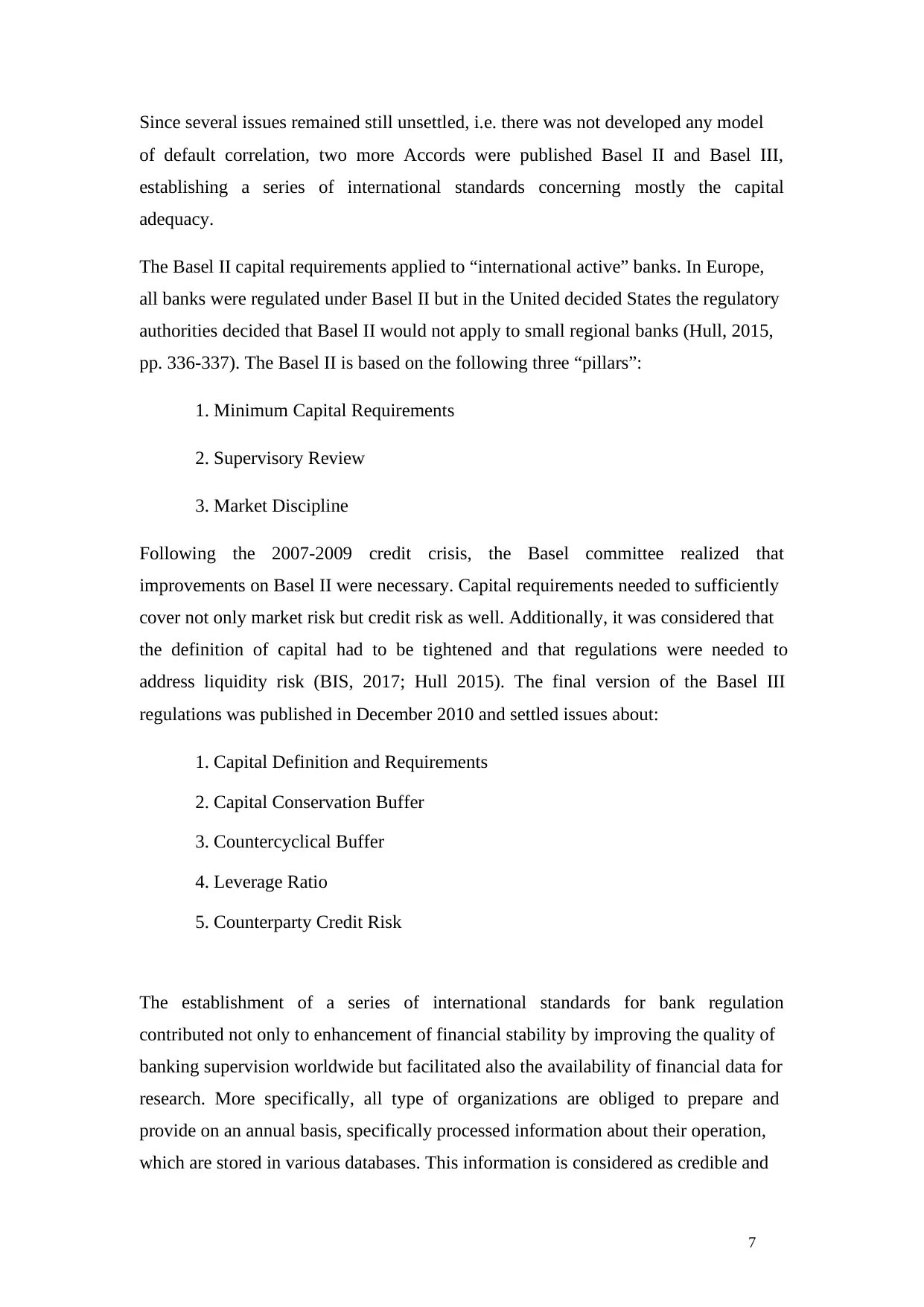
7
Since several issues remained still unsettled, i.e. there was not developed any model
of default correlation, two more Accords were published Basel II and Basel III,
establishing a series of international standards concerning mostly the capital
adequacy.
The Basel II capital requirements applied to “international active” banks. In Europe,
all banks were regulated under Basel II but in the United decided States the regulatory
authorities decided that Basel II would not apply to small regional banks (Hull, 2015,
pp. 336-337). The Basel II is based on the following three “pillars”:
1. Minimum Capital Requirements
2. Supervisory Review
3. Market Discipline
Following the 2007-2009 credit crisis, the Basel committee realized that
improvements on Basel II were necessary. Capital requirements needed to sufficiently
cover not only market risk but credit risk as well. Additionally, it was considered that
the definition of capital had to be tightened and that regulations were needed to
address liquidity risk (BIS, 2017; Hull 2015). The final version of the Basel III
regulations was published in December 2010 and settled issues about:
1. Capital Definition and Requirements
2. Capital Conservation Buffer
3. Countercyclical Buffer
4. Leverage Ratio
5. Counterparty Credit Risk
The establishment of a series of international standards for bank regulation
contributed not only to enhancement of financial stability by improving the quality of
banking supervision worldwide but facilitated also the availability of financial data for
research. More specifically, all type of organizations are obliged to prepare and
provide on an annual basis, specifically processed information about their operation,
which are stored in various databases. This information is considered as credible and
Since several issues remained still unsettled, i.e. there was not developed any model
of default correlation, two more Accords were published Basel II and Basel III,
establishing a series of international standards concerning mostly the capital
adequacy.
The Basel II capital requirements applied to “international active” banks. In Europe,
all banks were regulated under Basel II but in the United decided States the regulatory
authorities decided that Basel II would not apply to small regional banks (Hull, 2015,
pp. 336-337). The Basel II is based on the following three “pillars”:
1. Minimum Capital Requirements
2. Supervisory Review
3. Market Discipline
Following the 2007-2009 credit crisis, the Basel committee realized that
improvements on Basel II were necessary. Capital requirements needed to sufficiently
cover not only market risk but credit risk as well. Additionally, it was considered that
the definition of capital had to be tightened and that regulations were needed to
address liquidity risk (BIS, 2017; Hull 2015). The final version of the Basel III
regulations was published in December 2010 and settled issues about:
1. Capital Definition and Requirements
2. Capital Conservation Buffer
3. Countercyclical Buffer
4. Leverage Ratio
5. Counterparty Credit Risk
The establishment of a series of international standards for bank regulation
contributed not only to enhancement of financial stability by improving the quality of
banking supervision worldwide but facilitated also the availability of financial data for
research. More specifically, all type of organizations are obliged to prepare and
provide on an annual basis, specifically processed information about their operation,
which are stored in various databases. This information is considered as credible and
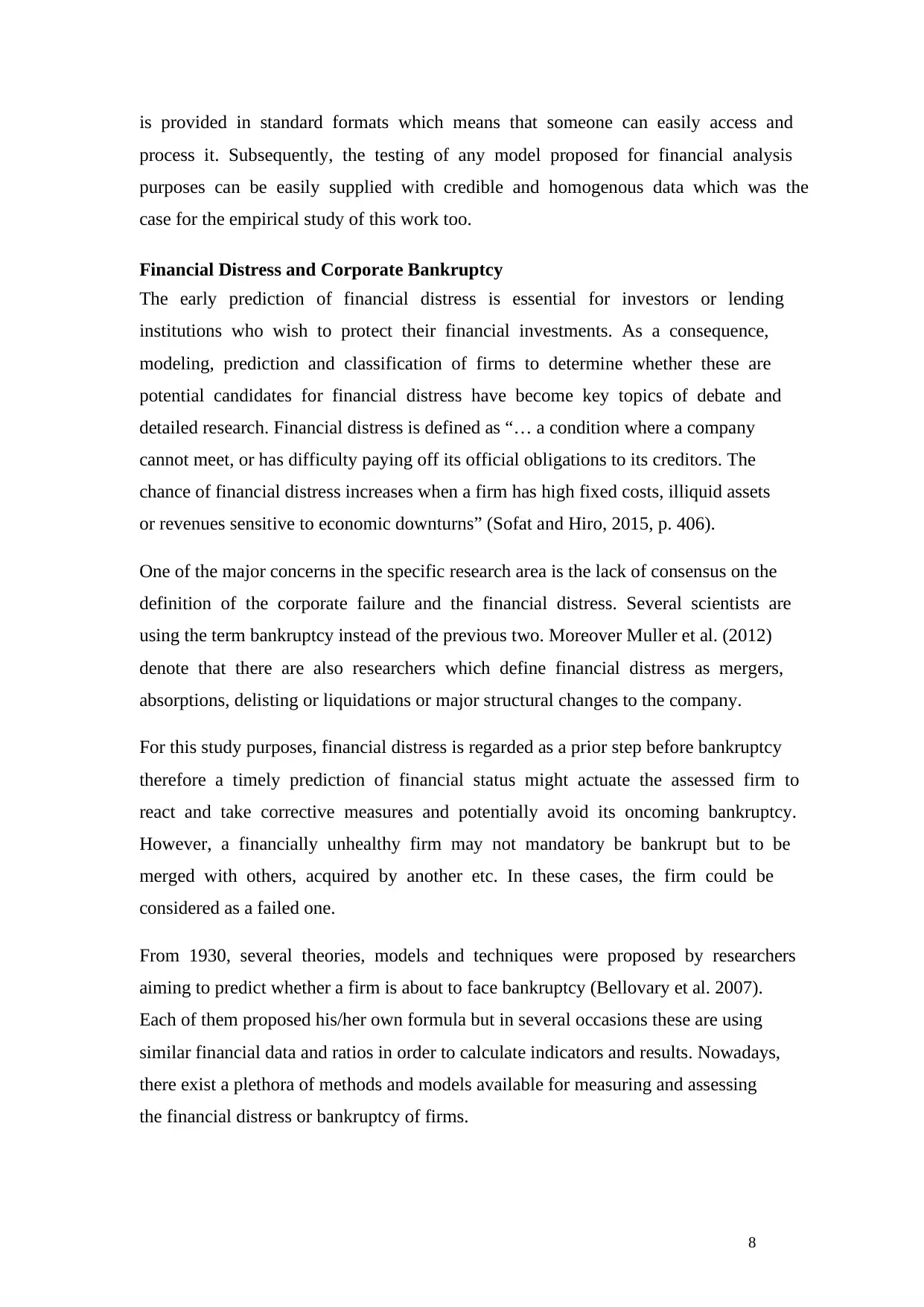
8
is provided in standard formats which means that someone can easily access and
process it. Subsequently, the testing of any model proposed for financial analysis
purposes can be easily supplied with credible and homogenous data which was the
case for the empirical study of this work too.
Financial Distress and Corporate Bankruptcy
The early prediction of financial distress is essential for investors or lending
institutions who wish to protect their financial investments. As a consequence,
modeling, prediction and classification of firms to determine whether these are
potential candidates for financial distress have become key topics of debate and
detailed research. Financial distress is defined as “… a condition where a company
cannot meet, or has difficulty paying off its official obligations to its creditors. The
chance of financial distress increases when a firm has high fixed costs, illiquid assets
or revenues sensitive to economic downturns” (Sofat and Hiro, 2015, p. 406).
One of the major concerns in the specific research area is the lack of consensus on the
definition of the corporate failure and the financial distress. Several scientists are
using the term bankruptcy instead of the previous two. Moreover Muller et al. (2012)
denote that there are also researchers which define financial distress as mergers,
absorptions, delisting or liquidations or major structural changes to the company.
For this study purposes, financial distress is regarded as a prior step before bankruptcy
therefore a timely prediction of financial status might actuate the assessed firm to
react and take corrective measures and potentially avoid its oncoming bankruptcy.
However, a financially unhealthy firm may not mandatory be bankrupt but to be
merged with others, acquired by another etc. In these cases, the firm could be
considered as a failed one.
From 1930, several theories, models and techniques were proposed by researchers
aiming to predict whether a firm is about to face bankruptcy (Bellovary et al. 2007).
Each of them proposed his/her own formula but in several occasions these are using
similar financial data and ratios in order to calculate indicators and results. Nowadays,
there exist a plethora of methods and models available for measuring and assessing
the financial distress or bankruptcy of firms.
is provided in standard formats which means that someone can easily access and
process it. Subsequently, the testing of any model proposed for financial analysis
purposes can be easily supplied with credible and homogenous data which was the
case for the empirical study of this work too.
Financial Distress and Corporate Bankruptcy
The early prediction of financial distress is essential for investors or lending
institutions who wish to protect their financial investments. As a consequence,
modeling, prediction and classification of firms to determine whether these are
potential candidates for financial distress have become key topics of debate and
detailed research. Financial distress is defined as “… a condition where a company
cannot meet, or has difficulty paying off its official obligations to its creditors. The
chance of financial distress increases when a firm has high fixed costs, illiquid assets
or revenues sensitive to economic downturns” (Sofat and Hiro, 2015, p. 406).
One of the major concerns in the specific research area is the lack of consensus on the
definition of the corporate failure and the financial distress. Several scientists are
using the term bankruptcy instead of the previous two. Moreover Muller et al. (2012)
denote that there are also researchers which define financial distress as mergers,
absorptions, delisting or liquidations or major structural changes to the company.
For this study purposes, financial distress is regarded as a prior step before bankruptcy
therefore a timely prediction of financial status might actuate the assessed firm to
react and take corrective measures and potentially avoid its oncoming bankruptcy.
However, a financially unhealthy firm may not mandatory be bankrupt but to be
merged with others, acquired by another etc. In these cases, the firm could be
considered as a failed one.
From 1930, several theories, models and techniques were proposed by researchers
aiming to predict whether a firm is about to face bankruptcy (Bellovary et al. 2007).
Each of them proposed his/her own formula but in several occasions these are using
similar financial data and ratios in order to calculate indicators and results. Nowadays,
there exist a plethora of methods and models available for measuring and assessing
the financial distress or bankruptcy of firms.

9
Historically, corporate bankruptcy was first modeled, classified and predicted by
Beaver in 1966. He defined financial distress as bankruptcy, insolvency, liquidation
for the benefit of a creditor, firms which defaulted on loan obligations or firms that
missed preferred dividend payments. In his research compared the mean values of 30
ratios of 79 failed and 79 non-failed firms in 38 industries but also tested the
individual ratios' predictive abilities in classifying bankrupt and non-bankrupt firms.
Actually he tested separately ratios of a) Net Income to Total Debt b) Net Income to
Sales c) Net Income to Net Worth d) Cash Flow to Total Debt and e) Cash Flow to
Total Assets with high accuracy results for all ratios. He came to conclusion that cash
flow to debt ratio was the single best indicator of bankruptcy (Beaver, 1966a; Muller
et al., 2012) and suggested that if multiple ratios considered simultaneously, in future
research, might have higher predictive ability than single ratios (Bellovary et al.,
2007).
More specifically, Beaver (1966b) developed the first parametric model for corporate
bankruptcy and his kind of analysis was characterized as univariate (Fitzpatrick, 1932;
Horrigan, 1965). Prediction models that came up afterwards were categorized either
as parametric or non-parametric. Accordingly, the evolution of the next generation of
bankruptcy prediction models was based on the concept of firm classification in failed
non-failed respectively.
Recently Cybinski (2001) claimed that there is no clear distinction between "failed"
and "non-failed" firms and all of them are rather laying on a common continuum of
failed and non-failed. She argued that in reality there is not an obvious cut-off point
between "failed" and "non-failed" firms but rather an overlap or grey area between
these two classification groups. According Cybinski, it is quite difficult to accomplish
predictions of financial distress for firms belonging to this grey area (Cybinski, 2001;
Muller et al., 2012).
Besides univariate models another kind of prediction models, the so called
multivariate models, came in use a few years later. A multivariate model can be
characterized as discriminant analysis or multi discriminant analysis (MDA) (Altman,
1968; Altman 1993, Altman, 2000). The evolution of MDA models came with
probability models like Probit and Logit or Ohlson’s model (1980).
Historically, corporate bankruptcy was first modeled, classified and predicted by
Beaver in 1966. He defined financial distress as bankruptcy, insolvency, liquidation
for the benefit of a creditor, firms which defaulted on loan obligations or firms that
missed preferred dividend payments. In his research compared the mean values of 30
ratios of 79 failed and 79 non-failed firms in 38 industries but also tested the
individual ratios' predictive abilities in classifying bankrupt and non-bankrupt firms.
Actually he tested separately ratios of a) Net Income to Total Debt b) Net Income to
Sales c) Net Income to Net Worth d) Cash Flow to Total Debt and e) Cash Flow to
Total Assets with high accuracy results for all ratios. He came to conclusion that cash
flow to debt ratio was the single best indicator of bankruptcy (Beaver, 1966a; Muller
et al., 2012) and suggested that if multiple ratios considered simultaneously, in future
research, might have higher predictive ability than single ratios (Bellovary et al.,
2007).
More specifically, Beaver (1966b) developed the first parametric model for corporate
bankruptcy and his kind of analysis was characterized as univariate (Fitzpatrick, 1932;
Horrigan, 1965). Prediction models that came up afterwards were categorized either
as parametric or non-parametric. Accordingly, the evolution of the next generation of
bankruptcy prediction models was based on the concept of firm classification in failed
non-failed respectively.
Recently Cybinski (2001) claimed that there is no clear distinction between "failed"
and "non-failed" firms and all of them are rather laying on a common continuum of
failed and non-failed. She argued that in reality there is not an obvious cut-off point
between "failed" and "non-failed" firms but rather an overlap or grey area between
these two classification groups. According Cybinski, it is quite difficult to accomplish
predictions of financial distress for firms belonging to this grey area (Cybinski, 2001;
Muller et al., 2012).
Besides univariate models another kind of prediction models, the so called
multivariate models, came in use a few years later. A multivariate model can be
characterized as discriminant analysis or multi discriminant analysis (MDA) (Altman,
1968; Altman 1993, Altman, 2000). The evolution of MDA models came with
probability models like Probit and Logit or Ohlson’s model (1980).
Paraphrase This Document
Need a fresh take? Get an instant paraphrase of this document with our AI Paraphraser

10
An interesting overview of bankruptcy predictions from 1930 to 2002 is provided by
Bellovary, Giacomino, and Akers (2007).
MDA analysis
Discriminant analysis is a statistical technique for distinguishing between two or
more groups on the basis of their observed and measured characteristics. For example,
an analyst might take multiple factors into account, such as different financial ratios,
when choosing between stocks in order to design an efficient portfolio.
Fischer (1936) used the term discriminant analysis in the article "The Use of Multiple
Measurement in Taxonomic Problems". The method was applied for exploration of
the relationship between a group of independent characters (discriminators) and one
qualitative dependent variable-output. This output could be in simple cases 0 or 1
allowing the classification of the analysed objects either to first or the second class.
The classes are known to be clearly distinguishable and each object clearly belongs to
one of them. The task can also be identification of features that contribute to the
identification process. The purpose is to find a prediction model classifying new
objects (for example firms, financial institutions, banks etc) into classes. New objects
are classified into classes based on their high degree of similarity.
According to the numbers of variations of qualitative variable one might distinguish:
• discriminant analysis for two groups,
• discriminant analysis for more groups.
Discriminant analysis method is applied in classification problems of many research
fields. For example in financing area, a bank can monitor in the sample used its
client’s way of repaying their loans and some other indicators. Subsequently on this
basis, the bank may evaluate potential clients (based on same characteristics with
those of the sample) as more or less credible for a loan.
The main task of discriminant analysis is to find the optimal attributing rules that will
minimize the likelihood of erroneous classification of elements, i.e. it will minimize
the median of erroneous decision (it may happen that an element actually comes from
a particular group but it is classified into different group by obtained discriminant
analysis). Each element is characterized by several features which reflect its
An interesting overview of bankruptcy predictions from 1930 to 2002 is provided by
Bellovary, Giacomino, and Akers (2007).
MDA analysis
Discriminant analysis is a statistical technique for distinguishing between two or
more groups on the basis of their observed and measured characteristics. For example,
an analyst might take multiple factors into account, such as different financial ratios,
when choosing between stocks in order to design an efficient portfolio.
Fischer (1936) used the term discriminant analysis in the article "The Use of Multiple
Measurement in Taxonomic Problems". The method was applied for exploration of
the relationship between a group of independent characters (discriminators) and one
qualitative dependent variable-output. This output could be in simple cases 0 or 1
allowing the classification of the analysed objects either to first or the second class.
The classes are known to be clearly distinguishable and each object clearly belongs to
one of them. The task can also be identification of features that contribute to the
identification process. The purpose is to find a prediction model classifying new
objects (for example firms, financial institutions, banks etc) into classes. New objects
are classified into classes based on their high degree of similarity.
According to the numbers of variations of qualitative variable one might distinguish:
• discriminant analysis for two groups,
• discriminant analysis for more groups.
Discriminant analysis method is applied in classification problems of many research
fields. For example in financing area, a bank can monitor in the sample used its
client’s way of repaying their loans and some other indicators. Subsequently on this
basis, the bank may evaluate potential clients (based on same characteristics with
those of the sample) as more or less credible for a loan.
The main task of discriminant analysis is to find the optimal attributing rules that will
minimize the likelihood of erroneous classification of elements, i.e. it will minimize
the median of erroneous decision (it may happen that an element actually comes from
a particular group but it is classified into different group by obtained discriminant
analysis). Each element is characterized by several features which reflect its
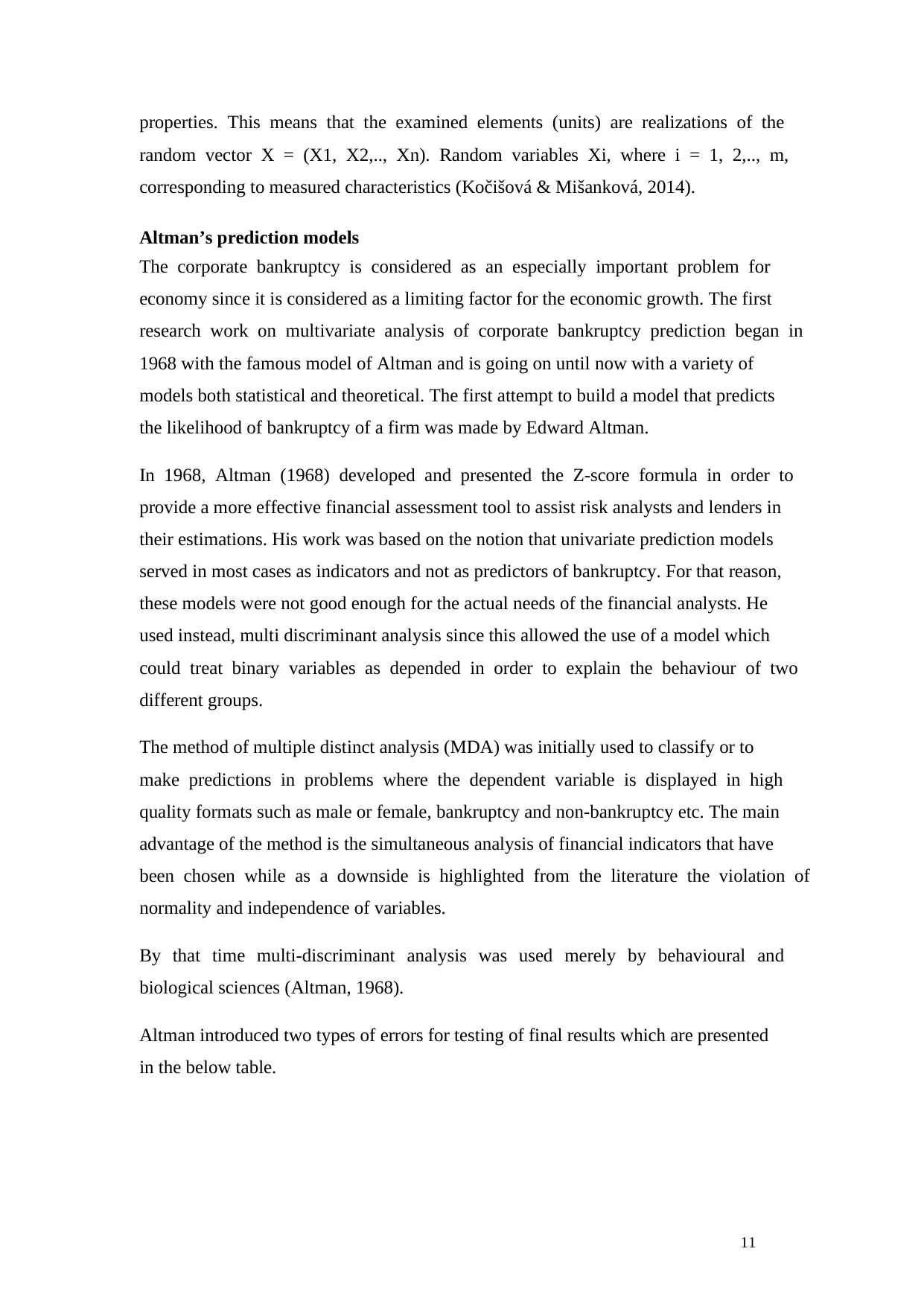
11
properties. This means that the examined elements (units) are realizations of the
random vector X = (X1, X2,.., Xn). Random variables Xi, where i = 1, 2,.., m,
corresponding to measured characteristics (Kočišová & Mišanková, 2014).
Altman’s prediction models
The corporate bankruptcy is considered as an especially important problem for
economy since it is considered as a limiting factor for the economic growth. The first
research work on multivariate analysis of corporate bankruptcy prediction began in
1968 with the famous model of Altman and is going on until now with a variety of
models both statistical and theoretical. The first attempt to build a model that predicts
the likelihood of bankruptcy of a firm was made by Edward Altman.
In 1968, Altman (1968) developed and presented the Z-score formula in order to
provide a more effective financial assessment tool to assist risk analysts and lenders in
their estimations. His work was based on the notion that univariate prediction models
served in most cases as indicators and not as predictors of bankruptcy. For that reason,
these models were not good enough for the actual needs of the financial analysts. He
used instead, multi discriminant analysis since this allowed the use of a model which
could treat binary variables as depended in order to explain the behaviour of two
different groups.
The method of multiple distinct analysis (MDA) was initially used to classify or to
make predictions in problems where the dependent variable is displayed in high
quality formats such as male or female, bankruptcy and non-bankruptcy etc. The main
advantage of the method is the simultaneous analysis of financial indicators that have
been chosen while as a downside is highlighted from the literature the violation of
normality and independence of variables.
By that time multi-discriminant analysis was used merely by behavioural and
biological sciences (Altman, 1968).
Altman introduced two types of errors for testing of final results which are presented
in the below table.
properties. This means that the examined elements (units) are realizations of the
random vector X = (X1, X2,.., Xn). Random variables Xi, where i = 1, 2,.., m,
corresponding to measured characteristics (Kočišová & Mišanková, 2014).
Altman’s prediction models
The corporate bankruptcy is considered as an especially important problem for
economy since it is considered as a limiting factor for the economic growth. The first
research work on multivariate analysis of corporate bankruptcy prediction began in
1968 with the famous model of Altman and is going on until now with a variety of
models both statistical and theoretical. The first attempt to build a model that predicts
the likelihood of bankruptcy of a firm was made by Edward Altman.
In 1968, Altman (1968) developed and presented the Z-score formula in order to
provide a more effective financial assessment tool to assist risk analysts and lenders in
their estimations. His work was based on the notion that univariate prediction models
served in most cases as indicators and not as predictors of bankruptcy. For that reason,
these models were not good enough for the actual needs of the financial analysts. He
used instead, multi discriminant analysis since this allowed the use of a model which
could treat binary variables as depended in order to explain the behaviour of two
different groups.
The method of multiple distinct analysis (MDA) was initially used to classify or to
make predictions in problems where the dependent variable is displayed in high
quality formats such as male or female, bankruptcy and non-bankruptcy etc. The main
advantage of the method is the simultaneous analysis of financial indicators that have
been chosen while as a downside is highlighted from the literature the violation of
normality and independence of variables.
By that time multi-discriminant analysis was used merely by behavioural and
biological sciences (Altman, 1968).
Altman introduced two types of errors for testing of final results which are presented
in the below table.
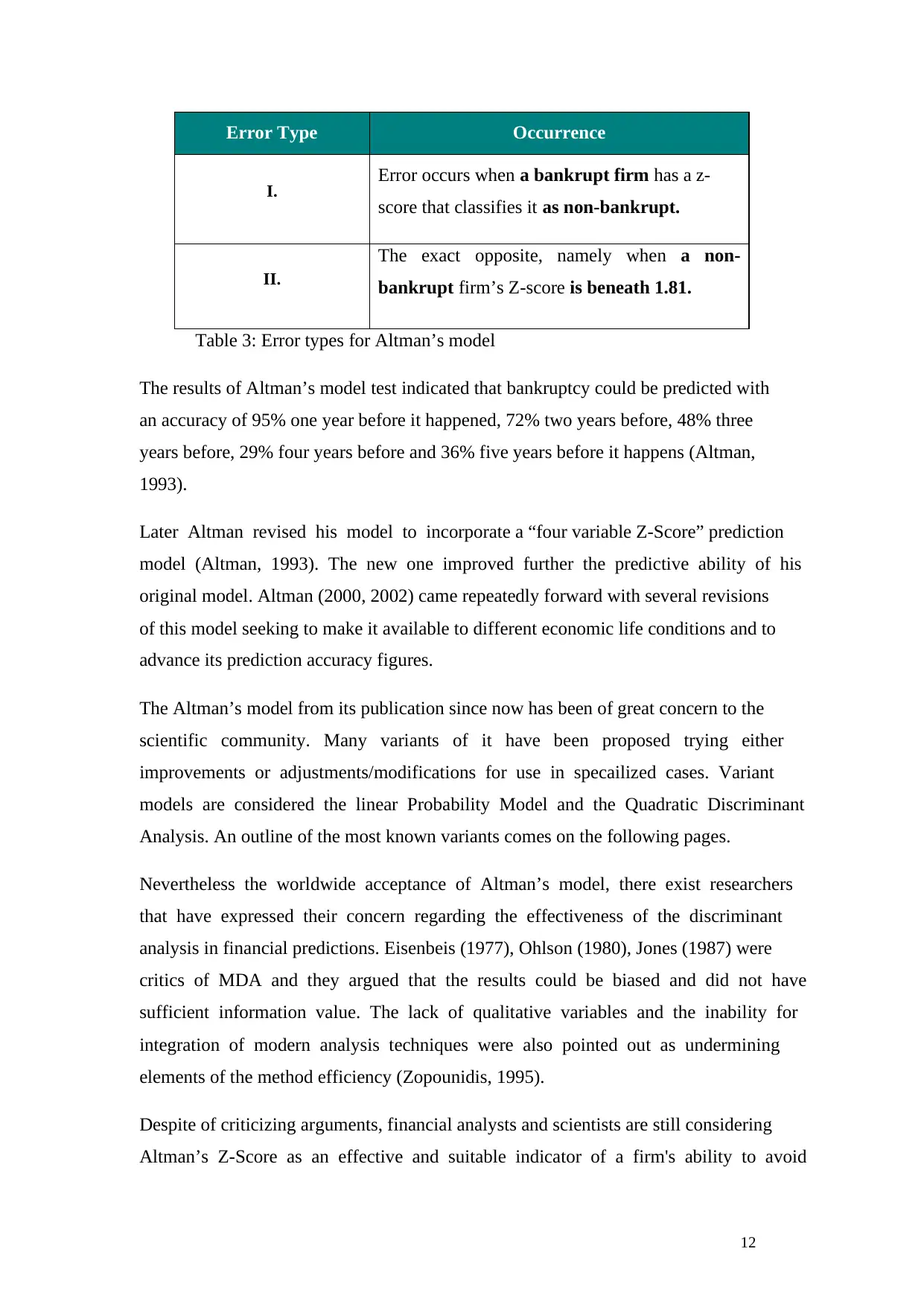
12
Error Type Occurrence
I. Error occurs when a bankrupt firm has a z-
score that classifies it as non-bankrupt.
II.
The exact opposite, namely when a non-
bankrupt firm’s Z-score is beneath 1.81.
Table 3: Error types for Altman’s model
The results of Altman’s model test indicated that bankruptcy could be predicted with
an accuracy of 95% one year before it happened, 72% two years before, 48% three
years before, 29% four years before and 36% five years before it happens (Altman,
1993).
Later Altman revised his model to incorporate a “four variable Z-Score” prediction
model (Altman, 1993). The new one improved further the predictive ability of his
original model. Altman (2000, 2002) came repeatedly forward with several revisions
of this model seeking to make it available to different economic life conditions and to
advance its prediction accuracy figures.
The Altman’s model from its publication since now has been of great concern to the
scientific community. Many variants of it have been proposed trying either
improvements or adjustments/modifications for use in specailized cases. Variant
models are considered the linear Probability Model and the Quadratic Discriminant
Analysis. An outline of the most known variants comes on the following pages.
Nevertheless the worldwide acceptance of Altman’s model, there exist researchers
that have expressed their concern regarding the effectiveness of the discriminant
analysis in financial predictions. Eisenbeis (1977), Ohlson (1980), Jones (1987) were
critics of MDA and they argued that the results could be biased and did not have
sufficient information value. The lack of qualitative variables and the inability for
integration of modern analysis techniques were also pointed out as undermining
elements of the method efficiency (Zopounidis, 1995).
Despite of criticizing arguments, financial analysts and scientists are still considering
Altman’s Z-Score as an effective and suitable indicator of a firm's ability to avoid
Error Type Occurrence
I. Error occurs when a bankrupt firm has a z-
score that classifies it as non-bankrupt.
II.
The exact opposite, namely when a non-
bankrupt firm’s Z-score is beneath 1.81.
Table 3: Error types for Altman’s model
The results of Altman’s model test indicated that bankruptcy could be predicted with
an accuracy of 95% one year before it happened, 72% two years before, 48% three
years before, 29% four years before and 36% five years before it happens (Altman,
1993).
Later Altman revised his model to incorporate a “four variable Z-Score” prediction
model (Altman, 1993). The new one improved further the predictive ability of his
original model. Altman (2000, 2002) came repeatedly forward with several revisions
of this model seeking to make it available to different economic life conditions and to
advance its prediction accuracy figures.
The Altman’s model from its publication since now has been of great concern to the
scientific community. Many variants of it have been proposed trying either
improvements or adjustments/modifications for use in specailized cases. Variant
models are considered the linear Probability Model and the Quadratic Discriminant
Analysis. An outline of the most known variants comes on the following pages.
Nevertheless the worldwide acceptance of Altman’s model, there exist researchers
that have expressed their concern regarding the effectiveness of the discriminant
analysis in financial predictions. Eisenbeis (1977), Ohlson (1980), Jones (1987) were
critics of MDA and they argued that the results could be biased and did not have
sufficient information value. The lack of qualitative variables and the inability for
integration of modern analysis techniques were also pointed out as undermining
elements of the method efficiency (Zopounidis, 1995).
Despite of criticizing arguments, financial analysts and scientists are still considering
Altman’s Z-Score as an effective and suitable indicator of a firm's ability to avoid
Secure Best Marks with AI Grader
Need help grading? Try our AI Grader for instant feedback on your assignments.

13
bankruptcy. All over the world, financial and credit professionals are constantly using
Altman's models in order to mitigate risk in debt portfolios. It is quite popular because
it uses multiple variables to measure the financial health and credit worthiness of
anyone (person or firm). Since Z-score is an open system, the variables employed in
the formula can easily be understood by its users.
As aforementioned, the Z-score model was initially developed for publicly held
manufacturing firms with assets of more than $1 million. Over the years, Altman
revised its model in order to be applicable to privately held firms (the Altman Z'-
Score) and non-manufacturing firms (the Altman Z"-Score). Altman's Z-score
formulas are used in a variety of contexts and countries.
Z-score formula
The formula uses a statistical technique known as multiple discriminant analysis
(MDA), by which Altman attempted to predict defaults by use of the following five
accounting ratios (Hayes et al., 2010; Hull, 2015, p. 400):
X1: Working Capital/Total Assets
X2: Retained Earnings/Total Assets
X3: Earnings before interest and taxes/Total Assets
X4: Market value of equity/Book Value of Total Liabilities
X5: Sales/Total Assets
Depending on the nature of the enterprises assessed the Z-score formula varies
(Altman, 1968; Altman, 1977; Altman, 1993; Altman, 2000). In case of publicly
traded manufacturing companies (general formula) the original Z-score is:
Z=1.2*X1+1.4*X2+3.3*X3+0.6*X4+0.999*X5 (1)
While, in the predictions for non-manufacturing firms (not applicable for banks &
finance companies), the calculation formula uses only four variables and becomes
(Altman, 1977, p. 22; Chotalia, 2014):
Z=6.56*X1+3.26*X2+6.72*X3+1.05*X4 (2)
bankruptcy. All over the world, financial and credit professionals are constantly using
Altman's models in order to mitigate risk in debt portfolios. It is quite popular because
it uses multiple variables to measure the financial health and credit worthiness of
anyone (person or firm). Since Z-score is an open system, the variables employed in
the formula can easily be understood by its users.
As aforementioned, the Z-score model was initially developed for publicly held
manufacturing firms with assets of more than $1 million. Over the years, Altman
revised its model in order to be applicable to privately held firms (the Altman Z'-
Score) and non-manufacturing firms (the Altman Z"-Score). Altman's Z-score
formulas are used in a variety of contexts and countries.
Z-score formula
The formula uses a statistical technique known as multiple discriminant analysis
(MDA), by which Altman attempted to predict defaults by use of the following five
accounting ratios (Hayes et al., 2010; Hull, 2015, p. 400):
X1: Working Capital/Total Assets
X2: Retained Earnings/Total Assets
X3: Earnings before interest and taxes/Total Assets
X4: Market value of equity/Book Value of Total Liabilities
X5: Sales/Total Assets
Depending on the nature of the enterprises assessed the Z-score formula varies
(Altman, 1968; Altman, 1977; Altman, 1993; Altman, 2000). In case of publicly
traded manufacturing companies (general formula) the original Z-score is:
Z=1.2*X1+1.4*X2+3.3*X3+0.6*X4+0.999*X5 (1)
While, in the predictions for non-manufacturing firms (not applicable for banks &
finance companies), the calculation formula uses only four variables and becomes
(Altman, 1977, p. 22; Chotalia, 2014):
Z=6.56*X1+3.26*X2+6.72*X3+1.05*X4 (2)

14
Respectively, for companies from emerging markets (banks) the calculation formula
takes the following form:
Z=6.56*X1+3.26*X2+6.72*X3+1.05*X4+3.26 (3)
Variable
name Ratio of Result to be achieved
X1
Working Capital / Total
Assets (WC/TA)
This ratio measures the net working capital
relative to the size of the assets used in the
business. It is used as a measure of liquidity
standardized by the size of the firm.
X2
Retained Earnings / Total
Assets (RE/TA)
This variable relates the total retained
earnings of the firm to the total assets
employed. It is able to capture the
cumulative profitability of the firm since
inception. Also, since young firms tend to
have low RE/TA ratios, this variable may
capture the age of the firm as well.
X3
Earnings Before Interest
and Taxes / Total Assets
(EBIT/TA)
The operating profitability in relation to
total assets measures the productivity of the
assets or the earning power.
X4
Market Value Equity /
Book Value of Total
Liabilities (MVE/TL)
This ratio measures the extent to which
total assets can decline in value before total
liabilities exceed book value of equity. In
other words, this indicates the asset cushion
of the firm.1
1 X4*, Book Value Equity / Book Value of Total Liabilities (BE/TL)
This alternative ratio for X4 variable is appropriate for a firm that is not publicly traded, and hence the
Z-model with this variable definition is called the Z’-model or the private firm model.
Respectively, for companies from emerging markets (banks) the calculation formula
takes the following form:
Z=6.56*X1+3.26*X2+6.72*X3+1.05*X4+3.26 (3)
Variable
name Ratio of Result to be achieved
X1
Working Capital / Total
Assets (WC/TA)
This ratio measures the net working capital
relative to the size of the assets used in the
business. It is used as a measure of liquidity
standardized by the size of the firm.
X2
Retained Earnings / Total
Assets (RE/TA)
This variable relates the total retained
earnings of the firm to the total assets
employed. It is able to capture the
cumulative profitability of the firm since
inception. Also, since young firms tend to
have low RE/TA ratios, this variable may
capture the age of the firm as well.
X3
Earnings Before Interest
and Taxes / Total Assets
(EBIT/TA)
The operating profitability in relation to
total assets measures the productivity of the
assets or the earning power.
X4
Market Value Equity /
Book Value of Total
Liabilities (MVE/TL)
This ratio measures the extent to which
total assets can decline in value before total
liabilities exceed book value of equity. In
other words, this indicates the asset cushion
of the firm.1
1 X4*, Book Value Equity / Book Value of Total Liabilities (BE/TL)
This alternative ratio for X4 variable is appropriate for a firm that is not publicly traded, and hence the
Z-model with this variable definition is called the Z’-model or the private firm model.
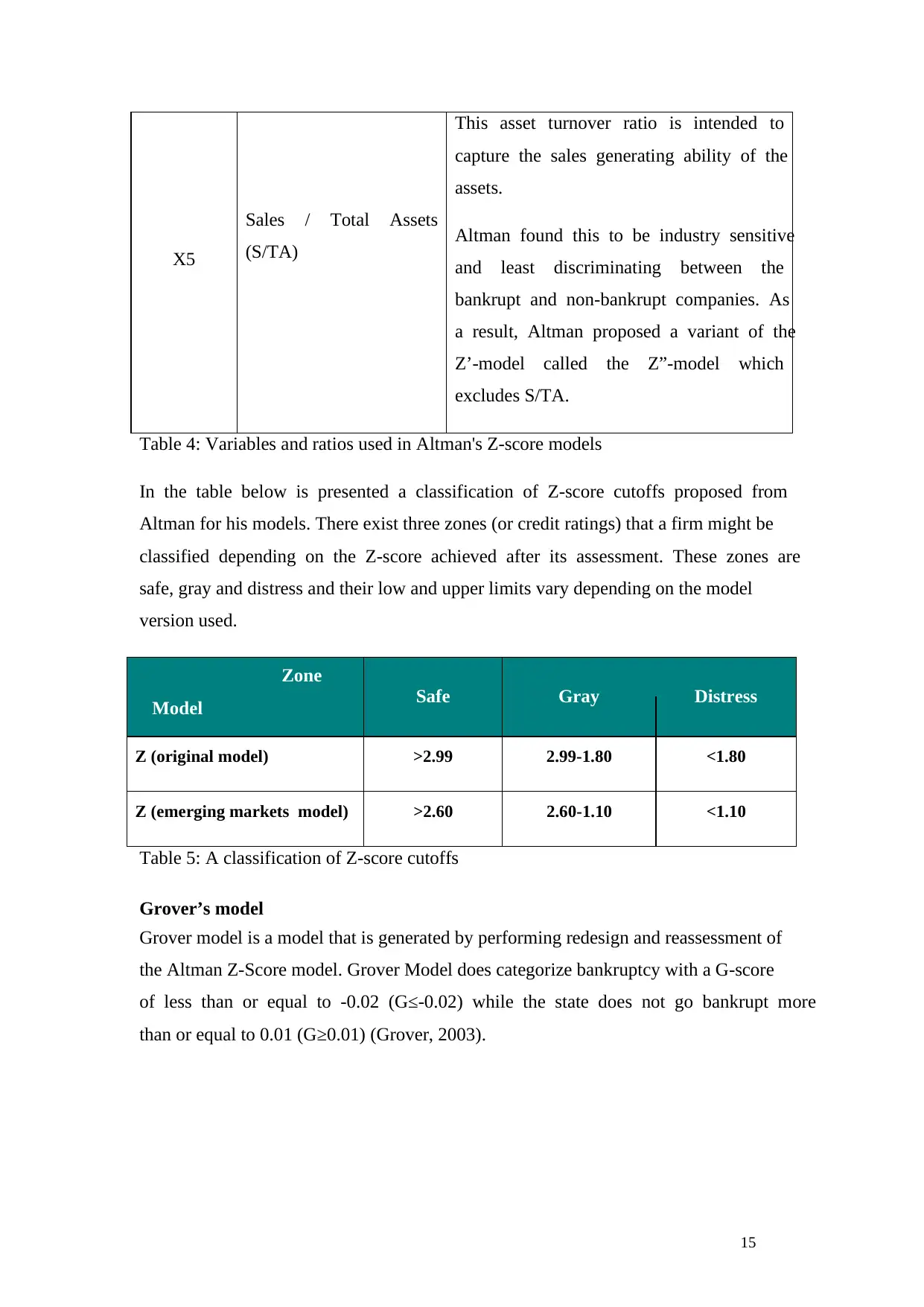
15
X5
Sales / Total Assets
(S/TA)
This asset turnover ratio is intended to
capture the sales generating ability of the
assets.
Altman found this to be industry sensitive
and least discriminating between the
bankrupt and non-bankrupt companies. As
a result, Altman proposed a variant of the
Z’-model called the Z”-model which
excludes S/TA.
Table 4: Variables and ratios used in Altman's Z-score models
In the table below is presented a classification of Z-score cutoffs proposed from
Altman for his models. There exist three zones (or credit ratings) that a firm might be
classified depending on the Z-score achieved after its assessment. These zones are
safe, gray and distress and their low and upper limits vary depending on the model
version used.
Zone
Model Safe Gray Distress
Z (original model) >2.99 2.99-1.80 <1.80
Z (emerging markets model) >2.60 2.60-1.10 <1.10
Table 5: A classification of Z-score cutoffs
Grover’s model
Grover model is a model that is generated by performing redesign and reassessment of
the Altman Z-Score model. Grover Model does categorize bankruptcy with a G-score
of less than or equal to -0.02 (G≤-0.02) while the state does not go bankrupt more
than or equal to 0.01 (G≥0.01) (Grover, 2003).
X5
Sales / Total Assets
(S/TA)
This asset turnover ratio is intended to
capture the sales generating ability of the
assets.
Altman found this to be industry sensitive
and least discriminating between the
bankrupt and non-bankrupt companies. As
a result, Altman proposed a variant of the
Z’-model called the Z”-model which
excludes S/TA.
Table 4: Variables and ratios used in Altman's Z-score models
In the table below is presented a classification of Z-score cutoffs proposed from
Altman for his models. There exist three zones (or credit ratings) that a firm might be
classified depending on the Z-score achieved after its assessment. These zones are
safe, gray and distress and their low and upper limits vary depending on the model
version used.
Zone
Model Safe Gray Distress
Z (original model) >2.99 2.99-1.80 <1.80
Z (emerging markets model) >2.60 2.60-1.10 <1.10
Table 5: A classification of Z-score cutoffs
Grover’s model
Grover model is a model that is generated by performing redesign and reassessment of
the Altman Z-Score model. Grover Model does categorize bankruptcy with a G-score
of less than or equal to -0.02 (G≤-0.02) while the state does not go bankrupt more
than or equal to 0.01 (G≥0.01) (Grover, 2003).
Paraphrase This Document
Need a fresh take? Get an instant paraphrase of this document with our AI Paraphraser
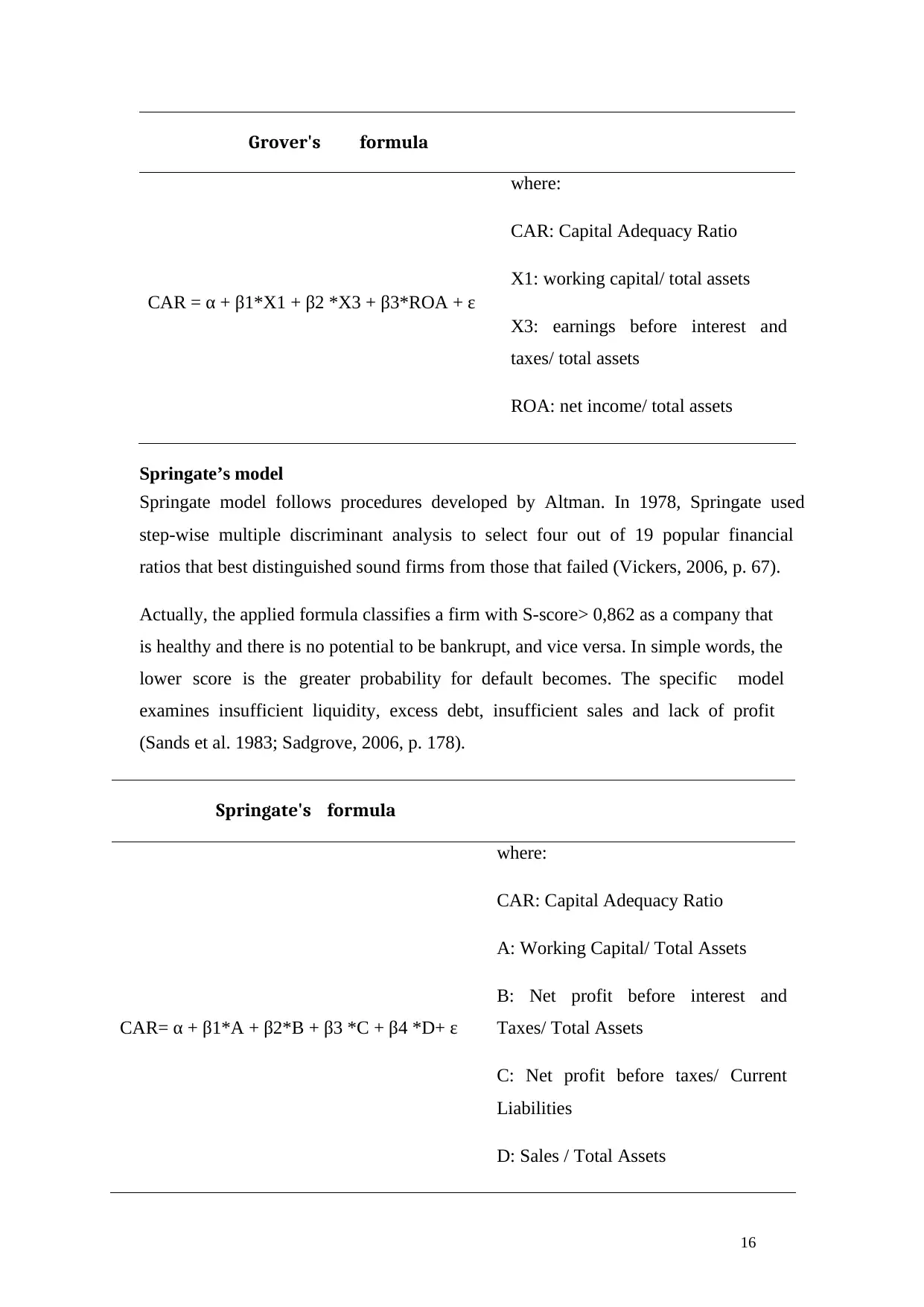
16
Grover's formula
where:
CAR = α + β1*X1 + β2 *X3 + β3*ROA + ɛ
CAR: Capital Adequacy Ratio
X1: working capital/ total assets
X3: earnings before interest and
taxes/ total assets
ROA: net income/ total assets
Springate’s model
Springate model follows procedures developed by Altman. In 1978, Springate used
step-wise multiple discriminant analysis to select four out of 19 popular financial
ratios that best distinguished sound firms from those that failed (Vickers, 2006, p. 67).
Actually, the applied formula classifies a firm with S-score> 0,862 as a company that
is healthy and there is no potential to be bankrupt, and vice versa. In simple words, the
lower score is the greater probability for default becomes. The specific model
examines insufficient liquidity, excess debt, insufficient sales and lack of profit
(Sands et al. 1983; Sadgrove, 2006, p. 178).
Springate's formula
where:
CAR= α + β1*A + β2*B + β3 *C + β4 *D+ ɛ
CAR: Capital Adequacy Ratio
A: Working Capital/ Total Assets
B: Net profit before interest and
Taxes/ Total Assets
C: Net profit before taxes/ Current
Liabilities
D: Sales / Total Assets
Grover's formula
where:
CAR = α + β1*X1 + β2 *X3 + β3*ROA + ɛ
CAR: Capital Adequacy Ratio
X1: working capital/ total assets
X3: earnings before interest and
taxes/ total assets
ROA: net income/ total assets
Springate’s model
Springate model follows procedures developed by Altman. In 1978, Springate used
step-wise multiple discriminant analysis to select four out of 19 popular financial
ratios that best distinguished sound firms from those that failed (Vickers, 2006, p. 67).
Actually, the applied formula classifies a firm with S-score> 0,862 as a company that
is healthy and there is no potential to be bankrupt, and vice versa. In simple words, the
lower score is the greater probability for default becomes. The specific model
examines insufficient liquidity, excess debt, insufficient sales and lack of profit
(Sands et al. 1983; Sadgrove, 2006, p. 178).
Springate's formula
where:
CAR= α + β1*A + β2*B + β3 *C + β4 *D+ ɛ
CAR: Capital Adequacy Ratio
A: Working Capital/ Total Assets
B: Net profit before interest and
Taxes/ Total Assets
C: Net profit before taxes/ Current
Liabilities
D: Sales / Total Assets
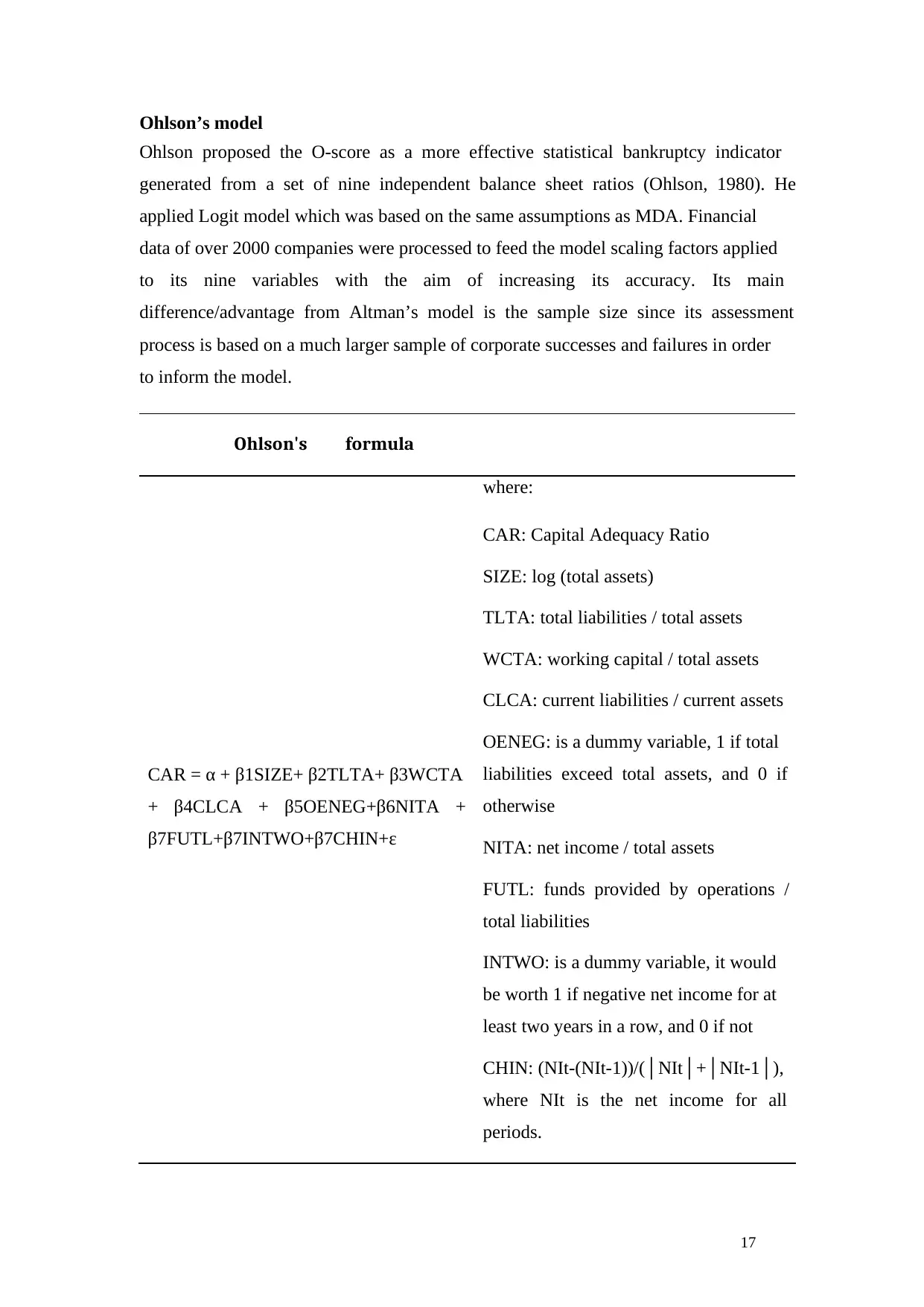
17
Ohlson’s model
Ohlson proposed the O-score as a more effective statistical bankruptcy indicator
generated from a set of nine independent balance sheet ratios (Ohlson, 1980). He
applied Logit model which was based on the same assumptions as MDA. Financial
data of over 2000 companies were processed to feed the model scaling factors applied
to its nine variables with the aim of increasing its accuracy. Its main
difference/advantage from Altman’s model is the sample size since its assessment
process is based on a much larger sample of corporate successes and failures in order
to inform the model.
Ohlson's formula
where:
CAR = α + β1SIZE+ β2TLTA+ β3WCTA
+ β4CLCA + β5OENEG+β6NITA +
β7FUTL+β7INTWO+β7CHIN+ɛ
CAR: Capital Adequacy Ratio
SIZE: log (total assets)
TLTA: total liabilities / total assets
WCTA: working capital / total assets
CLCA: current liabilities / current assets
OENEG: is a dummy variable, 1 if total
liabilities exceed total assets, and 0 if
otherwise
NITA: net income / total assets
FUTL: funds provided by operations /
total liabilities
INTWO: is a dummy variable, it would
be worth 1 if negative net income for at
least two years in a row, and 0 if not
CHIN: (NIt-(NIt-1))/(│NIt│+│NIt-1│),
where NIt is the net income for all
periods.
Ohlson’s model
Ohlson proposed the O-score as a more effective statistical bankruptcy indicator
generated from a set of nine independent balance sheet ratios (Ohlson, 1980). He
applied Logit model which was based on the same assumptions as MDA. Financial
data of over 2000 companies were processed to feed the model scaling factors applied
to its nine variables with the aim of increasing its accuracy. Its main
difference/advantage from Altman’s model is the sample size since its assessment
process is based on a much larger sample of corporate successes and failures in order
to inform the model.
Ohlson's formula
where:
CAR = α + β1SIZE+ β2TLTA+ β3WCTA
+ β4CLCA + β5OENEG+β6NITA +
β7FUTL+β7INTWO+β7CHIN+ɛ
CAR: Capital Adequacy Ratio
SIZE: log (total assets)
TLTA: total liabilities / total assets
WCTA: working capital / total assets
CLCA: current liabilities / current assets
OENEG: is a dummy variable, 1 if total
liabilities exceed total assets, and 0 if
otherwise
NITA: net income / total assets
FUTL: funds provided by operations /
total liabilities
INTWO: is a dummy variable, it would
be worth 1 if negative net income for at
least two years in a row, and 0 if not
CHIN: (NIt-(NIt-1))/(│NIt│+│NIt-1│),
where NIt is the net income for all
periods.
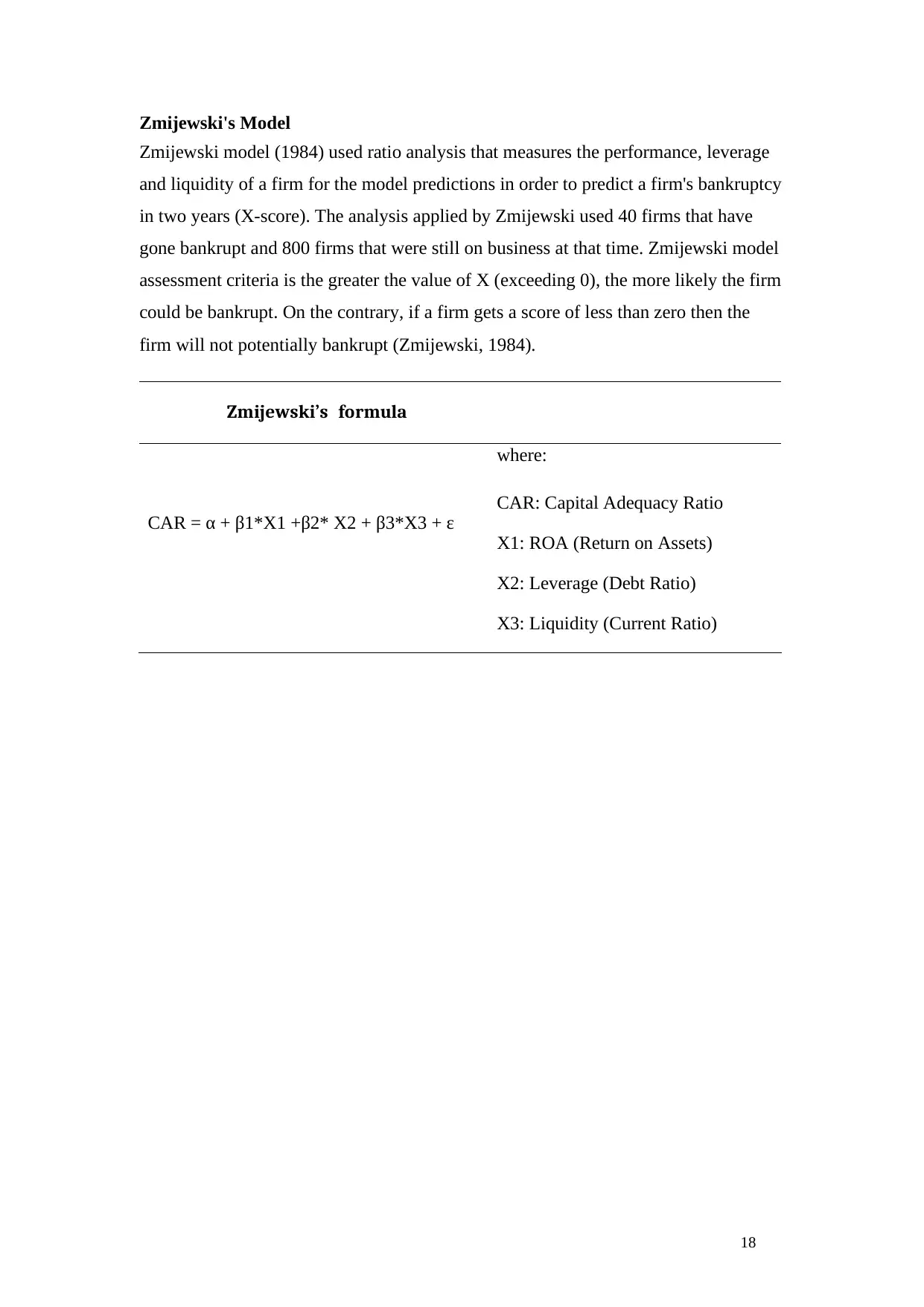
18
Zmijewski's Model
Zmijewski model (1984) used ratio analysis that measures the performance, leverage
and liquidity of a firm for the model predictions in order to predict a firm's bankruptcy
in two years (X-score). The analysis applied by Zmijewski used 40 firms that have
gone bankrupt and 800 firms that were still on business at that time. Zmijewski model
assessment criteria is the greater the value of X (exceeding 0), the more likely the firm
could be bankrupt. On the contrary, if a firm gets a score of less than zero then the
firm will not potentially bankrupt (Zmijewski, 1984).
Zmijewski’s formula
where:
CAR = α + β1*X1 +β2* X2 + β3*X3 + ɛ
CAR: Capital Adequacy Ratio
X1: ROA (Return on Assets)
X2: Leverage (Debt Ratio)
X3: Liquidity (Current Ratio)
Zmijewski's Model
Zmijewski model (1984) used ratio analysis that measures the performance, leverage
and liquidity of a firm for the model predictions in order to predict a firm's bankruptcy
in two years (X-score). The analysis applied by Zmijewski used 40 firms that have
gone bankrupt and 800 firms that were still on business at that time. Zmijewski model
assessment criteria is the greater the value of X (exceeding 0), the more likely the firm
could be bankrupt. On the contrary, if a firm gets a score of less than zero then the
firm will not potentially bankrupt (Zmijewski, 1984).
Zmijewski’s formula
where:
CAR = α + β1*X1 +β2* X2 + β3*X3 + ɛ
CAR: Capital Adequacy Ratio
X1: ROA (Return on Assets)
X2: Leverage (Debt Ratio)
X3: Liquidity (Current Ratio)
Secure Best Marks with AI Grader
Need help grading? Try our AI Grader for instant feedback on your assignments.
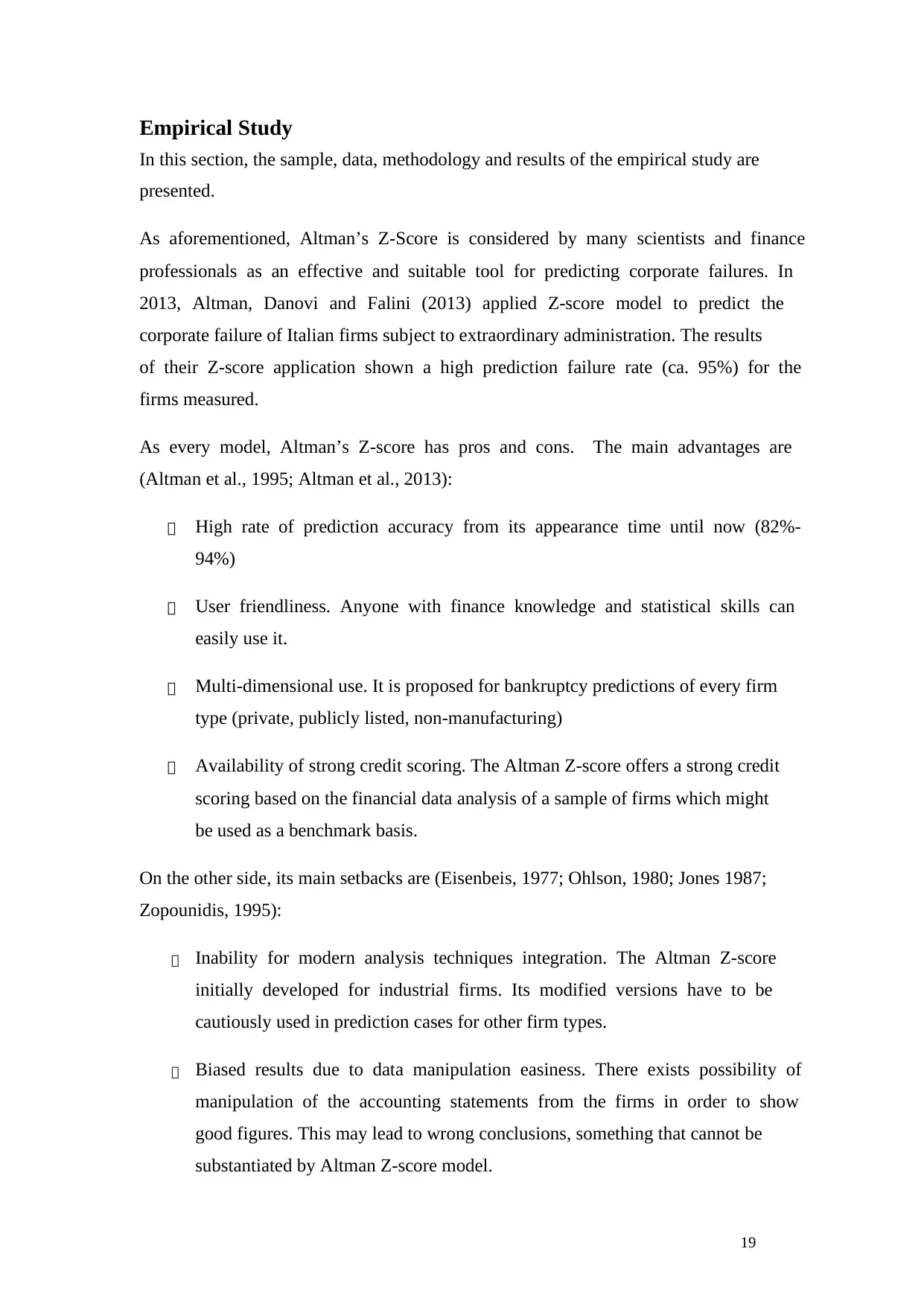
19
Empirical Study
In this section, the sample, data, methodology and results of the empirical study are
presented.
As aforementioned, Altman’s Z-Score is considered by many scientists and finance
professionals as an effective and suitable tool for predicting corporate failures. In
2013, Altman, Danovi and Falini (2013) applied Z-score model to predict the
corporate failure of Italian firms subject to extraordinary administration. The results
of their Z-score application shown a high prediction failure rate (ca. 95%) for the
firms measured.
As every model, Altman’s Z-score has pros and cons. The main advantages are
(Altman et al., 1995; Altman et al., 2013):
High rate of prediction accuracy from its appearance time until now (82%-
94%)
User friendliness. Anyone with finance knowledge and statistical skills can
easily use it.
Multi-dimensional use. It is proposed for bankruptcy predictions of every firm
type (private, publicly listed, non-manufacturing)
Availability of strong credit scoring. The Altman Z-score offers a strong credit
scoring based on the financial data analysis of a sample of firms which might
be used as a benchmark basis.
On the other side, its main setbacks are (Eisenbeis, 1977; Ohlson, 1980; Jones 1987;
Zopounidis, 1995):
Inability for modern analysis techniques integration. The Altman Z-score
initially developed for industrial firms. Its modified versions have to be
cautiously used in prediction cases for other firm types.
Biased results due to data manipulation easiness. There exists possibility of
manipulation of the accounting statements from the firms in order to show
good figures. This may lead to wrong conclusions, something that cannot be
substantiated by Altman Z-score model.
Empirical Study
In this section, the sample, data, methodology and results of the empirical study are
presented.
As aforementioned, Altman’s Z-Score is considered by many scientists and finance
professionals as an effective and suitable tool for predicting corporate failures. In
2013, Altman, Danovi and Falini (2013) applied Z-score model to predict the
corporate failure of Italian firms subject to extraordinary administration. The results
of their Z-score application shown a high prediction failure rate (ca. 95%) for the
firms measured.
As every model, Altman’s Z-score has pros and cons. The main advantages are
(Altman et al., 1995; Altman et al., 2013):
High rate of prediction accuracy from its appearance time until now (82%-
94%)
User friendliness. Anyone with finance knowledge and statistical skills can
easily use it.
Multi-dimensional use. It is proposed for bankruptcy predictions of every firm
type (private, publicly listed, non-manufacturing)
Availability of strong credit scoring. The Altman Z-score offers a strong credit
scoring based on the financial data analysis of a sample of firms which might
be used as a benchmark basis.
On the other side, its main setbacks are (Eisenbeis, 1977; Ohlson, 1980; Jones 1987;
Zopounidis, 1995):
Inability for modern analysis techniques integration. The Altman Z-score
initially developed for industrial firms. Its modified versions have to be
cautiously used in prediction cases for other firm types.
Biased results due to data manipulation easiness. There exists possibility of
manipulation of the accounting statements from the firms in order to show
good figures. This may lead to wrong conclusions, something that cannot be
substantiated by Altman Z-score model.

20
The use of Z-score model to predict bank failure has a relatively recent appearance. In
previous research works, aiming to measure the financial status of banks by use of Z-
score, the specialized Altman’s formula for firms from emerging markets was
preferred (Chieng, 2013; Chotalia, 2014; Samarakoon and Hasan; 2003). In some
cases, in the formula used for emerging markets was also included a specific constant
proposed by Altman et al. (1995), so that the scores equal or less than zero would be
equivalent to the default situation. The latter is the case for this empirical study too.
Sample and data
The data sample consisted of 42 banks which were classified into two groups of 21
unmatched and randomly categorized banks for each group. In the first one were
included all “failed” banks and the second contained the “non-failed” or still active
banks, according to Altman’s model specifications.
In the so-called “failed” group are included of banks from Greece, Italy, Ireland
Portugal, Spain and Cyprus. Further on, in this work, these countries will be called as
GIIPS countries and respectively the banks as GIIPS banks. The “non-failed” group is
consisted of still active banks from several Central European countries, namely
Germany, France, Belgium, Netherlands and Switzerland. The last one is not a
European Union member but it is an associated country to EU and their banks are
following the rules of Basel (BIS, 2017). For this work purposes, these countries will
be referred to as CE countries and their banks as CE banks.
The selection of the banks examined, in this work, is based on specific characteristics
for each target group. More specifically, for the group of GIIPS “failed” banks is their
status after failure which might be:
o merged
o acquired from another bank
o defaulted
It is worthy to mention that in the European Union does not exist any authorized
association to keep certified, valid and accessible records of the “failed” European
banks (merged, defaulted, acquired). On the contrary, in United States there exists an
The use of Z-score model to predict bank failure has a relatively recent appearance. In
previous research works, aiming to measure the financial status of banks by use of Z-
score, the specialized Altman’s formula for firms from emerging markets was
preferred (Chieng, 2013; Chotalia, 2014; Samarakoon and Hasan; 2003). In some
cases, in the formula used for emerging markets was also included a specific constant
proposed by Altman et al. (1995), so that the scores equal or less than zero would be
equivalent to the default situation. The latter is the case for this empirical study too.
Sample and data
The data sample consisted of 42 banks which were classified into two groups of 21
unmatched and randomly categorized banks for each group. In the first one were
included all “failed” banks and the second contained the “non-failed” or still active
banks, according to Altman’s model specifications.
In the so-called “failed” group are included of banks from Greece, Italy, Ireland
Portugal, Spain and Cyprus. Further on, in this work, these countries will be called as
GIIPS countries and respectively the banks as GIIPS banks. The “non-failed” group is
consisted of still active banks from several Central European countries, namely
Germany, France, Belgium, Netherlands and Switzerland. The last one is not a
European Union member but it is an associated country to EU and their banks are
following the rules of Basel (BIS, 2017). For this work purposes, these countries will
be referred to as CE countries and their banks as CE banks.
The selection of the banks examined, in this work, is based on specific characteristics
for each target group. More specifically, for the group of GIIPS “failed” banks is their
status after failure which might be:
o merged
o acquired from another bank
o defaulted
It is worthy to mention that in the European Union does not exist any authorized
association to keep certified, valid and accessible records of the “failed” European
banks (merged, defaulted, acquired). On the contrary, in United States there exists an
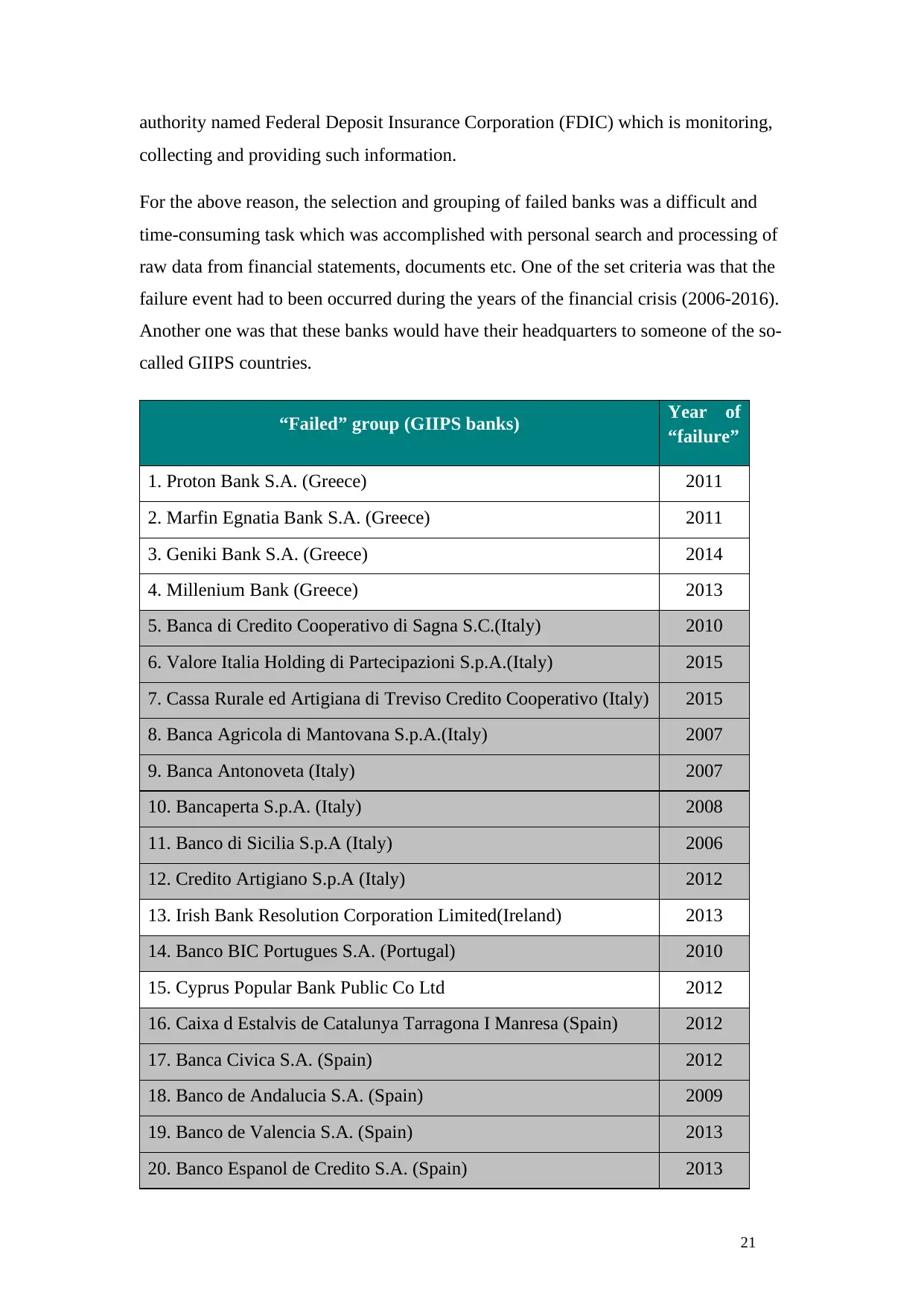
21
authority named Federal Deposit Insurance Corporation (FDIC) which is monitoring,
collecting and providing such information.
For the above reason, the selection and grouping of failed banks was a difficult and
time-consuming task which was accomplished with personal search and processing of
raw data from financial statements, documents etc. One of the set criteria was that the
failure event had to been occurred during the years of the financial crisis (2006-2016).
Another one was that these banks would have their headquarters to someone of the so-
called GIIPS countries.
“Failed” group (GIIPS banks) Year of
“failure”
1. Proton Bank S.A. (Greece) 2011
2. Marfin Egnatia Bank S.A. (Greece) 2011
3. Geniki Bank S.A. (Greece) 2014
4. Millenium Bank (Greece) 2013
5. Banca di Credito Cooperativo di Sagna S.C.(Italy) 2010
6. Valore Italia Holding di Partecipazioni S.p.A.(Italy) 2015
7. Cassa Rurale ed Artigiana di Treviso Credito Cooperativo (Italy) 2015
8. Banca Agricola di Mantovana S.p.A.(Italy) 2007
9. Banca Antonoveta (Italy) 2007
10. Bancaperta S.p.A. (Italy) 2008
11. Banco di Sicilia S.p.A (Italy) 2006
12. Credito Artigiano S.p.A (Italy) 2012
13. Irish Bank Resolution Corporation Limited(Ireland) 2013
14. Banco BIC Portugues S.A. (Portugal) 2010
15. Cyprus Popular Bank Public Co Ltd 2012
16. Caixa d Estalvis de Catalunya Tarragona I Manresa (Spain) 2012
17. Banca Civica S.A. (Spain) 2012
18. Banco de Andalucia S.A. (Spain) 2009
19. Banco de Valencia S.A. (Spain) 2013
20. Banco Espanol de Credito S.A. (Spain) 2013
authority named Federal Deposit Insurance Corporation (FDIC) which is monitoring,
collecting and providing such information.
For the above reason, the selection and grouping of failed banks was a difficult and
time-consuming task which was accomplished with personal search and processing of
raw data from financial statements, documents etc. One of the set criteria was that the
failure event had to been occurred during the years of the financial crisis (2006-2016).
Another one was that these banks would have their headquarters to someone of the so-
called GIIPS countries.
“Failed” group (GIIPS banks) Year of
“failure”
1. Proton Bank S.A. (Greece) 2011
2. Marfin Egnatia Bank S.A. (Greece) 2011
3. Geniki Bank S.A. (Greece) 2014
4. Millenium Bank (Greece) 2013
5. Banca di Credito Cooperativo di Sagna S.C.(Italy) 2010
6. Valore Italia Holding di Partecipazioni S.p.A.(Italy) 2015
7. Cassa Rurale ed Artigiana di Treviso Credito Cooperativo (Italy) 2015
8. Banca Agricola di Mantovana S.p.A.(Italy) 2007
9. Banca Antonoveta (Italy) 2007
10. Bancaperta S.p.A. (Italy) 2008
11. Banco di Sicilia S.p.A (Italy) 2006
12. Credito Artigiano S.p.A (Italy) 2012
13. Irish Bank Resolution Corporation Limited(Ireland) 2013
14. Banco BIC Portugues S.A. (Portugal) 2010
15. Cyprus Popular Bank Public Co Ltd 2012
16. Caixa d Estalvis de Catalunya Tarragona I Manresa (Spain) 2012
17. Banca Civica S.A. (Spain) 2012
18. Banco de Andalucia S.A. (Spain) 2009
19. Banco de Valencia S.A. (Spain) 2013
20. Banco Espanol de Credito S.A. (Spain) 2013
Paraphrase This Document
Need a fresh take? Get an instant paraphrase of this document with our AI Paraphraser
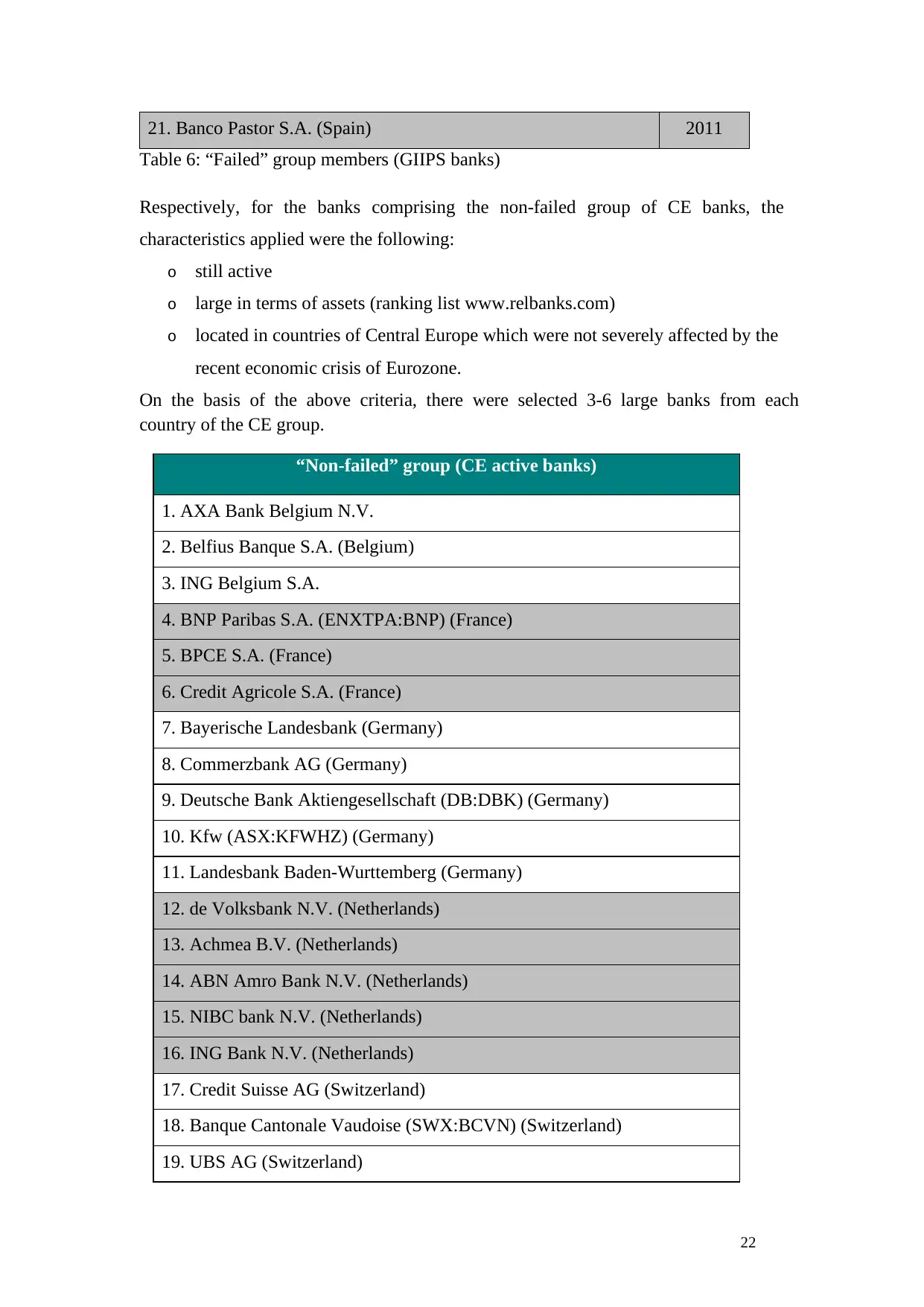
22
21. Banco Pastor S.A. (Spain) 2011
Table 6: “Failed” group members (GIIPS banks)
Respectively, for the banks comprising the non-failed group of CE banks, the
characteristics applied were the following:
o still active
o large in terms of assets (ranking list www.relbanks.com)
o located in countries of Central Europe which were not severely affected by the
recent economic crisis of Eurozone.
On the basis of the above criteria, there were selected 3-6 large banks from each
country of the CE group.
“Non-failed” group (CE active banks)
1. AXA Bank Belgium N.V.
2. Belfius Banque S.A. (Belgium)
3. ING Belgium S.A.
4. BNP Paribas S.A. (ENXTPA:BNP) (France)
5. BPCE S.A. (France)
6. Credit Agricole S.A. (France)
7. Bayerische Landesbank (Germany)
8. Commerzbank AG (Germany)
9. Deutsche Bank Aktiengesellschaft (DB:DBK) (Germany)
10. Kfw (ASX:KFWHZ) (Germany)
11. Landesbank Baden-Wurttemberg (Germany)
12. de Volksbank N.V. (Netherlands)
13. Achmea B.V. (Netherlands)
14. ABN Amro Bank N.V. (Netherlands)
15. NIBC bank N.V. (Netherlands)
16. ING Bank N.V. (Netherlands)
17. Credit Suisse AG (Switzerland)
18. Banque Cantonale Vaudoise (SWX:BCVN) (Switzerland)
19. UBS AG (Switzerland)
21. Banco Pastor S.A. (Spain) 2011
Table 6: “Failed” group members (GIIPS banks)
Respectively, for the banks comprising the non-failed group of CE banks, the
characteristics applied were the following:
o still active
o large in terms of assets (ranking list www.relbanks.com)
o located in countries of Central Europe which were not severely affected by the
recent economic crisis of Eurozone.
On the basis of the above criteria, there were selected 3-6 large banks from each
country of the CE group.
“Non-failed” group (CE active banks)
1. AXA Bank Belgium N.V.
2. Belfius Banque S.A. (Belgium)
3. ING Belgium S.A.
4. BNP Paribas S.A. (ENXTPA:BNP) (France)
5. BPCE S.A. (France)
6. Credit Agricole S.A. (France)
7. Bayerische Landesbank (Germany)
8. Commerzbank AG (Germany)
9. Deutsche Bank Aktiengesellschaft (DB:DBK) (Germany)
10. Kfw (ASX:KFWHZ) (Germany)
11. Landesbank Baden-Wurttemberg (Germany)
12. de Volksbank N.V. (Netherlands)
13. Achmea B.V. (Netherlands)
14. ABN Amro Bank N.V. (Netherlands)
15. NIBC bank N.V. (Netherlands)
16. ING Bank N.V. (Netherlands)
17. Credit Suisse AG (Switzerland)
18. Banque Cantonale Vaudoise (SWX:BCVN) (Switzerland)
19. UBS AG (Switzerland)

23
20. Raiffeisen Schweiz Genossenschaft (Switzerland)
21. Zurcher Kantonalbank (Switzerland)
Table 7: “Non-failed” group members (CE banks)
Methodology
The financial health assessment of the banks examined was performed by use of the
statistical Altman’s specialized model for firms from emerging markets. More
specifically, the following Z- score formula was applied to the data analysis
performed (Altman et al., 1995):
Z = 6.56X1 + 3.26X2 + 6.72X3 + 1.05X4 +3.26
Where:
Z = the score
X = the independent variables (ratios of)
X1: Working Capital/Total Assets
X2: Retained Earnings/Total Assets
X3: EBIT/Total Assets
X4: Book Value Equity/Total liabilities
All financial data to calculate the needed ratios for the formula application were
extracted from balance sheets and income statements of the sample banks. These were
accessed and retrieved via the S&P Capital IQ platform or directly from their
websites. The date of all financial documents used in this process was the 31st
December for each year of reference.
For testing the accuracy and predictability of the model used, the Z-scores for the
“failed” group members were estimated two years before the known “event” per each
case. For example, if a bank was merged on 2012, the Z-score was calculated for
years 2010 and 2011. Thus, the financial status of this bank was based on the average
of the estimated Z-score for these two years.
On the contrary, for the “non-failed” group members (still active CE banks) their Z-
score was explicitly estimated for years 2015 and 2016. Consequently, their financial
soundness was characterized on the basis of the calculated average of Z-score.
20. Raiffeisen Schweiz Genossenschaft (Switzerland)
21. Zurcher Kantonalbank (Switzerland)
Table 7: “Non-failed” group members (CE banks)
Methodology
The financial health assessment of the banks examined was performed by use of the
statistical Altman’s specialized model for firms from emerging markets. More
specifically, the following Z- score formula was applied to the data analysis
performed (Altman et al., 1995):
Z = 6.56X1 + 3.26X2 + 6.72X3 + 1.05X4 +3.26
Where:
Z = the score
X = the independent variables (ratios of)
X1: Working Capital/Total Assets
X2: Retained Earnings/Total Assets
X3: EBIT/Total Assets
X4: Book Value Equity/Total liabilities
All financial data to calculate the needed ratios for the formula application were
extracted from balance sheets and income statements of the sample banks. These were
accessed and retrieved via the S&P Capital IQ platform or directly from their
websites. The date of all financial documents used in this process was the 31st
December for each year of reference.
For testing the accuracy and predictability of the model used, the Z-scores for the
“failed” group members were estimated two years before the known “event” per each
case. For example, if a bank was merged on 2012, the Z-score was calculated for
years 2010 and 2011. Thus, the financial status of this bank was based on the average
of the estimated Z-score for these two years.
On the contrary, for the “non-failed” group members (still active CE banks) their Z-
score was explicitly estimated for years 2015 and 2016. Consequently, their financial
soundness was characterized on the basis of the calculated average of Z-score.
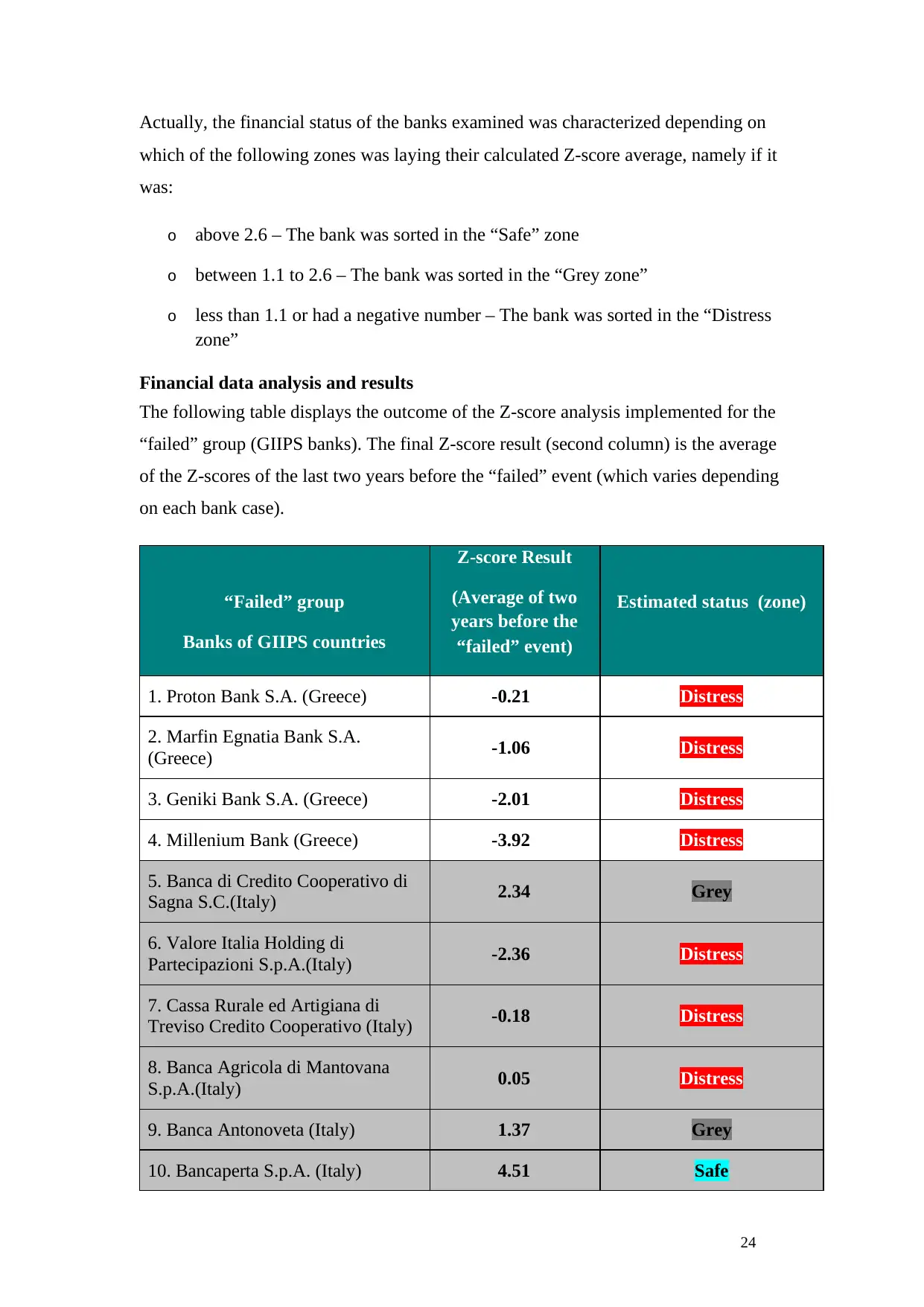
24
Actually, the financial status of the banks examined was characterized depending on
which of the following zones was laying their calculated Z-score average, namely if it
was:
o above 2.6 – The bank was sorted in the “Safe” zone
o between 1.1 to 2.6 – The bank was sorted in the “Grey zone”
o less than 1.1 or had a negative number – The bank was sorted in the “Distress
zone”
Financial data analysis and results
The following table displays the outcome of the Z-score analysis implemented for the
“failed” group (GIIPS banks). The final Z-score result (second column) is the average
of the Z-scores of the last two years before the “failed” event (which varies depending
on each bank case).
“Failed” group
Banks of GIIPS countries
Z-score Result
(Average of two
years before the
“failed” event)
Estimated status (zone)
1. Proton Bank S.A. (Greece) -0.21 Distress
2. Marfin Egnatia Bank S.A.
(Greece) -1.06 Distress
3. Geniki Bank S.A. (Greece) -2.01 Distress
4. Millenium Bank (Greece) -3.92 Distress
5. Banca di Credito Cooperativo di
Sagna S.C.(Italy) 2.34 Grey
6. Valore Italia Holding di
Partecipazioni S.p.A.(Italy) -2.36 Distress
7. Cassa Rurale ed Artigiana di
Treviso Credito Cooperativo (Italy) -0.18 Distress
8. Banca Agricola di Mantovana
S.p.A.(Italy) 0.05 Distress
9. Banca Antonoveta (Italy) 1.37 Grey
10. Bancaperta S.p.A. (Italy) 4.51 Safe
Actually, the financial status of the banks examined was characterized depending on
which of the following zones was laying their calculated Z-score average, namely if it
was:
o above 2.6 – The bank was sorted in the “Safe” zone
o between 1.1 to 2.6 – The bank was sorted in the “Grey zone”
o less than 1.1 or had a negative number – The bank was sorted in the “Distress
zone”
Financial data analysis and results
The following table displays the outcome of the Z-score analysis implemented for the
“failed” group (GIIPS banks). The final Z-score result (second column) is the average
of the Z-scores of the last two years before the “failed” event (which varies depending
on each bank case).
“Failed” group
Banks of GIIPS countries
Z-score Result
(Average of two
years before the
“failed” event)
Estimated status (zone)
1. Proton Bank S.A. (Greece) -0.21 Distress
2. Marfin Egnatia Bank S.A.
(Greece) -1.06 Distress
3. Geniki Bank S.A. (Greece) -2.01 Distress
4. Millenium Bank (Greece) -3.92 Distress
5. Banca di Credito Cooperativo di
Sagna S.C.(Italy) 2.34 Grey
6. Valore Italia Holding di
Partecipazioni S.p.A.(Italy) -2.36 Distress
7. Cassa Rurale ed Artigiana di
Treviso Credito Cooperativo (Italy) -0.18 Distress
8. Banca Agricola di Mantovana
S.p.A.(Italy) 0.05 Distress
9. Banca Antonoveta (Italy) 1.37 Grey
10. Bancaperta S.p.A. (Italy) 4.51 Safe
Secure Best Marks with AI Grader
Need help grading? Try our AI Grader for instant feedback on your assignments.
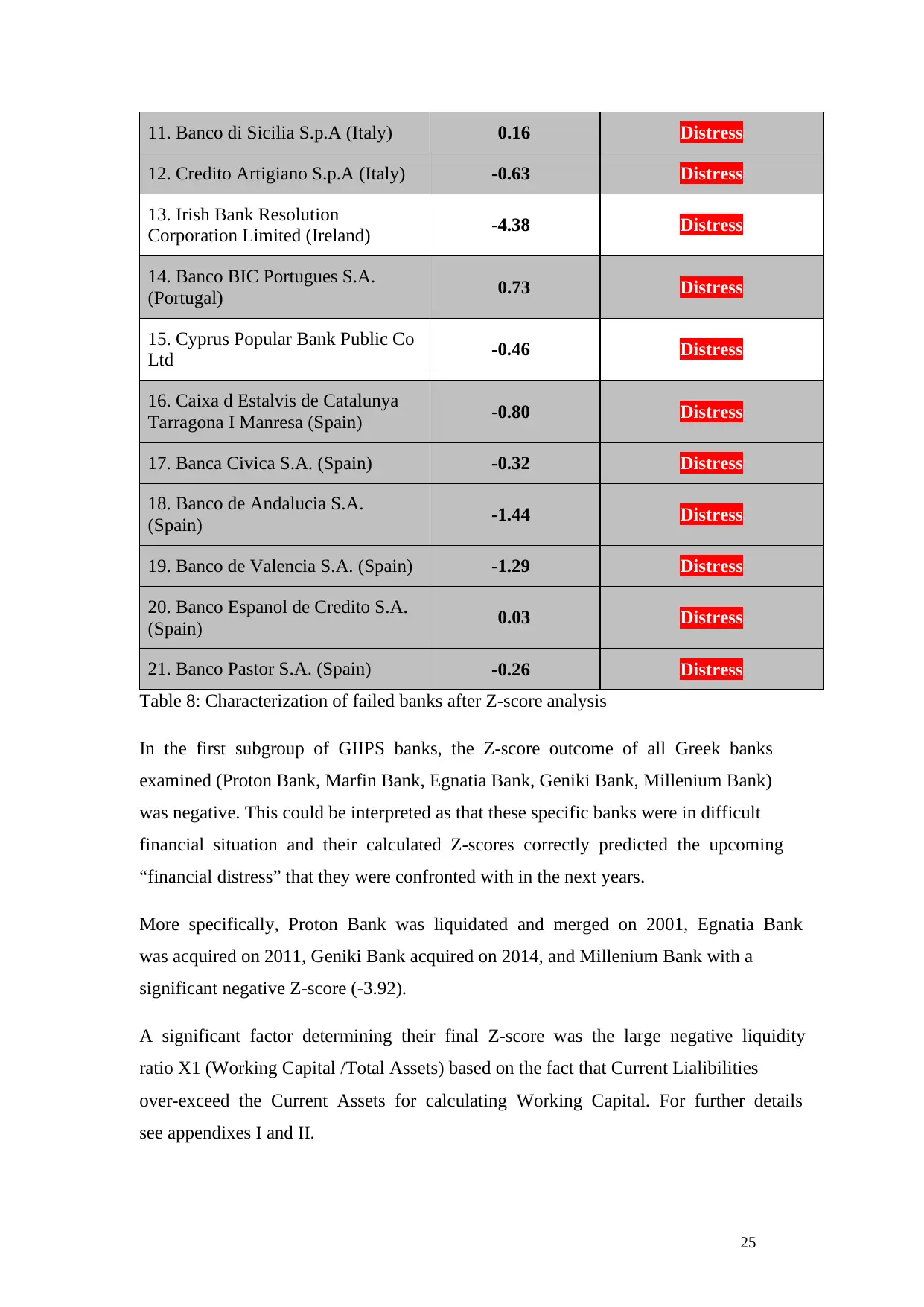
25
11. Banco di Sicilia S.p.A (Italy) 0.16 Distress
12. Credito Artigiano S.p.A (Italy) -0.63 Distress
13. Irish Bank Resolution
Corporation Limited (Ireland) -4.38 Distress
14. Banco BIC Portugues S.A.
(Portugal) 0.73 Distress
15. Cyprus Popular Bank Public Co
Ltd -0.46 Distress
16. Caixa d Estalvis de Catalunya
Tarragona I Manresa (Spain) -0.80 Distress
17. Banca Civica S.A. (Spain) -0.32 Distress
18. Banco de Andalucia S.A.
(Spain) -1.44 Distress
19. Banco de Valencia S.A. (Spain) -1.29 Distress
20. Banco Espanol de Credito S.A.
(Spain) 0.03 Distress
21. Banco Pastor S.A. (Spain) -0.26 Distress
Table 8: Characterization of failed banks after Z-score analysis
In the first subgroup of GIIPS banks, the Z-score outcome of all Greek banks
examined (Proton Bank, Marfin Bank, Egnatia Bank, Geniki Bank, Millenium Bank)
was negative. This could be interpreted as that these specific banks were in difficult
financial situation and their calculated Z-scores correctly predicted the upcoming
“financial distress” that they were confronted with in the next years.
More specifically, Proton Bank was liquidated and merged on 2001, Egnatia Bank
was acquired on 2011, Geniki Bank acquired on 2014, and Millenium Bank with a
significant negative Z-score (-3.92).
A significant factor determining their final Z-score was the large negative liquidity
ratio X1 (Working Capital /Total Assets) based on the fact that Current Lialibilities
over-exceed the Current Assets for calculating Working Capital. For further details
see appendixes I and II.
11. Banco di Sicilia S.p.A (Italy) 0.16 Distress
12. Credito Artigiano S.p.A (Italy) -0.63 Distress
13. Irish Bank Resolution
Corporation Limited (Ireland) -4.38 Distress
14. Banco BIC Portugues S.A.
(Portugal) 0.73 Distress
15. Cyprus Popular Bank Public Co
Ltd -0.46 Distress
16. Caixa d Estalvis de Catalunya
Tarragona I Manresa (Spain) -0.80 Distress
17. Banca Civica S.A. (Spain) -0.32 Distress
18. Banco de Andalucia S.A.
(Spain) -1.44 Distress
19. Banco de Valencia S.A. (Spain) -1.29 Distress
20. Banco Espanol de Credito S.A.
(Spain) 0.03 Distress
21. Banco Pastor S.A. (Spain) -0.26 Distress
Table 8: Characterization of failed banks after Z-score analysis
In the first subgroup of GIIPS banks, the Z-score outcome of all Greek banks
examined (Proton Bank, Marfin Bank, Egnatia Bank, Geniki Bank, Millenium Bank)
was negative. This could be interpreted as that these specific banks were in difficult
financial situation and their calculated Z-scores correctly predicted the upcoming
“financial distress” that they were confronted with in the next years.
More specifically, Proton Bank was liquidated and merged on 2001, Egnatia Bank
was acquired on 2011, Geniki Bank acquired on 2014, and Millenium Bank with a
significant negative Z-score (-3.92).
A significant factor determining their final Z-score was the large negative liquidity
ratio X1 (Working Capital /Total Assets) based on the fact that Current Lialibilities
over-exceed the Current Assets for calculating Working Capital. For further details
see appendixes I and II.

26
Italian banks composed the second subgroup. This was consisted of 8 banks which on
the basis of their calculated Z-score were sorted as follows: five in the “Distress
zone”, two in Grey zone and the last one in “Safe zone”. Again Z-score proved its
high precision and effectiveness acting as distress indicator Banca di Credito
Cooperativo (2.34) was acquired on 2010, Valore Italia Holding (-2.36) acquired on
2015, Cassa Rurale ed Artigiana (-0.18) acquired on 2015, Banca Agricola (0.05) was
acquired on 2007, Banka Antonoveta (1.37) was acquired on 2007, Banco di Sicilia
(0.16) merged on 2006, and Credito Artigiano (-0.63) acquired on 2012. The
Bancaperta Spa with 4.51 final Z-score (Safe Zone) was a positive exception that
merged with another bank by acquiring it.
The third subgroup of banks was from Spain. It was consisted from 6 small banks.
The whole sample from Spain was classified to the “Distress zone” due to the
negative Z-scores achieved. In this case too, the significant factor of a very high
negative liquidity ratio due to over-exceeding current liabilities to current assets
determined the final outcome. Caixa d Estalvis de Catalanya (-0.8) acquired on 2012,
Banca Civica (-0.32) acquired on 2012, Banco de Andalucia (-1.44) acquired on 2009,
Banco de Valencia (-1.29) acquired-merged on 2013, Banco Espanol de Credito
(0.033) acquired on 2013, and Banco Pastor (-0.26) acquired-merged.
The last subgroup is a multinational one since it incorporates three banks from three
different European Countries, namely Ireland, Portugal and Cyprus. The Irish Bank
Resolution had a negative Z-score (-4.38) which was also the highest of the whole
sample. The result indicated that the bank was in a very bad financial situation which
later was actually confirmed by the bank’s liquidation on 2013. In this specific case,
Z-score was significantly affected from the negative Working Capital, the negative
Retained Earnings and consequently by EBIT. The Portuguese Banco Bic had also a
low Z-score by which it was classified to the distress zone. Finally, in the case of the
Cyprus Popular bank, that was defaulted on 2012, the achieved Z-score was a strong
indication for immerse financial danger.
Italian banks composed the second subgroup. This was consisted of 8 banks which on
the basis of their calculated Z-score were sorted as follows: five in the “Distress
zone”, two in Grey zone and the last one in “Safe zone”. Again Z-score proved its
high precision and effectiveness acting as distress indicator Banca di Credito
Cooperativo (2.34) was acquired on 2010, Valore Italia Holding (-2.36) acquired on
2015, Cassa Rurale ed Artigiana (-0.18) acquired on 2015, Banca Agricola (0.05) was
acquired on 2007, Banka Antonoveta (1.37) was acquired on 2007, Banco di Sicilia
(0.16) merged on 2006, and Credito Artigiano (-0.63) acquired on 2012. The
Bancaperta Spa with 4.51 final Z-score (Safe Zone) was a positive exception that
merged with another bank by acquiring it.
The third subgroup of banks was from Spain. It was consisted from 6 small banks.
The whole sample from Spain was classified to the “Distress zone” due to the
negative Z-scores achieved. In this case too, the significant factor of a very high
negative liquidity ratio due to over-exceeding current liabilities to current assets
determined the final outcome. Caixa d Estalvis de Catalanya (-0.8) acquired on 2012,
Banca Civica (-0.32) acquired on 2012, Banco de Andalucia (-1.44) acquired on 2009,
Banco de Valencia (-1.29) acquired-merged on 2013, Banco Espanol de Credito
(0.033) acquired on 2013, and Banco Pastor (-0.26) acquired-merged.
The last subgroup is a multinational one since it incorporates three banks from three
different European Countries, namely Ireland, Portugal and Cyprus. The Irish Bank
Resolution had a negative Z-score (-4.38) which was also the highest of the whole
sample. The result indicated that the bank was in a very bad financial situation which
later was actually confirmed by the bank’s liquidation on 2013. In this specific case,
Z-score was significantly affected from the negative Working Capital, the negative
Retained Earnings and consequently by EBIT. The Portuguese Banco Bic had also a
low Z-score by which it was classified to the distress zone. Finally, in the case of the
Cyprus Popular bank, that was defaulted on 2012, the achieved Z-score was a strong
indication for immerse financial danger.
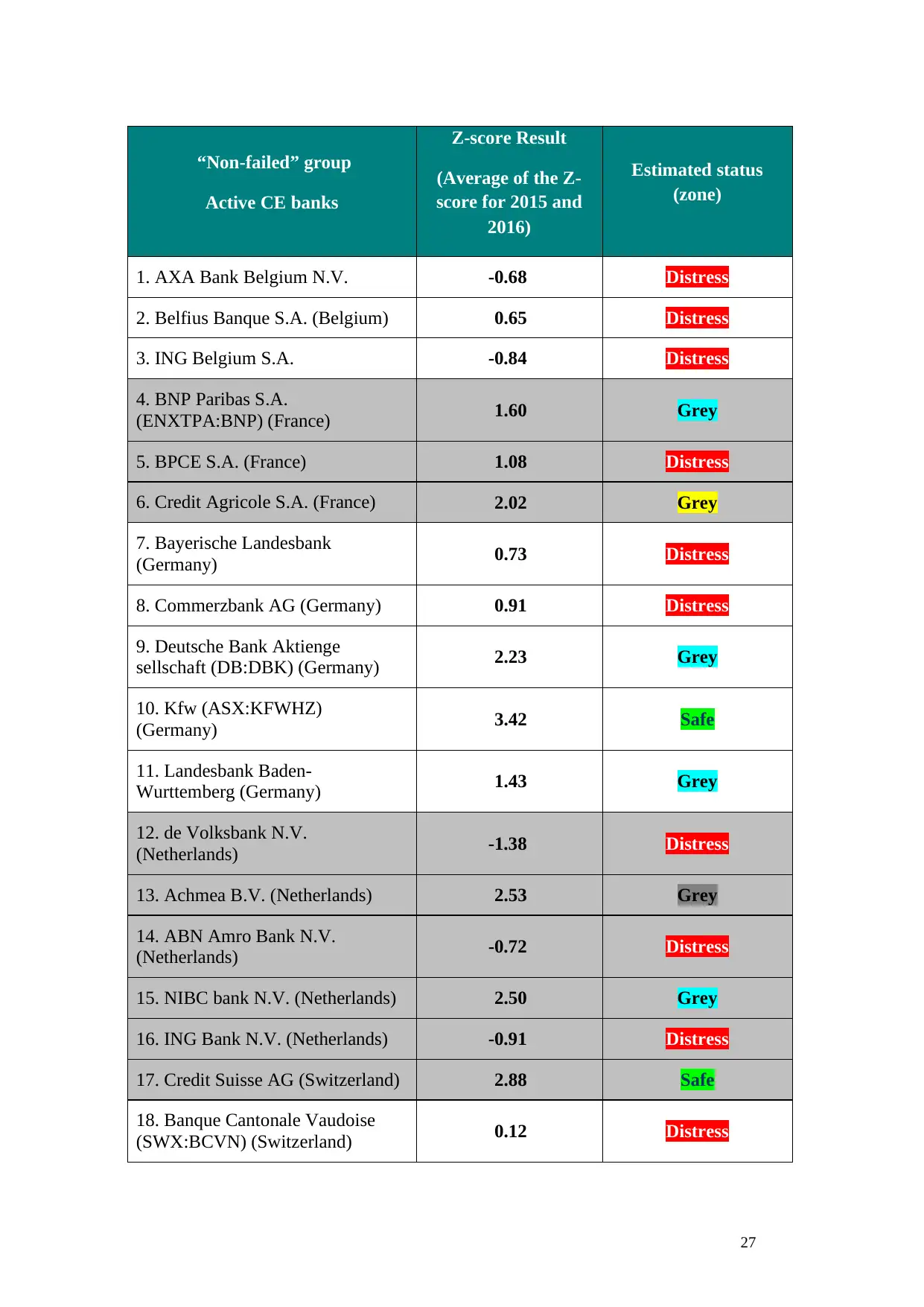
27
“Non-failed” group
Active CE banks
Z-score Result
(Average of the Z-
score for 2015 and
2016)
Estimated status
(zone)
1. AXA Bank Belgium N.V. -0.68 Distress
2. Belfius Banque S.A. (Belgium) 0.65 Distress
3. ING Belgium S.A. -0.84 Distress
4. BNP Paribas S.A.
(ENXTPA:BNP) (France) 1.60 Grey
5. BPCE S.A. (France) 1.08 Distress
6. Credit Agricole S.A. (France) 2.02 Grey
7. Bayerische Landesbank
(Germany) 0.73 Distress
8. Commerzbank AG (Germany) 0.91 Distress
9. Deutsche Bank Aktienge
sellschaft (DB:DBK) (Germany) 2.23 Grey
10. Kfw (ASX:KFWHZ)
(Germany) 3.42 Safe
11. Landesbank Baden-
Wurttemberg (Germany) 1.43 Grey
12. de Volksbank N.V.
(Netherlands) -1.38 Distress
13. Achmea B.V. (Netherlands) 2.53 Grey
14. ABN Amro Bank N.V.
(Netherlands) -0.72 Distress
15. NIBC bank N.V. (Netherlands) 2.50 Grey
16. ING Bank N.V. (Netherlands) -0.91 Distress
17. Credit Suisse AG (Switzerland) 2.88 Safe
18. Banque Cantonale Vaudoise
(SWX:BCVN) (Switzerland) 0.12 Distress
“Non-failed” group
Active CE banks
Z-score Result
(Average of the Z-
score for 2015 and
2016)
Estimated status
(zone)
1. AXA Bank Belgium N.V. -0.68 Distress
2. Belfius Banque S.A. (Belgium) 0.65 Distress
3. ING Belgium S.A. -0.84 Distress
4. BNP Paribas S.A.
(ENXTPA:BNP) (France) 1.60 Grey
5. BPCE S.A. (France) 1.08 Distress
6. Credit Agricole S.A. (France) 2.02 Grey
7. Bayerische Landesbank
(Germany) 0.73 Distress
8. Commerzbank AG (Germany) 0.91 Distress
9. Deutsche Bank Aktienge
sellschaft (DB:DBK) (Germany) 2.23 Grey
10. Kfw (ASX:KFWHZ)
(Germany) 3.42 Safe
11. Landesbank Baden-
Wurttemberg (Germany) 1.43 Grey
12. de Volksbank N.V.
(Netherlands) -1.38 Distress
13. Achmea B.V. (Netherlands) 2.53 Grey
14. ABN Amro Bank N.V.
(Netherlands) -0.72 Distress
15. NIBC bank N.V. (Netherlands) 2.50 Grey
16. ING Bank N.V. (Netherlands) -0.91 Distress
17. Credit Suisse AG (Switzerland) 2.88 Safe
18. Banque Cantonale Vaudoise
(SWX:BCVN) (Switzerland) 0.12 Distress
Paraphrase This Document
Need a fresh take? Get an instant paraphrase of this document with our AI Paraphraser
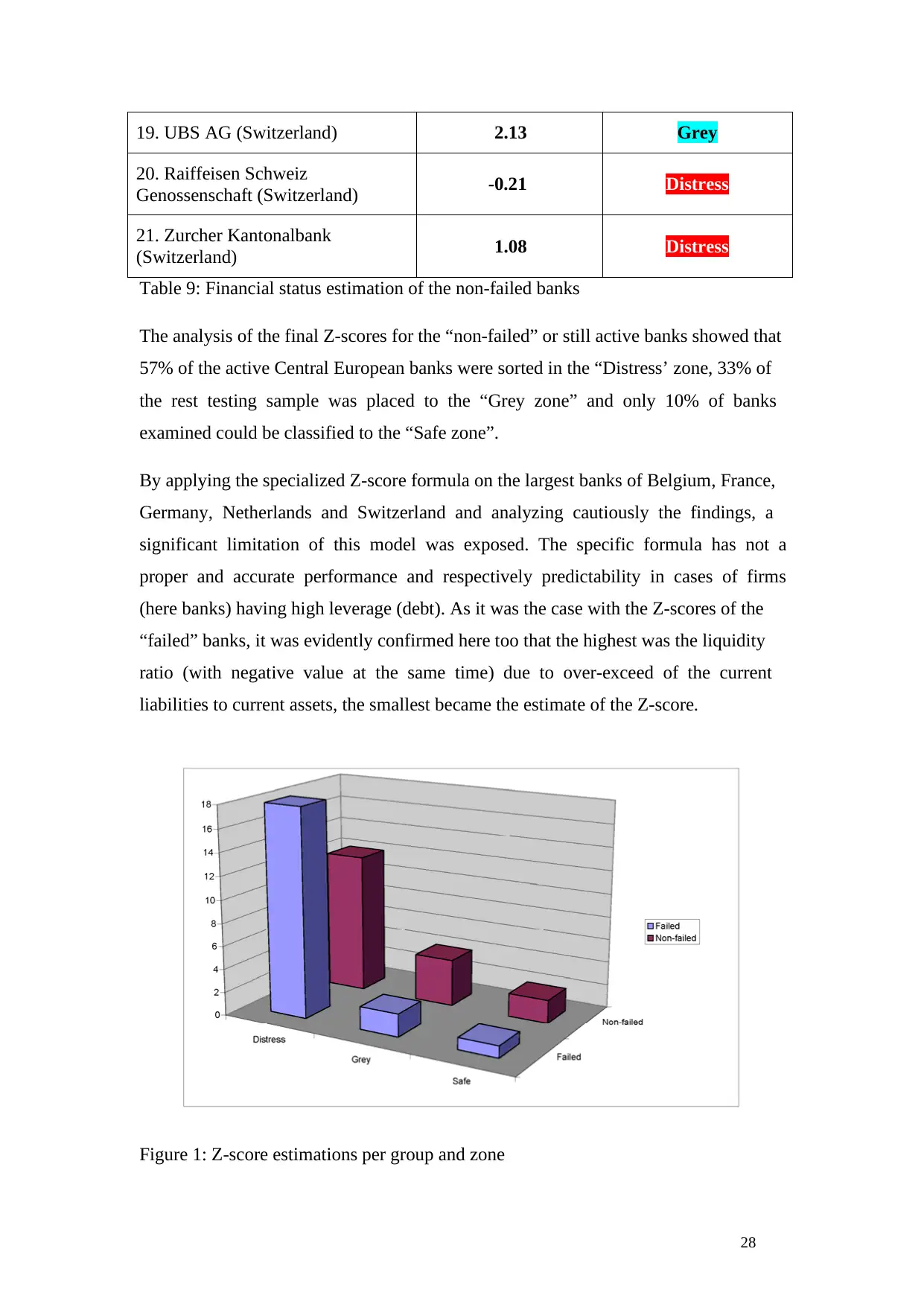
28
Table 9: Financial status estimation of the non-failed banks
The analysis of the final Z-scores for the “non-failed” or still active banks showed that
57% of the active Central European banks were sorted in the “Distress’ zone, 33% of
the rest testing sample was placed to the “Grey zone” and only 10% of banks
examined could be classified to the “Safe zone”.
By applying the specialized Z-score formula on the largest banks of Belgium, France,
Germany, Netherlands and Switzerland and analyzing cautiously the findings, a
significant limitation of this model was exposed. The specific formula has not a
proper and accurate performance and respectively predictability in cases of firms
(here banks) having high leverage (debt). As it was the case with the Z-scores of the
“failed” banks, it was evidently confirmed here too that the highest was the liquidity
ratio (with negative value at the same time) due to over-exceed of the current
liabilities to current assets, the smallest became the estimate of the Z-score.
Figure 1: Z-score estimations per group and zone
19. UBS AG (Switzerland) 2.13 Grey
20. Raiffeisen Schweiz
Genossenschaft (Switzerland) -0.21 Distress
21. Zurcher Kantonalbank
(Switzerland) 1.08 Distress
Table 9: Financial status estimation of the non-failed banks
The analysis of the final Z-scores for the “non-failed” or still active banks showed that
57% of the active Central European banks were sorted in the “Distress’ zone, 33% of
the rest testing sample was placed to the “Grey zone” and only 10% of banks
examined could be classified to the “Safe zone”.
By applying the specialized Z-score formula on the largest banks of Belgium, France,
Germany, Netherlands and Switzerland and analyzing cautiously the findings, a
significant limitation of this model was exposed. The specific formula has not a
proper and accurate performance and respectively predictability in cases of firms
(here banks) having high leverage (debt). As it was the case with the Z-scores of the
“failed” banks, it was evidently confirmed here too that the highest was the liquidity
ratio (with negative value at the same time) due to over-exceed of the current
liabilities to current assets, the smallest became the estimate of the Z-score.
Figure 1: Z-score estimations per group and zone
19. UBS AG (Switzerland) 2.13 Grey
20. Raiffeisen Schweiz
Genossenschaft (Switzerland) -0.21 Distress
21. Zurcher Kantonalbank
(Switzerland) 1.08 Distress
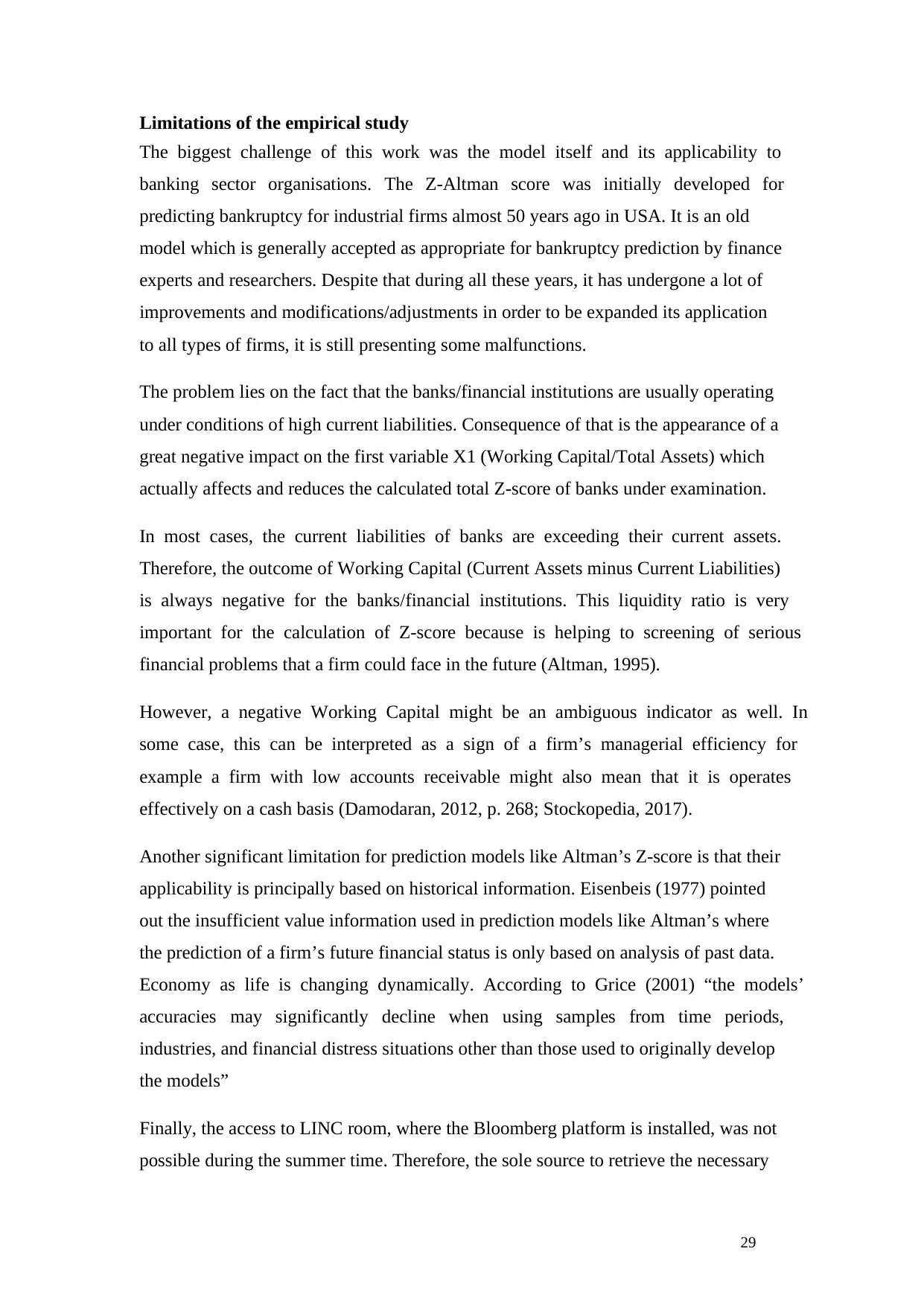
29
Limitations of the empirical study
The biggest challenge of this work was the model itself and its applicability to
banking sector organisations. The Z-Altman score was initially developed for
predicting bankruptcy for industrial firms almost 50 years ago in USA. It is an old
model which is generally accepted as appropriate for bankruptcy prediction by finance
experts and researchers. Despite that during all these years, it has undergone a lot of
improvements and modifications/adjustments in order to be expanded its application
to all types of firms, it is still presenting some malfunctions.
The problem lies on the fact that the banks/financial institutions are usually operating
under conditions of high current liabilities. Consequence of that is the appearance of a
great negative impact on the first variable X1 (Working Capital/Total Assets) which
actually affects and reduces the calculated total Z-score of banks under examination.
In most cases, the current liabilities of banks are exceeding their current assets.
Therefore, the outcome of Working Capital (Current Assets minus Current Liabilities)
is always negative for the banks/financial institutions. This liquidity ratio is very
important for the calculation of Z-score because is helping to screening of serious
financial problems that a firm could face in the future (Altman, 1995).
However, a negative Working Capital might be an ambiguous indicator as well. In
some case, this can be interpreted as a sign of a firm’s managerial efficiency for
example a firm with low accounts receivable might also mean that it is operates
effectively on a cash basis (Damodaran, 2012, p. 268; Stockopedia, 2017).
Another significant limitation for prediction models like Altman’s Z-score is that their
applicability is principally based on historical information. Eisenbeis (1977) pointed
out the insufficient value information used in prediction models like Altman’s where
the prediction of a firm’s future financial status is only based on analysis of past data.
Economy as life is changing dynamically. According to Grice (2001) “the models’
accuracies may significantly decline when using samples from time periods,
industries, and financial distress situations other than those used to originally develop
the models”
Finally, the access to LINC room, where the Bloomberg platform is installed, was not
possible during the summer time. Therefore, the sole source to retrieve the necessary
Limitations of the empirical study
The biggest challenge of this work was the model itself and its applicability to
banking sector organisations. The Z-Altman score was initially developed for
predicting bankruptcy for industrial firms almost 50 years ago in USA. It is an old
model which is generally accepted as appropriate for bankruptcy prediction by finance
experts and researchers. Despite that during all these years, it has undergone a lot of
improvements and modifications/adjustments in order to be expanded its application
to all types of firms, it is still presenting some malfunctions.
The problem lies on the fact that the banks/financial institutions are usually operating
under conditions of high current liabilities. Consequence of that is the appearance of a
great negative impact on the first variable X1 (Working Capital/Total Assets) which
actually affects and reduces the calculated total Z-score of banks under examination.
In most cases, the current liabilities of banks are exceeding their current assets.
Therefore, the outcome of Working Capital (Current Assets minus Current Liabilities)
is always negative for the banks/financial institutions. This liquidity ratio is very
important for the calculation of Z-score because is helping to screening of serious
financial problems that a firm could face in the future (Altman, 1995).
However, a negative Working Capital might be an ambiguous indicator as well. In
some case, this can be interpreted as a sign of a firm’s managerial efficiency for
example a firm with low accounts receivable might also mean that it is operates
effectively on a cash basis (Damodaran, 2012, p. 268; Stockopedia, 2017).
Another significant limitation for prediction models like Altman’s Z-score is that their
applicability is principally based on historical information. Eisenbeis (1977) pointed
out the insufficient value information used in prediction models like Altman’s where
the prediction of a firm’s future financial status is only based on analysis of past data.
Economy as life is changing dynamically. According to Grice (2001) “the models’
accuracies may significantly decline when using samples from time periods,
industries, and financial distress situations other than those used to originally develop
the models”
Finally, the access to LINC room, where the Bloomberg platform is installed, was not
possible during the summer time. Therefore, the sole source to retrieve the necessary

30
financial data was S&P Capital Iq platform where balance sheets for a few “failed”
banks were not available. In these cases, the necessary information was retrieved from
financial statements and documents uploaded on the bank websites.
Therefore, a cross-checking of the retrieved financial data for these banks was not
possible.
financial data was S&P Capital Iq platform where balance sheets for a few “failed”
banks were not available. In these cases, the necessary information was retrieved from
financial statements and documents uploaded on the bank websites.
Therefore, a cross-checking of the retrieved financial data for these banks was not
possible.
Secure Best Marks with AI Grader
Need help grading? Try our AI Grader for instant feedback on your assignments.

31
Conclusions
In this work was attempted a testing and evaluation of the strength and the
effectiveness of Altman’s Z-score model in predicting financial distress in the
European banking sector. Following the specifications of the Altman’s Z-score model,
the testing sample was consisted of two groups. The first included “failed” banks from
countries that faced huge economic problems in the period of financial crisis (2006-
2016). The second was comprised of large banks from Central Europe which are still
active.
The estimated results of the “failed” group were 100% confirmed which is indicating
that Altman’s Z-score model might be an effective indicator of financial distress 2
years prior to a known “failure” event. However, some drawbacks of the specialized
model for firms from emerging markets were revealed too. Actually, the results
achieved from the financial data processing of the “non-failed” group (still active CE
banks) made discernible a significant limitation. More specifically, the calculated Z-
scores of this group were low and indicated that 12 banks might possibly be
threatened by direct financial distress in the next years, 7 banks are placed in the grey
zone signaling concerns about their financial situation and only two were in the “safe”
zone. The problem is caused form the fact that liquidity ratio (X1 model’s variable),
in most cases, was negative something that affected directly the final outcome of Z-
score and respectively the characterization of the financial health of the banks
examined. It seems that the accuracy and predictability of the tested Altman model,
specialized for emerging markets, is questionable as regards predictions for private
firms with high leverage.
Shumway (1999) proved that the Z-score model is dead and totally not trustworthy
anymore about use on predicting corporate bankruptcy. He claimed that half of
Altman variables have poor predictive strength. Therefore, he proposed a model with
market-driven variables and two accounting ratios. According to Shumway (1999)
this was considered as more accurate in out-of-sample tests than Altman’s Z-score
model. Chava & Jarrow (2004) validated the superiority of Shumway’s model against
Altman’s Z-score model by confirming the crucial element of introducing industry
effects in the hazard rate models.
Conclusions
In this work was attempted a testing and evaluation of the strength and the
effectiveness of Altman’s Z-score model in predicting financial distress in the
European banking sector. Following the specifications of the Altman’s Z-score model,
the testing sample was consisted of two groups. The first included “failed” banks from
countries that faced huge economic problems in the period of financial crisis (2006-
2016). The second was comprised of large banks from Central Europe which are still
active.
The estimated results of the “failed” group were 100% confirmed which is indicating
that Altman’s Z-score model might be an effective indicator of financial distress 2
years prior to a known “failure” event. However, some drawbacks of the specialized
model for firms from emerging markets were revealed too. Actually, the results
achieved from the financial data processing of the “non-failed” group (still active CE
banks) made discernible a significant limitation. More specifically, the calculated Z-
scores of this group were low and indicated that 12 banks might possibly be
threatened by direct financial distress in the next years, 7 banks are placed in the grey
zone signaling concerns about their financial situation and only two were in the “safe”
zone. The problem is caused form the fact that liquidity ratio (X1 model’s variable),
in most cases, was negative something that affected directly the final outcome of Z-
score and respectively the characterization of the financial health of the banks
examined. It seems that the accuracy and predictability of the tested Altman model,
specialized for emerging markets, is questionable as regards predictions for private
firms with high leverage.
Shumway (1999) proved that the Z-score model is dead and totally not trustworthy
anymore about use on predicting corporate bankruptcy. He claimed that half of
Altman variables have poor predictive strength. Therefore, he proposed a model with
market-driven variables and two accounting ratios. According to Shumway (1999)
this was considered as more accurate in out-of-sample tests than Altman’s Z-score
model. Chava & Jarrow (2004) validated the superiority of Shumway’s model against
Altman’s Z-score model by confirming the crucial element of introducing industry
effects in the hazard rate models.

32
Based on the findings of this work, one may claim that Altman’s Z-score model,
specialized for firms from emerging markets, is somehow outdated and has to be
handled in a very cautious way, especially in predictions concerning banking sector
organisations. Further improvement of the Altman’s Z-score model is needed in order
to be a trustworthy prediction tool for private firms (banks) operating with high
leverage. Perhaps, Altman will soon provide us with one more Z-score formula which
will be more appropriate for use with banks/financial institutions. This will be a new
research challenge for finance researchers.
Based on the findings of this work, one may claim that Altman’s Z-score model,
specialized for firms from emerging markets, is somehow outdated and has to be
handled in a very cautious way, especially in predictions concerning banking sector
organisations. Further improvement of the Altman’s Z-score model is needed in order
to be a trustworthy prediction tool for private firms (banks) operating with high
leverage. Perhaps, Altman will soon provide us with one more Z-score formula which
will be more appropriate for use with banks/financial institutions. This will be a new
research challenge for finance researchers.

33
References
Altman, Edward I. (1968). Financial Ratios, discriminant analysis and the Prediction
of Corporate Bankruptcy. Journal of Finance, pp. 189–209. doi:10.1111/j.1540-
6261.1968.tb00843.x
Altman, Edward I. (1977). The Z-Score Bankruptcy Model: Past, Present, and Future
in Financial crises: institutions and markets in a fragile environment. - New York
[u.a.] : John Wiley & Sons, ISBN 0471026859. - 1977, pp. 89-108.
Altman, Edward I. (1993). Corporate Financial Distress and Bankruptcy: A Complete
Guide to Predicting and Avoiding Distress and Profiting from Bankruptcy, 2nd Edn.
New York: John Wiley and Sons.
Altman E.I. Hartzell J. Peck M. (1995). Emerging Markets Corporate Bonds: A
Scoring System. Salomon Brothers Inc. New York, and in Levich, R. and Mei, J.P.
The Future of Emerging Market Flaws. Kluwer and revisited in Altman, E.I. and
Hotchkiss, E. (2006) Corporate Financial Distress & Bankruptcy. J. Wiley & Sons.
Altman, Edward I. (2000). Predicting Financial Distress of Companies: Revisiting the
Z-score and Zeta Models. [pdf] Available at: http://pages.stern.nyu.edu/~ealtman/
PredFnclDistr.pdf [Accessed on 06-07-2017]
Altman E.I. (2002). Revisiting Credit Scoring Models in a Basel 2 Environment.
Salomon Center for the Study of Financial Institutions, 2(1): pp.2-37.
Altman, E.I, Danovi, A. and Falini, A. (2013). Z-Score Models'Application to Italian
Companies Subject to Extraordinary Administration. Journal of Applied Finance,
23(1), pp. 128-137.
Beaver, W. H. (1966a). Financial ratios as predictors of failure. Empirical Research in
Accounting: Selected Studies, 71-111.
Beaver, W. H. (1966b). Market prices, financial ratios, and the prediction of failure.
Journal of Accounting Research, 6(2), pp. 179-182.
Bellovary, J., Giacomino, D. and Akers M. (2007). A Review of Bankruptcy
Prediction Studies: 1930 to Present, Journal of Financial Education, Vol. 33 (Winter),
1-42.
Chava, Sudheer and Jarrow, Robert A., (2004). Bankruptcy Prediction with Industry
Effects, Review of Finance, Kluwer Academic Publishers, Vol. 8, pp. 537–569.
Cybinski, Patti, (2001). "Description, explanation, prediction – the evolution of
bankruptcy studies?", Managerial Finance, Vol. 27 Issue: 4, pp.29-44.
Damodaran Aswath (2012). Investment Valuation: Tools and Techniques for
Determining the Value of any Asset, University Edition, Wiley Finance, John Wiley
& Sons, ISBN: 9781118206591.
References
Altman, Edward I. (1968). Financial Ratios, discriminant analysis and the Prediction
of Corporate Bankruptcy. Journal of Finance, pp. 189–209. doi:10.1111/j.1540-
6261.1968.tb00843.x
Altman, Edward I. (1977). The Z-Score Bankruptcy Model: Past, Present, and Future
in Financial crises: institutions and markets in a fragile environment. - New York
[u.a.] : John Wiley & Sons, ISBN 0471026859. - 1977, pp. 89-108.
Altman, Edward I. (1993). Corporate Financial Distress and Bankruptcy: A Complete
Guide to Predicting and Avoiding Distress and Profiting from Bankruptcy, 2nd Edn.
New York: John Wiley and Sons.
Altman E.I. Hartzell J. Peck M. (1995). Emerging Markets Corporate Bonds: A
Scoring System. Salomon Brothers Inc. New York, and in Levich, R. and Mei, J.P.
The Future of Emerging Market Flaws. Kluwer and revisited in Altman, E.I. and
Hotchkiss, E. (2006) Corporate Financial Distress & Bankruptcy. J. Wiley & Sons.
Altman, Edward I. (2000). Predicting Financial Distress of Companies: Revisiting the
Z-score and Zeta Models. [pdf] Available at: http://pages.stern.nyu.edu/~ealtman/
PredFnclDistr.pdf [Accessed on 06-07-2017]
Altman E.I. (2002). Revisiting Credit Scoring Models in a Basel 2 Environment.
Salomon Center for the Study of Financial Institutions, 2(1): pp.2-37.
Altman, E.I, Danovi, A. and Falini, A. (2013). Z-Score Models'Application to Italian
Companies Subject to Extraordinary Administration. Journal of Applied Finance,
23(1), pp. 128-137.
Beaver, W. H. (1966a). Financial ratios as predictors of failure. Empirical Research in
Accounting: Selected Studies, 71-111.
Beaver, W. H. (1966b). Market prices, financial ratios, and the prediction of failure.
Journal of Accounting Research, 6(2), pp. 179-182.
Bellovary, J., Giacomino, D. and Akers M. (2007). A Review of Bankruptcy
Prediction Studies: 1930 to Present, Journal of Financial Education, Vol. 33 (Winter),
1-42.
Chava, Sudheer and Jarrow, Robert A., (2004). Bankruptcy Prediction with Industry
Effects, Review of Finance, Kluwer Academic Publishers, Vol. 8, pp. 537–569.
Cybinski, Patti, (2001). "Description, explanation, prediction – the evolution of
bankruptcy studies?", Managerial Finance, Vol. 27 Issue: 4, pp.29-44.
Damodaran Aswath (2012). Investment Valuation: Tools and Techniques for
Determining the Value of any Asset, University Edition, Wiley Finance, John Wiley
& Sons, ISBN: 9781118206591.
Paraphrase This Document
Need a fresh take? Get an instant paraphrase of this document with our AI Paraphraser
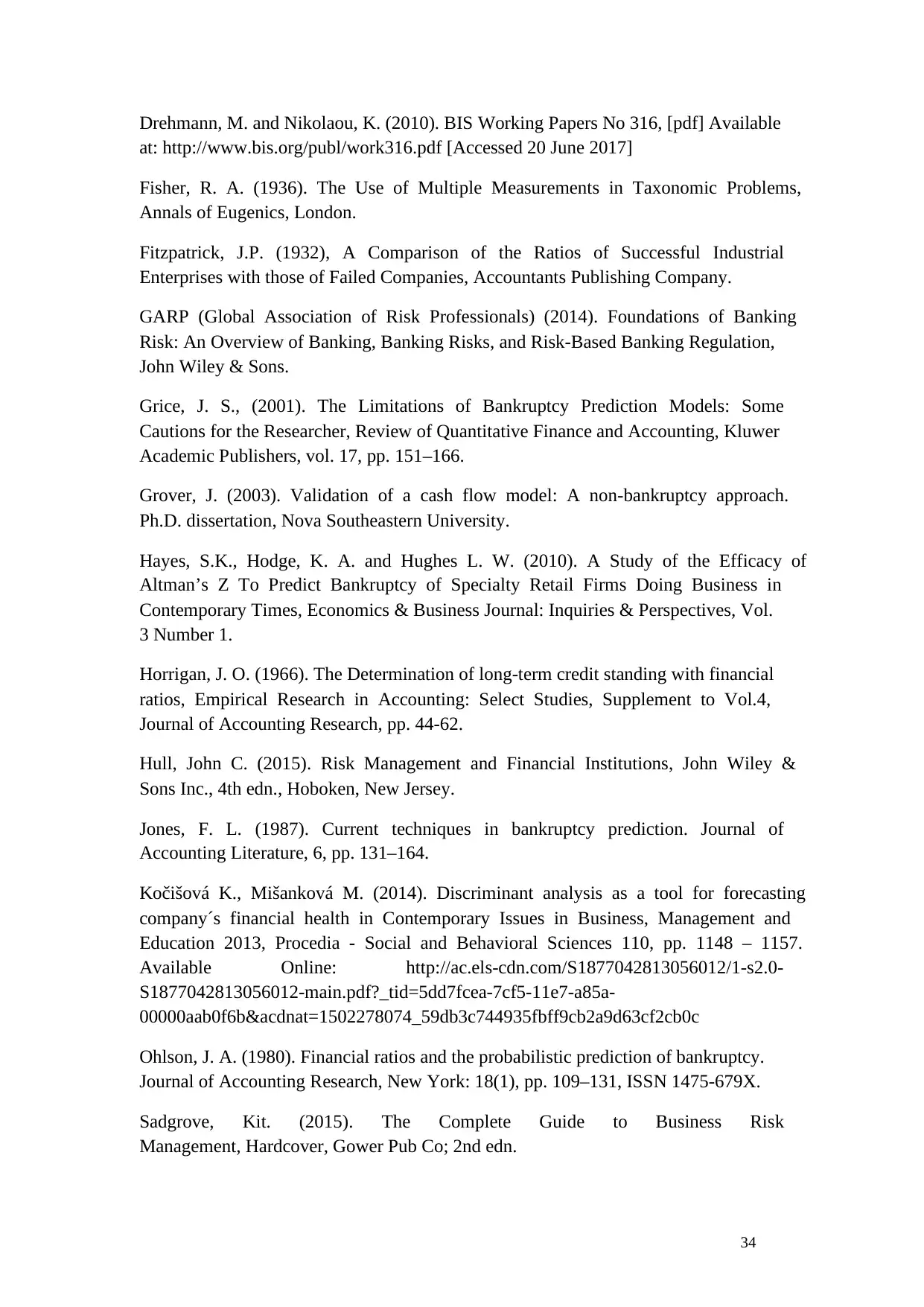
34
Drehmann, M. and Nikolaou, K. (2010). BIS Working Papers No 316, [pdf] Available
at: http://www.bis.org/publ/work316.pdf [Accessed 20 June 2017]
Fisher, R. A. (1936). The Use of Multiple Measurements in Taxonomic Problems,
Annals of Eugenics, London.
Fitzpatrick, J.P. (1932), A Comparison of the Ratios of Successful Industrial
Enterprises with those of Failed Companies, Accountants Publishing Company.
GARP (Global Association of Risk Professionals) (2014). Foundations of Banking
Risk: An Overview of Banking, Banking Risks, and Risk-Based Banking Regulation,
John Wiley & Sons.
Grice, J. S., (2001). The Limitations of Bankruptcy Prediction Models: Some
Cautions for the Researcher, Review of Quantitative Finance and Accounting, Kluwer
Academic Publishers, vol. 17, pp. 151–166.
Grover, J. (2003). Validation of a cash flow model: A non-bankruptcy approach.
Ph.D. dissertation, Nova Southeastern University.
Hayes, S.K., Hodge, K. A. and Hughes L. W. (2010). A Study of the Efficacy of
Altman’s Z To Predict Bankruptcy of Specialty Retail Firms Doing Business in
Contemporary Times, Economics & Business Journal: Inquiries & Perspectives, Vol.
3 Number 1.
Horrigan, J. O. (1966). The Determination of long-term credit standing with financial
ratios, Empirical Research in Accounting: Select Studies, Supplement to Vol.4,
Journal of Accounting Research, pp. 44-62.
Hull, John C. (2015). Risk Management and Financial Institutions, John Wiley &
Sons Inc., 4th edn., Hoboken, New Jersey.
Jones, F. L. (1987). Current techniques in bankruptcy prediction. Journal of
Accounting Literature, 6, pp. 131–164.
Kočišová K., Mišanková M. (2014). Discriminant analysis as a tool for forecasting
company´s financial health in Contemporary Issues in Business, Management and
Education 2013, Procedia - Social and Behavioral Sciences 110, pp. 1148 – 1157.
Available Online: http://ac.els-cdn.com/S1877042813056012/1-s2.0-
S1877042813056012-main.pdf?_tid=5dd7fcea-7cf5-11e7-a85a-
00000aab0f6b&acdnat=1502278074_59db3c744935fbff9cb2a9d63cf2cb0c
Ohlson, J. A. (1980). Financial ratios and the probabilistic prediction of bankruptcy.
Journal of Accounting Research, New York: 18(1), pp. 109–131, ISSN 1475-679X.
Sadgrove, Kit. (2015). The Complete Guide to Business Risk
Management, Hardcover, Gower Pub Co; 2nd edn.
Drehmann, M. and Nikolaou, K. (2010). BIS Working Papers No 316, [pdf] Available
at: http://www.bis.org/publ/work316.pdf [Accessed 20 June 2017]
Fisher, R. A. (1936). The Use of Multiple Measurements in Taxonomic Problems,
Annals of Eugenics, London.
Fitzpatrick, J.P. (1932), A Comparison of the Ratios of Successful Industrial
Enterprises with those of Failed Companies, Accountants Publishing Company.
GARP (Global Association of Risk Professionals) (2014). Foundations of Banking
Risk: An Overview of Banking, Banking Risks, and Risk-Based Banking Regulation,
John Wiley & Sons.
Grice, J. S., (2001). The Limitations of Bankruptcy Prediction Models: Some
Cautions for the Researcher, Review of Quantitative Finance and Accounting, Kluwer
Academic Publishers, vol. 17, pp. 151–166.
Grover, J. (2003). Validation of a cash flow model: A non-bankruptcy approach.
Ph.D. dissertation, Nova Southeastern University.
Hayes, S.K., Hodge, K. A. and Hughes L. W. (2010). A Study of the Efficacy of
Altman’s Z To Predict Bankruptcy of Specialty Retail Firms Doing Business in
Contemporary Times, Economics & Business Journal: Inquiries & Perspectives, Vol.
3 Number 1.
Horrigan, J. O. (1966). The Determination of long-term credit standing with financial
ratios, Empirical Research in Accounting: Select Studies, Supplement to Vol.4,
Journal of Accounting Research, pp. 44-62.
Hull, John C. (2015). Risk Management and Financial Institutions, John Wiley &
Sons Inc., 4th edn., Hoboken, New Jersey.
Jones, F. L. (1987). Current techniques in bankruptcy prediction. Journal of
Accounting Literature, 6, pp. 131–164.
Kočišová K., Mišanková M. (2014). Discriminant analysis as a tool for forecasting
company´s financial health in Contemporary Issues in Business, Management and
Education 2013, Procedia - Social and Behavioral Sciences 110, pp. 1148 – 1157.
Available Online: http://ac.els-cdn.com/S1877042813056012/1-s2.0-
S1877042813056012-main.pdf?_tid=5dd7fcea-7cf5-11e7-a85a-
00000aab0f6b&acdnat=1502278074_59db3c744935fbff9cb2a9d63cf2cb0c
Ohlson, J. A. (1980). Financial ratios and the probabilistic prediction of bankruptcy.
Journal of Accounting Research, New York: 18(1), pp. 109–131, ISSN 1475-679X.
Sadgrove, Kit. (2015). The Complete Guide to Business Risk
Management, Hardcover, Gower Pub Co; 2nd edn.
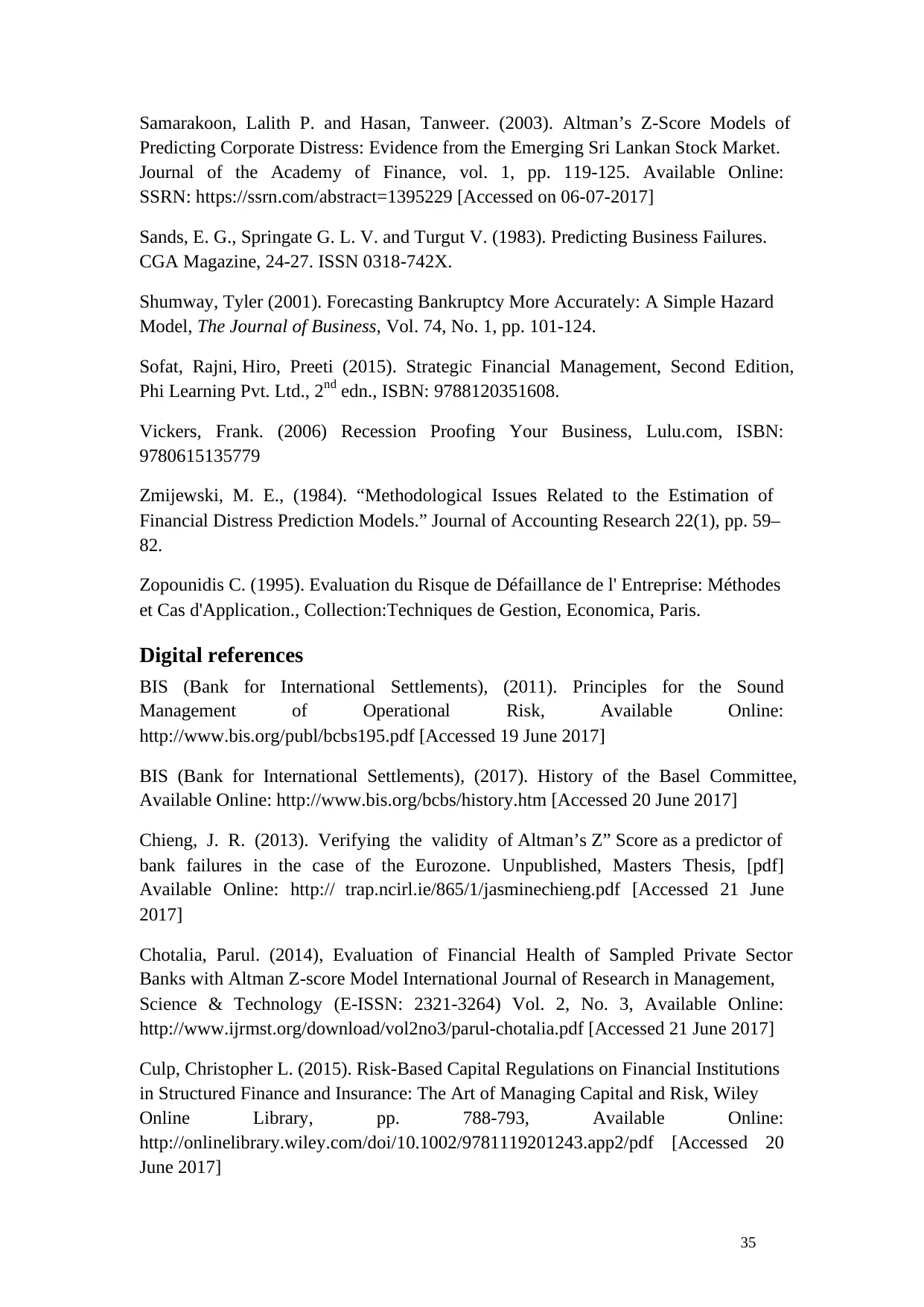
35
Samarakoon, Lalith P. and Hasan, Tanweer. (2003). Altman’s Z-Score Models of
Predicting Corporate Distress: Evidence from the Emerging Sri Lankan Stock Market.
Journal of the Academy of Finance, vol. 1, pp. 119-125. Available Online:
SSRN: https://ssrn.com/abstract=1395229 [Accessed on 06-07-2017]
Sands, E. G., Springate G. L. V. and Turgut V. (1983). Predicting Business Failures.
CGA Magazine, 24-27. ISSN 0318-742X.
Shumway, Tyler (2001). Forecasting Bankruptcy More Accurately: A Simple Hazard
Model, The Journal of Business, Vol. 74, No. 1, pp. 101-124.
Sofat, Rajni, Hiro, Preeti (2015). Strategic Financial Management, Second Edition,
Phi Learning Pvt. Ltd., 2nd edn., ISBN: 9788120351608.
Vickers, Frank. (2006) Recession Proofing Your Business, Lulu.com, ISBN:
9780615135779
Zmijewski, M. E., (1984). “Methodological Issues Related to the Estimation of
Financial Distress Prediction Models.” Journal of Accounting Research 22(1), pp. 59–
82.
Zopounidis C. (1995). Evaluation du Risque de Défaillance de l' Entreprise: Méthodes
et Cas d'Application., Collection:Techniques de Gestion, Economica, Paris.
Digital references
BIS (Bank for International Settlements), (2011). Principles for the Sound
Management of Operational Risk, Available Online:
http://www.bis.org/publ/bcbs195.pdf [Accessed 19 June 2017]
BIS (Bank for International Settlements), (2017). History of the Basel Committee,
Available Online: http://www.bis.org/bcbs/history.htm [Accessed 20 June 2017]
Chieng, J. R. (2013). Verifying the validity of Altman’s Z” Score as a predictor of
bank failures in the case of the Eurozone. Unpublished, Masters Thesis, [pdf]
Available Online: http:// trap.ncirl.ie/865/1/jasminechieng.pdf [Accessed 21 June
2017]
Chotalia, Parul. (2014), Evaluation of Financial Health of Sampled Private Sector
Banks with Altman Z-score Model International Journal of Research in Management,
Science & Technology (E-ISSN: 2321-3264) Vol. 2, No. 3, Available Online:
http://www.ijrmst.org/download/vol2no3/parul-chotalia.pdf [Accessed 21 June 2017]
Culp, Christopher L. (2015). Risk-Based Capital Regulations on Financial Institutions
in Structured Finance and Insurance: The Art of Managing Capital and Risk, Wiley
Online Library, pp. 788-793, Available Online:
http://onlinelibrary.wiley.com/doi/10.1002/9781119201243.app2/pdf [Accessed 20
June 2017]
Samarakoon, Lalith P. and Hasan, Tanweer. (2003). Altman’s Z-Score Models of
Predicting Corporate Distress: Evidence from the Emerging Sri Lankan Stock Market.
Journal of the Academy of Finance, vol. 1, pp. 119-125. Available Online:
SSRN: https://ssrn.com/abstract=1395229 [Accessed on 06-07-2017]
Sands, E. G., Springate G. L. V. and Turgut V. (1983). Predicting Business Failures.
CGA Magazine, 24-27. ISSN 0318-742X.
Shumway, Tyler (2001). Forecasting Bankruptcy More Accurately: A Simple Hazard
Model, The Journal of Business, Vol. 74, No. 1, pp. 101-124.
Sofat, Rajni, Hiro, Preeti (2015). Strategic Financial Management, Second Edition,
Phi Learning Pvt. Ltd., 2nd edn., ISBN: 9788120351608.
Vickers, Frank. (2006) Recession Proofing Your Business, Lulu.com, ISBN:
9780615135779
Zmijewski, M. E., (1984). “Methodological Issues Related to the Estimation of
Financial Distress Prediction Models.” Journal of Accounting Research 22(1), pp. 59–
82.
Zopounidis C. (1995). Evaluation du Risque de Défaillance de l' Entreprise: Méthodes
et Cas d'Application., Collection:Techniques de Gestion, Economica, Paris.
Digital references
BIS (Bank for International Settlements), (2011). Principles for the Sound
Management of Operational Risk, Available Online:
http://www.bis.org/publ/bcbs195.pdf [Accessed 19 June 2017]
BIS (Bank for International Settlements), (2017). History of the Basel Committee,
Available Online: http://www.bis.org/bcbs/history.htm [Accessed 20 June 2017]
Chieng, J. R. (2013). Verifying the validity of Altman’s Z” Score as a predictor of
bank failures in the case of the Eurozone. Unpublished, Masters Thesis, [pdf]
Available Online: http:// trap.ncirl.ie/865/1/jasminechieng.pdf [Accessed 21 June
2017]
Chotalia, Parul. (2014), Evaluation of Financial Health of Sampled Private Sector
Banks with Altman Z-score Model International Journal of Research in Management,
Science & Technology (E-ISSN: 2321-3264) Vol. 2, No. 3, Available Online:
http://www.ijrmst.org/download/vol2no3/parul-chotalia.pdf [Accessed 21 June 2017]
Culp, Christopher L. (2015). Risk-Based Capital Regulations on Financial Institutions
in Structured Finance and Insurance: The Art of Managing Capital and Risk, Wiley
Online Library, pp. 788-793, Available Online:
http://onlinelibrary.wiley.com/doi/10.1002/9781119201243.app2/pdf [Accessed 20
June 2017]

36
EBA (European Banking Authority), (2017). Available Online:
https://www.eba.europa.eu/regulation-and-policy/market-risk [Accessed 28 June
2017]
Eisenbeis, R. (1977). Pitfalls in the application of discriminant analysis in business,
finance and economics. Journal of Finance, 32, pp. 875–900.
http://dx.doi.org/10.1111/j.1540-6261.1977.tb01995.x
Muller, G.H., Steyn-Bruwer, B.W. and Hamman W.D. (2012). What is the best way
to predict financial distress of companies, Available Online:
http://www.usb.ac.za/thoughtprint/Pages/What-is-the-best-way-to-predict-financial-
distress-of-companies.aspx [Accessed 01 July 2017]
Stockopedia. (2017). I don't agree with the Altman Z-Score for company X?,
Available Online: http://ideas.stockopedia.com/knowledgebase/articles/132951-i-don-
t-agree-with-the-altman-z-score-for-company [Accessed 30 June 2017]
EBA (European Banking Authority), (2017). Available Online:
https://www.eba.europa.eu/regulation-and-policy/market-risk [Accessed 28 June
2017]
Eisenbeis, R. (1977). Pitfalls in the application of discriminant analysis in business,
finance and economics. Journal of Finance, 32, pp. 875–900.
http://dx.doi.org/10.1111/j.1540-6261.1977.tb01995.x
Muller, G.H., Steyn-Bruwer, B.W. and Hamman W.D. (2012). What is the best way
to predict financial distress of companies, Available Online:
http://www.usb.ac.za/thoughtprint/Pages/What-is-the-best-way-to-predict-financial-
distress-of-companies.aspx [Accessed 01 July 2017]
Stockopedia. (2017). I don't agree with the Altman Z-Score for company X?,
Available Online: http://ideas.stockopedia.com/knowledgebase/articles/132951-i-don-
t-agree-with-the-altman-z-score-for-company [Accessed 30 June 2017]
Secure Best Marks with AI Grader
Need help grading? Try our AI Grader for instant feedback on your assignments.
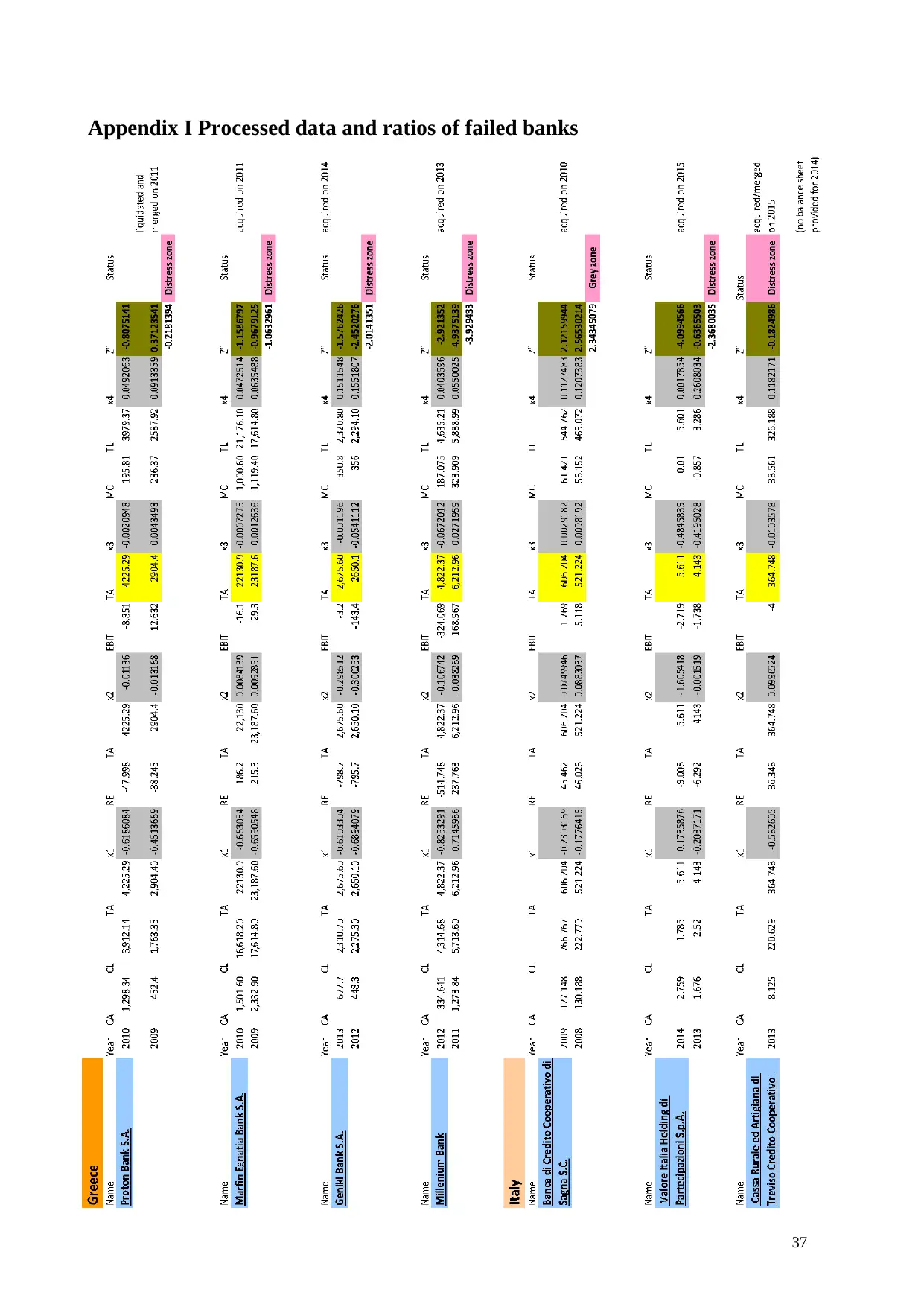
37
Appendix I Processed data and ratios of failed banks
Appendix I Processed data and ratios of failed banks

38

39
Paraphrase This Document
Need a fresh take? Get an instant paraphrase of this document with our AI Paraphraser
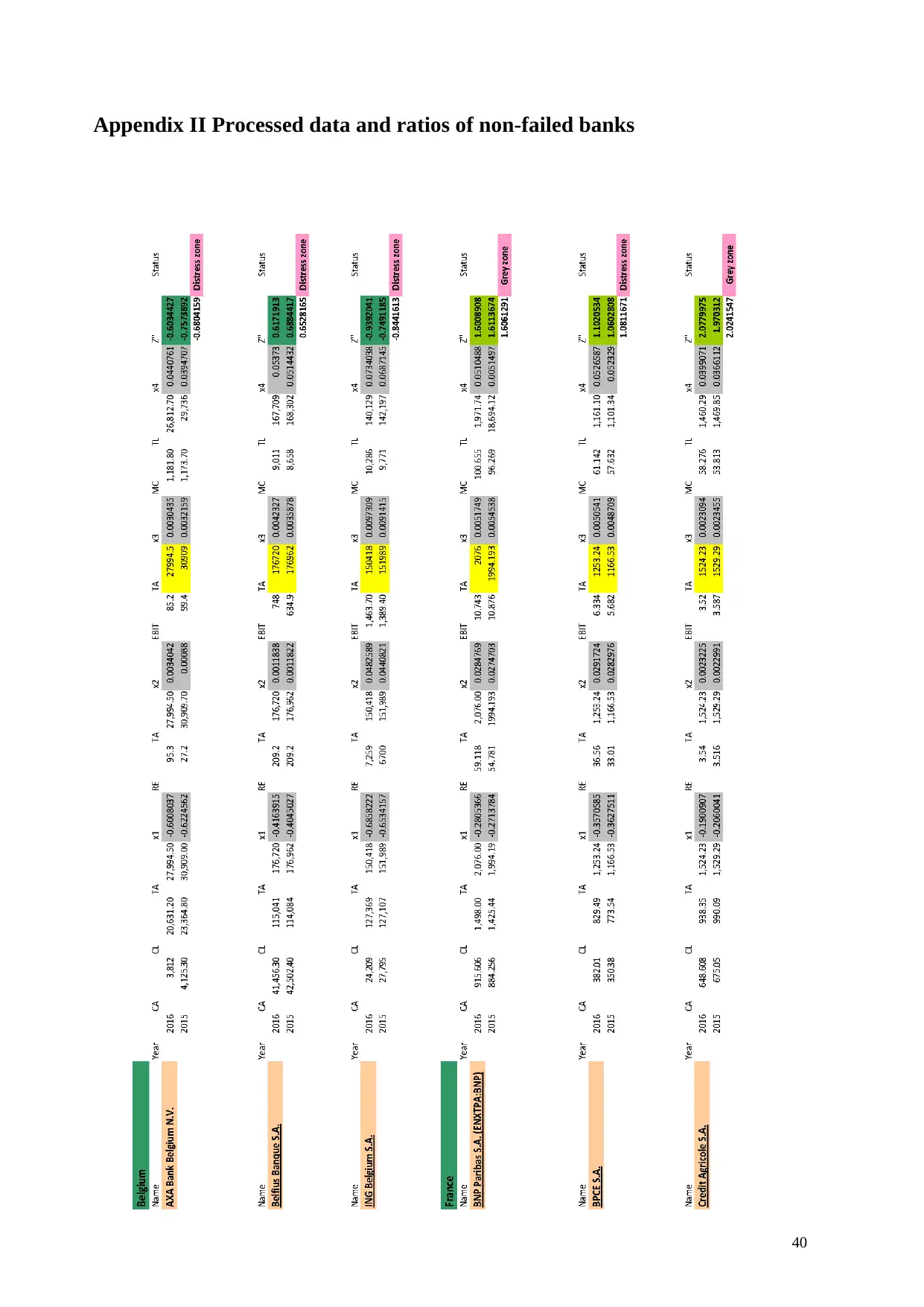
40
Appendix II Processed data and ratios of non-failed banks
Appendix II Processed data and ratios of non-failed banks
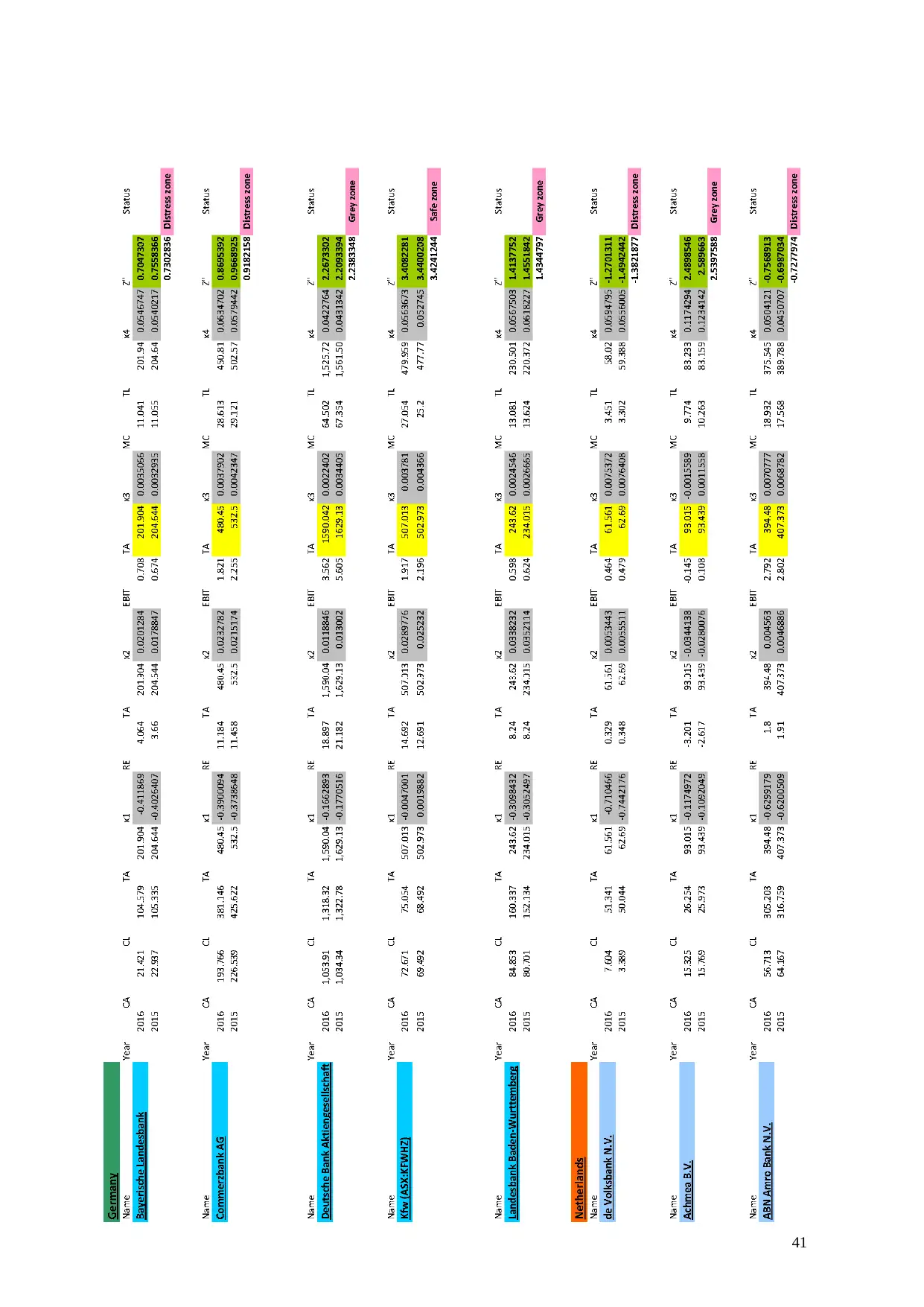
41

42
1 out of 46
Your All-in-One AI-Powered Toolkit for Academic Success.
+13062052269
info@desklib.com
Available 24*7 on WhatsApp / Email
![[object Object]](/_next/static/media/star-bottom.7253800d.svg)
Unlock your academic potential
© 2024 | Zucol Services PVT LTD | All rights reserved.


